INMUSIC ZR15 Wireless Camera-Mount Transmitter User Manual PMD 750T part1
INMUSIC BRANDS INC Wireless Camera-Mount Transmitter PMD 750T part1
INMUSIC >
Users Manual

PMD-750T
User Guide English (3–9)
Guía del usuario Español (10–16)
Guide d’utilisation Français (17–23)
Guida per l’uso Italiano (24–30)
Benutzerhandbuch Deutsch (31–37)
Appendix English (38)

2

3
User Guide (English)
Introduction
Box Contents
PMD-750T Transmitter
Lavalier Condenser Mic
Foam Windscreen
Synthetic Fur Windscreen
User Guide
Safety & Warranty Manual
Support
For the latest information about this product (documentation,
technical specifications, system requirements, compatibility
information, etc.) and product registration, visit marantzpro.com.
For additional product support, visit marantzpro.com/support.
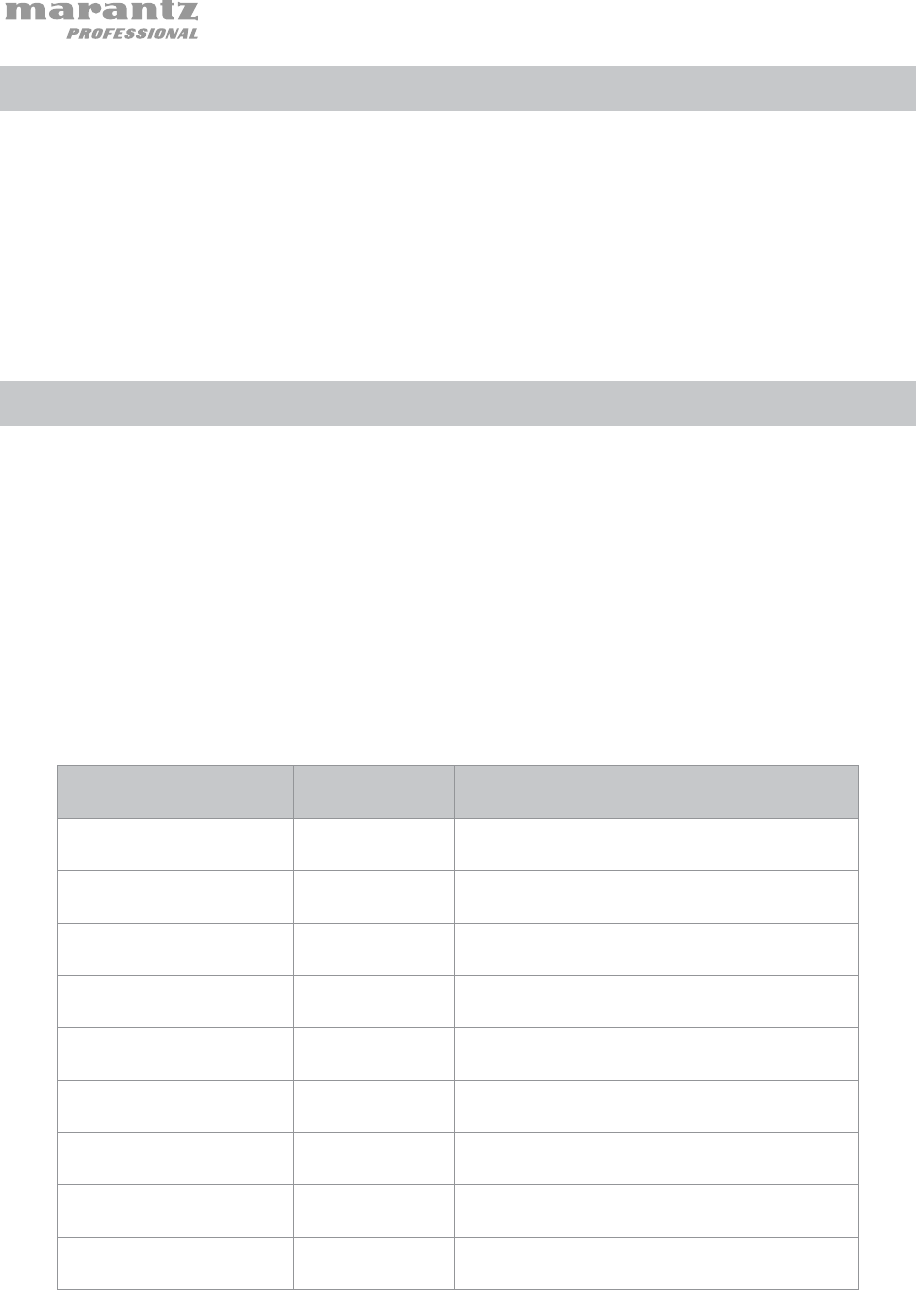
4
Important Safety Precautions
Please note: Marantz Professional and inMusic are not responsible
for the use of its products or the misuse of this information for any
purpose. Marantz and inMusic are not responsible for the misuse of
its products caused by avoiding compliance with inspection and
maintenance procedures. Please also refer to the included safety
and warranty manual for more information.
Sound Level
Permanent hearing loss may be caused by exposure to extremely
high noise levels. The U.S. Occupational Safety and Health
Administration (OSHA) has specified permissible exposures to
certain noise levels. According to OSHA, exposure to high sound
pressure levels (SPL) in excess of these limits may result in hearing
loss. When using equipment capable of generating high SPL, use
hearing protection while such equipment is under operation.
Hours per day SPL (dB) Example
8 90 Small gig
6 92 Train
4 95 Subway train
3 97 High level desktop monitors
2 100 Classical music concert
1.5 102 Riveting machine
1 105 Machine factory
0.50 110 Airport
0.25 or less 115 Rock concert
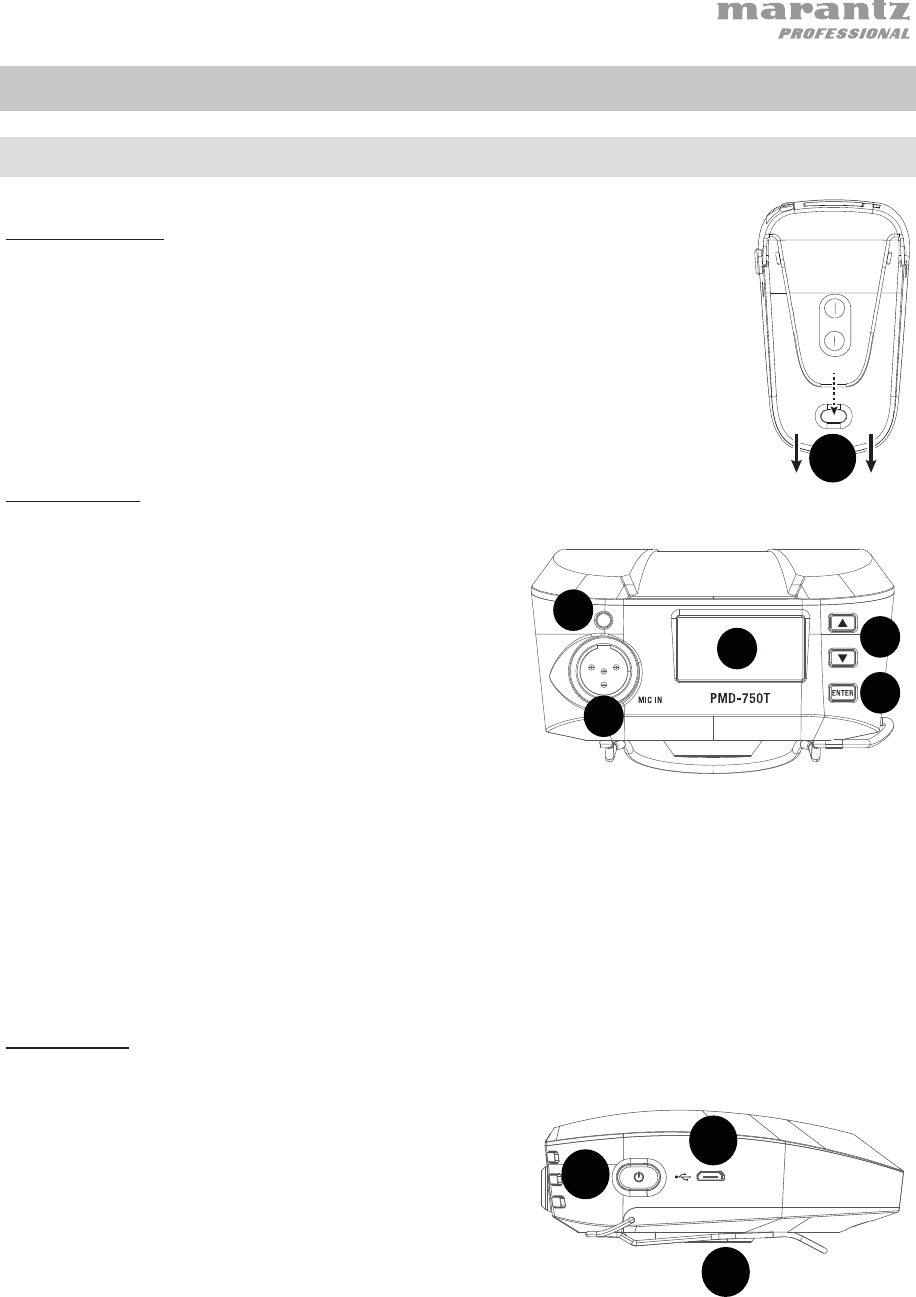
5
Features
Transmitter
Bottom Panel
1. Battery Compartment: Insert (2) AA batteries here (not
included). Alkaline batteries are recommended; always
replace both batteries. Do not mix battery types.
Front Panel
1. Display: The display will show the
channel that the unit is
communicating on, pairing status, and
battery level meter.
2. Pair LED: The LED will blink red when
the transmitter is muted. The LED will
blink blue when it is searching to pair
to the receiver. The LED will be lit
solid blue when it is paired to the
receiver.
3. Navigation Buttons: Press these buttons to change which sections of the
display are highlighted.
4. Enter Button: Press this button to navigate to a menu/submenu selection or
confirm a specific function.
5. Mic Input: Connect the included mini-XLR lavalier condenser microphone
here.
Side Panel
1. Micro USB Port: Connect a USB
power adapter (sold separately) here
to power the unit if not using 2 AA
batteries.
2. Power On/Off: Press and hold this
button to power the unit on/off.
3. Belt Clip: Attach this clip to secure to
a belt loop or pocket.
1
2
3
4
5
1
2
1
3
1
2
3
4
5
1
2
1
3
1
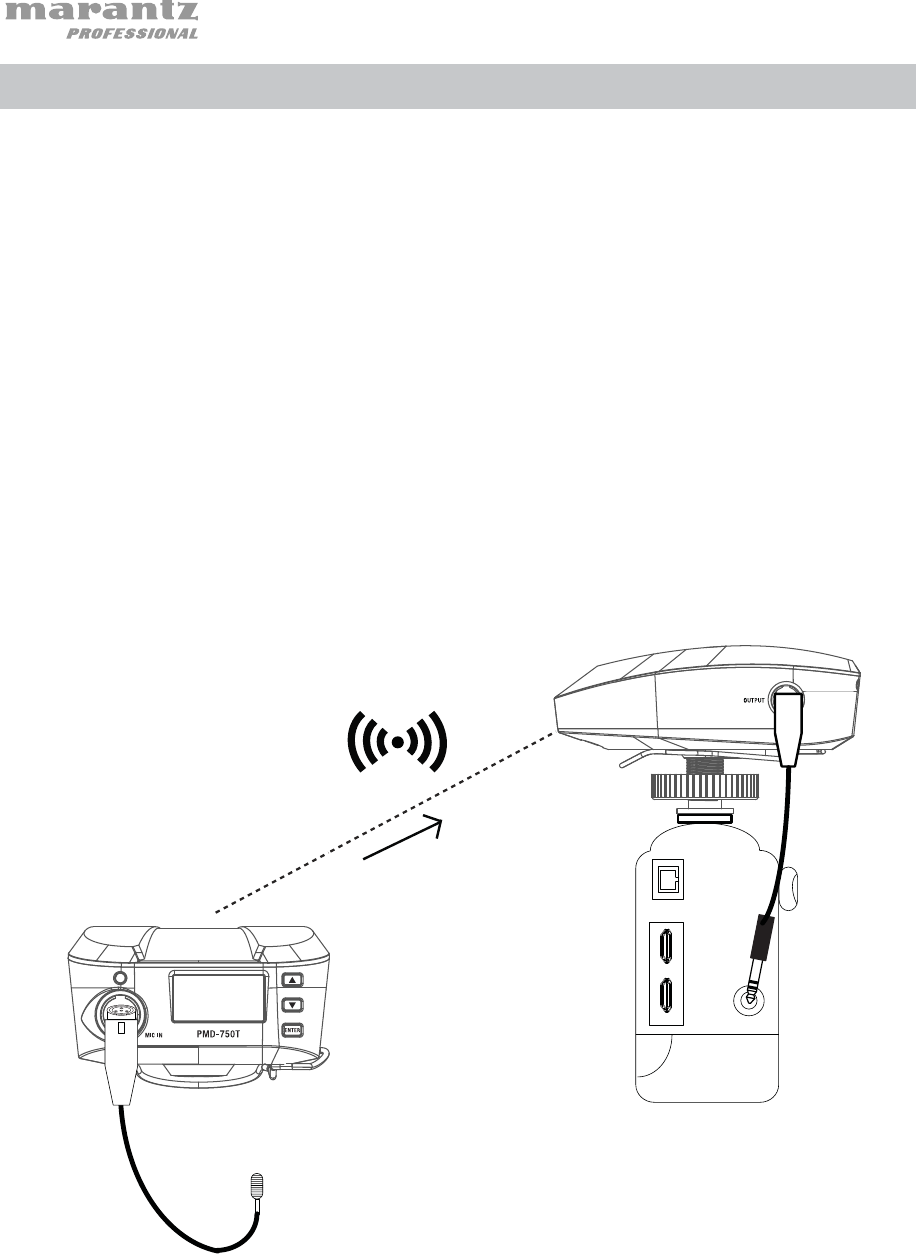
6
Setup
Items not listed under Introduction > Box Contents are sold separately.
Example 1 – Mono Operation
To send a mono signal from a single transmitter to the receiver:
1. Connect your microphone to the mic input on the transmitter, and connect the
receiver’s audio output to your camera’s external mic input. Keep the volume
controls on the camera at its minimum settings.
2. If necessary, adjust the RF dB level on the transmitter
to get a strong signal for
better operating range and noise resistance.
3. Turn on your camera, adjust the RX output level on the receiver and the input level
of the camera’s external mic input to hear the audio signal (or view the level on the
input level of the camera).
4. In the audio recording settings on your camera, make sure it is set to Manual rather
than Auto. Check the input level meter, and adjust the level so that the loudest
sounds peak around -12 dB. Make sure the sound does not exceed 0 dB, which will
cause the signal to distort.
Receiver
Transmitter Camera
Mic
Input
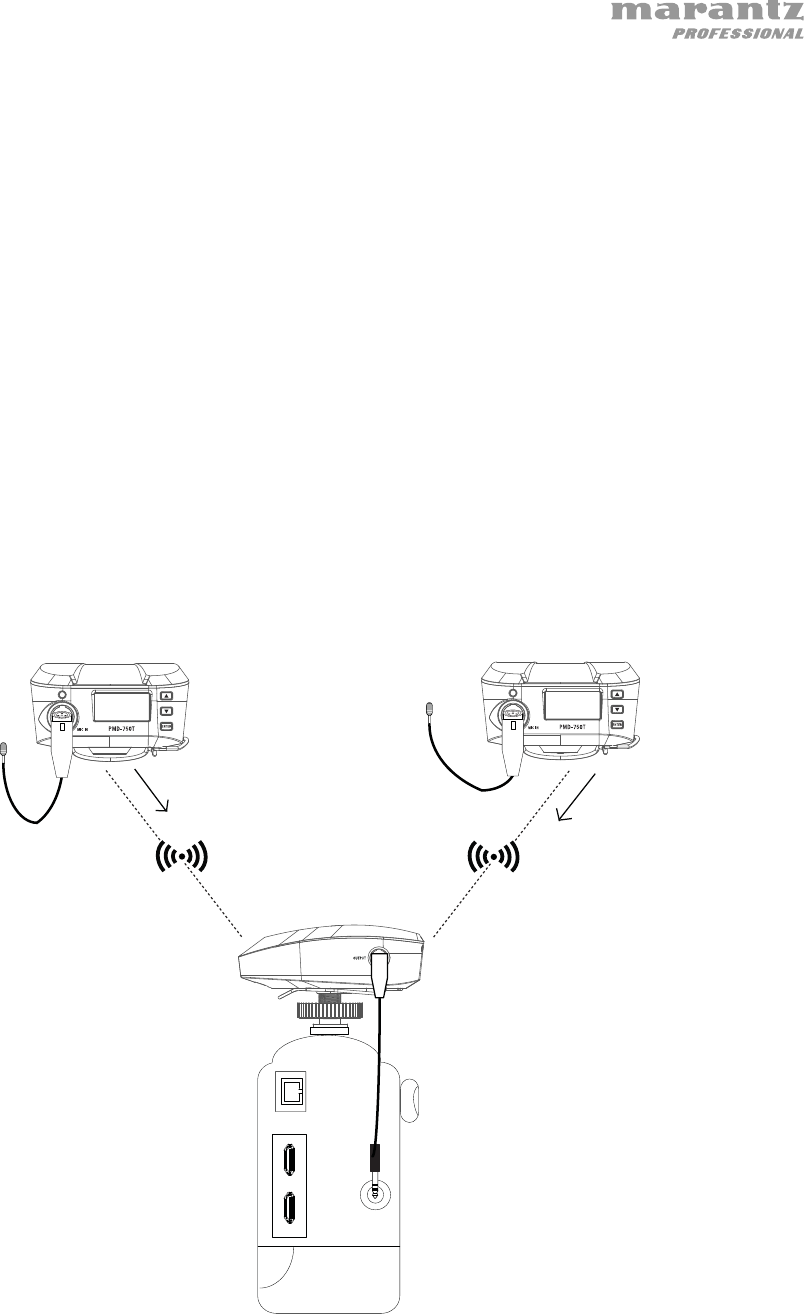
7
Example 2 – Stereo Operation
To send a stereo signal from 2 transmitters to the receiver:
1. Connect your microphones to the mic inputs on the transmitters, and connect the
receiver’s audio output to your camera’s external mic input. Keep the volume
controls on the camera at its minimum settings.
2. If necessary, adjust the RF dB level on the transmitter
to get a strong signal for
better operating range and noise resistance.
3. Turn on your camera, adjust the RX output level on the receiver, and the input
level of the camera’s external mic input to hear the audio signal (or view the level
on the input level of the camera).
4. In the audio recording settings on your camera, make sure it is set to Manual
rather than Auto. Check the input level meter, and adjust the level so that the
loudest sounds peak around -12 dB. Make sure the sound does not exceed 0 dB,
which will cause the signal to distort.
5. Set the receiver’s Output menu to Stereo and adjust the output level to get a
strong signal without clipping.
Receiver
Transmitter
Camera Mic Input
Transmitter
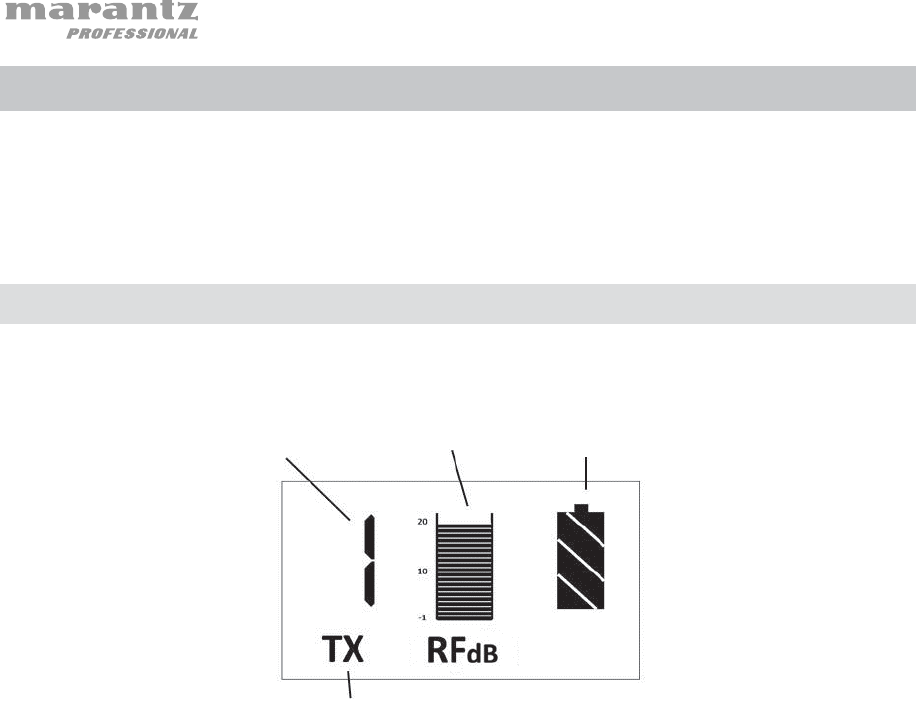
8
Operation
To set up and use your PMD-750T, follow the steps in the Pairing the
Transmitter and Receiver chapter in order. If you are setting up a system
using two transmitters, set up each transmitter one at a time, and keep each
transmitter powered on as you set up the additional unit.
Transmitter Menu
Display:
Main Menu:
• Mute/unmute the transmitter by quickly pressing and releasing
the Power button.
Pairing Mode:
• Press the navigation buttons to move the cursor to the TX icon.
Once TX is highlighted, the icon will display PAIR. Press Enter to
go into pairing mode and the icon will flash to wait for the
receiver to pair. Once paired, the icon will be lit solid.
RF Level:
• Press and release the Enter button on the receiver to highlight
the meter and use the navigation buttons to adjust the RF
power. The default setting is 10 dBm. You can set this to: -1, 3,
5, 8, 10, 12, 14, 16, 20 dBm.
The number of paired
transmitters (in the
order that they were
paired)
RF Power Setting
Transmitter Battery
Level
Transmitter/Pairin
g
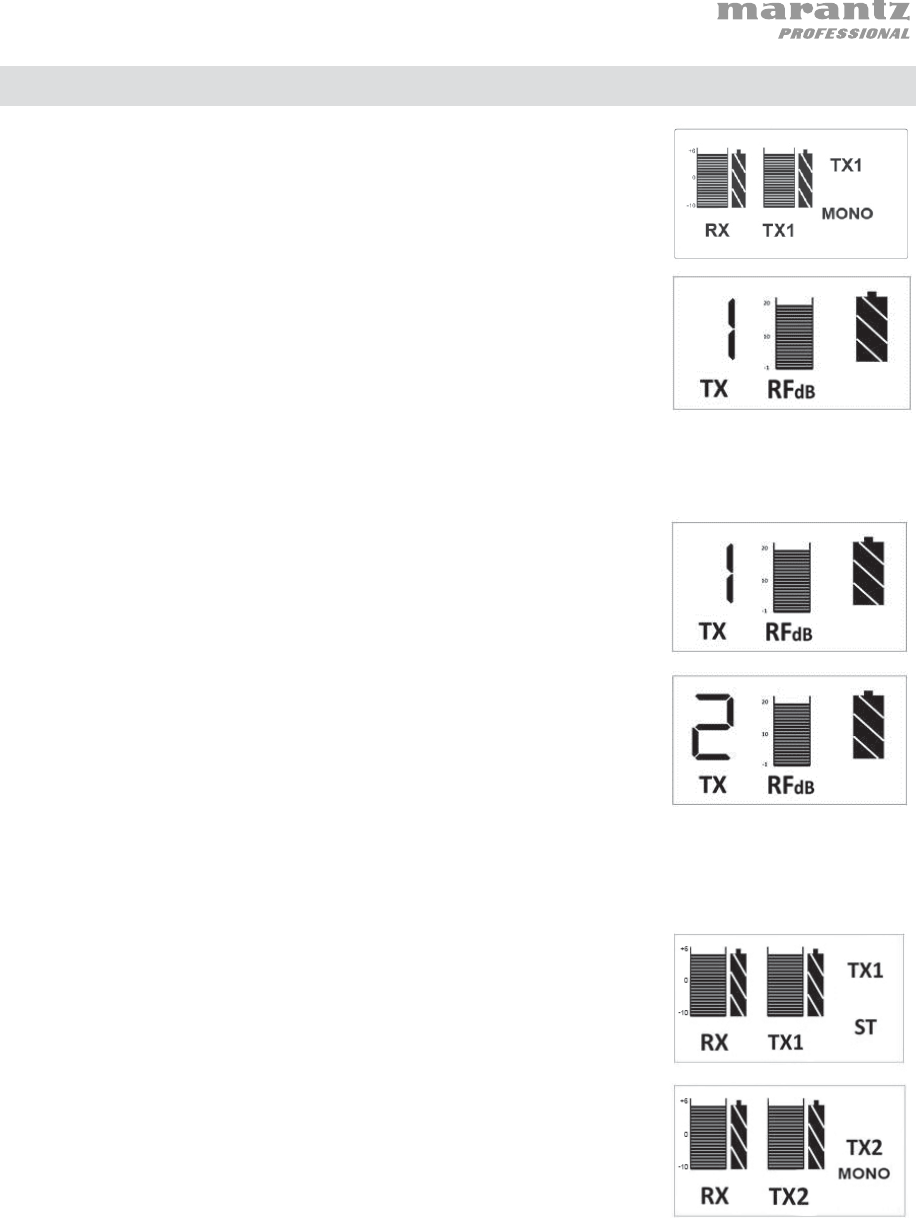
9
Pairing the Transmitter and Receiver
Pairing 1 transmitter with the receiver (automatic):
1. Turn on the receiver and it will enter pairing mode.
2. Turn on the transmitter and it will automatically pair
with the receiver.
Pairing 2 transmitters with the receiver (automatic):
1. Turn on the receiver and it will enter pairing mode.
2. Turn on the transmitters and they will enter pairing
mode. The first transmitter will automatically pair with
the receiver.
3. Once Transmitter 1 is paired, Transmitter 2 will pair to
the receiver. When Transmitter 2 is paired to the
receiver, the transmitter display will show “2 TX”.
4. The receiver display will show "Mono" or "Stereo".
Press Enter to select it and use the navigation
buttons to switch between "Mono" and "Stereo".
Press Enter to confirm the choice.
Pairing 1 or 2 transmitters to the receiver (manual):
1. Turn on the receiver and transmitter(s).
2. Press the navigation buttons to move the cursor to
the TX icon. Once TX is highlighted, the icon will
display PAIR. On the transmitter(s), press Enter to go
into pairing mode and the icon will flash to wait for the
receiver to pair. Once paired, the icon will be lit solid.
3. The receiver display will show "Mono" or "Stereo".
Press Enter to select it and use the navigation buttons
to switch between "Mono" and "Stereo". Press Enter to
confirm the choice.
Note: The Output mode is automatically set to “Mono”
when only one transmitter is paired.

10
Guía del usuario (Español)
Introducción
Contenido de la caja
Transmisor PMD-750T
Micrófono condensador de corbata
Paraviento de espuma de polietileno
Paraviento de piel sintética
Guía del usuario
Manual sobre la seguridad y garantía
Soporte
Para obtener la información más reciente acerca de este producto
(documentación, especificaciones técnicas, requisitos de sistema,
información de compatibilidad, etc.) y registrarlo, visite marantzpro.com.
Para obtener soporte adicional del producto, visite marantzpro.com/support.

11
Precauciones importantes para la seguridad
Para tener en cuenta: Marantz Professional e inMusic no son responsables
por el uso de sus productos o el mal uso de esta información para cualquier
propósito. Marantz e inMusic no son responsables del mal uso de sus
productos causados por la omisión del cumplimiento de los procedimientos
de inspección y mantenimiento. Para más información, consulte también el
manual de seguridad y garantía incluido.
Nivel de sonido
La exposición a niveles muy altos de ruido puede causar pérdidas auditivas
permanentes. La Administración de Seguridad y Salud Ocupacional de
EE.UU. (OSHA) ha especificado los niveles de exposición permisibles a
ciertos niveles de ruido. Según la OSHA, la exposición a niveles de presión
sonora (SPL) elevados que excedan estos límites puede causar pérdidas
auditivas. Cuando utilice equipos capaces de generar SPL elevados, use
protecciones auditivas mientras dichos equipos están en funcionamiento.
Horas diarias SPL (dB) Ejemplo
8 90 Música de bajo volumen
6 92 Tren
4 95 Tren subterráneo
3 97 Monitores de escritorio de alto nivel
2 100 Concierto de música clásica
1,5 102 Remachadora
1 105 Máquina fabril
0,50 110 Aeropuerto
0,25 o menos 115 Concierto de rock
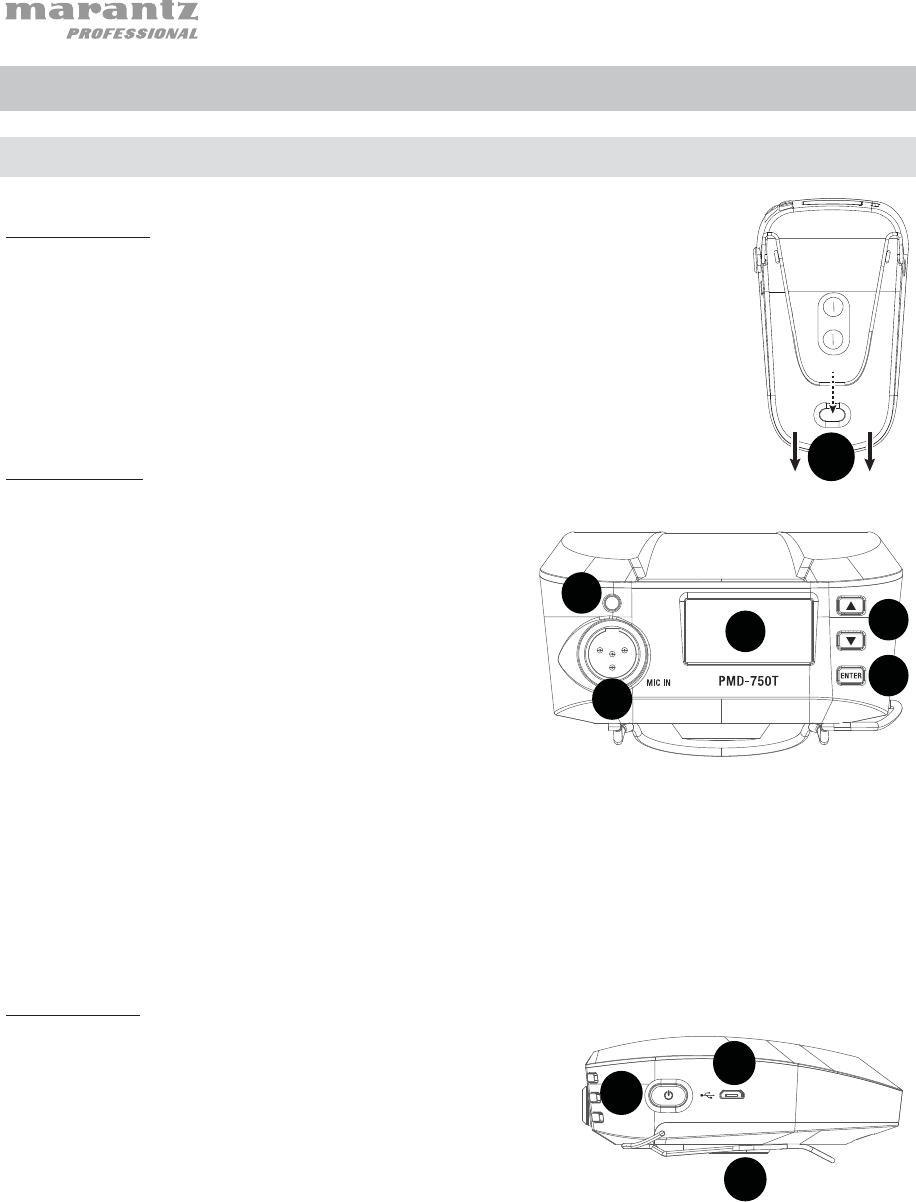
12
Características
Transmisor
Panel trasero
1. Compartimiento para pilas: Inserte aquí (2) pilas AA (no
incluidas). Se recomiendan pilas alcalinas; siempre reemplace
ambas pilas. No mezcle pilas de diferentes tipos.
Panel frontal
1. Pantalla: La pantalla mostrará el canal a
través del cual se está comunicando la
unidad, el estado de apareamiento y el
indicador de nivel de las pilas.
2. LED Pair: El LED parpadeará con luz roja
si el transmisor está silenciado.
Parpadeará con luz azul cuando esté
buscando el receptor para aparearse. El
LED se iluminará de color azul
permanentemente cuando esté apareado
con el receptor.
3. Botones de navegación: Pulse estos botones para cambiar las secciones que se
resaltan en la pantalla.
4. Botón Enter: Pulse este botón para navegar a la selección de un menú/submenú
o confirmar una función específica.
5. Entrada para micrófono: Conecte aquí el cable mini-XLR del micrófono
condensador de corbata.
Panel lateral
1. Puerto micro USB: Conecte aquí un
adaptador de alimentación USB (se vende
por separado) para suministrar corriente a la
unidad si no está utilizando las 2 pilas AA.
2. Encendido/apagado: Mantenga pulsado
este botón para encender y apagar la unidad.
3. Presilla para cinturón: Añada este clip para
sujetarlo de una hebilla del cinturón o bolsillo.
1
2
3
4
5
1
2
1
3
1
2
3
4
5
1
2
1
3
1
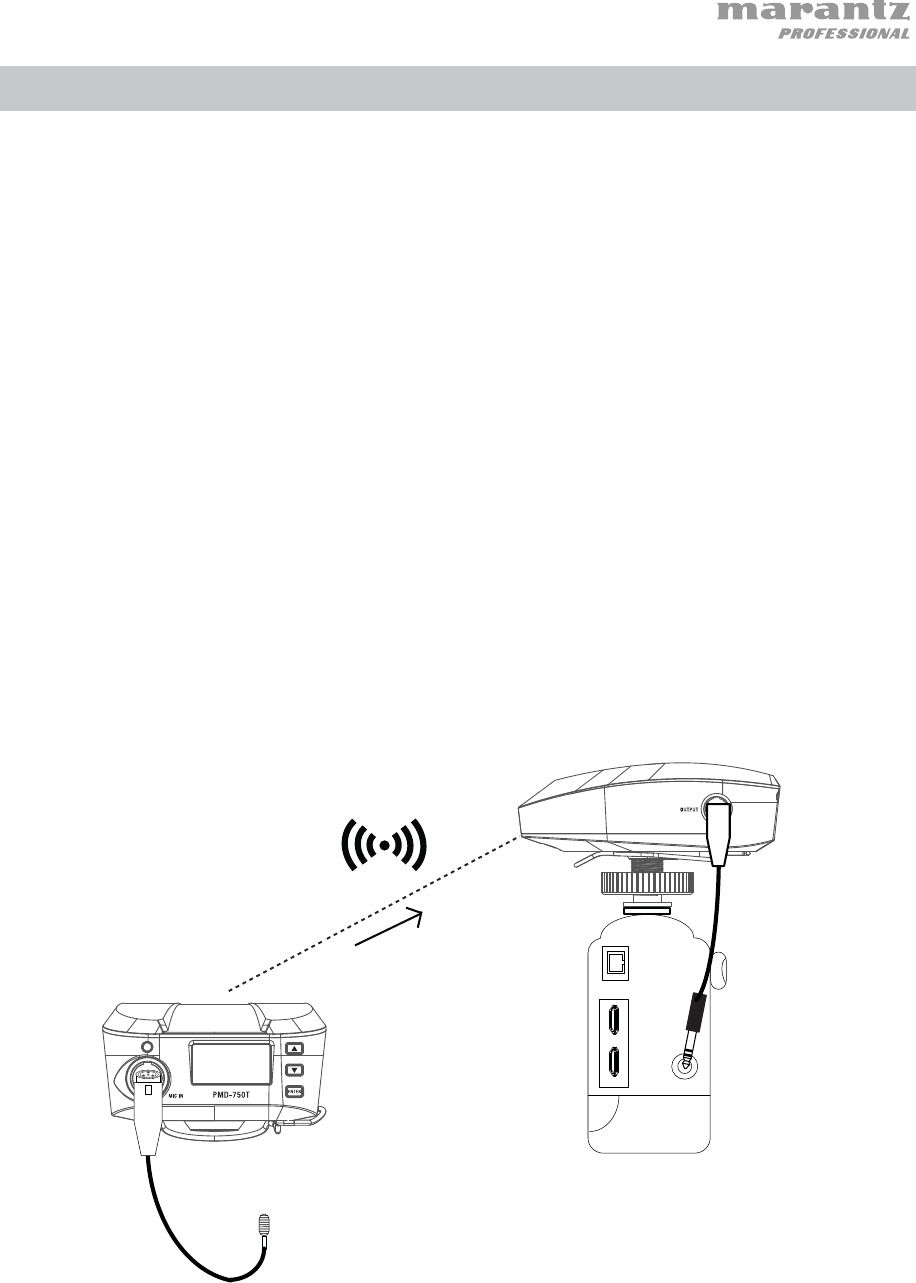
13
Instalación
Los elementos que no se enumeran en Introducción > Contenido de la caja se venden
por separado.
Ejemplo 1 – Funcionamiento en mono
Cómo enviar una señal mono desde un transmisor individual al receptor:
1. Conecte su micrófono a la entrada mic del transmisor y conecte la salida de audio
output del receptor a la entrada para micrófono externo de su cámara. Mantenga
los controles de volumen de la cámara en sus ajustes mínimos.
2. De ser necesario, ajuste el nivel de RF dB en el transmisor para obtener una señal
fuerte y lograr un mayor alcance de funcionamiento y resistencia al ruido.
3. Encienda su cámara, ajuste el nivel de la salida RX del receptor y el nivel de la
entrada para micrófono externo de la cámara a fin de poder escuchar la señal de
audio (u observar el nivel en el nivel de entrada de la cámara).
4. En los ajustes de grabación de audio de su cámara, asegúrese de que esté ajustada
en Manual en lugar de Auto. Compruebe el medidor de nivel de entrada y ajústelo
de manera que los sonidos más fuertes no superen los -12 dB. Asegúrese de que el
sonido no exceda los 0 dB, lo cual distorsionará la señal.
Receptor
Transmisor
Cámara
Micrófono
Entrada
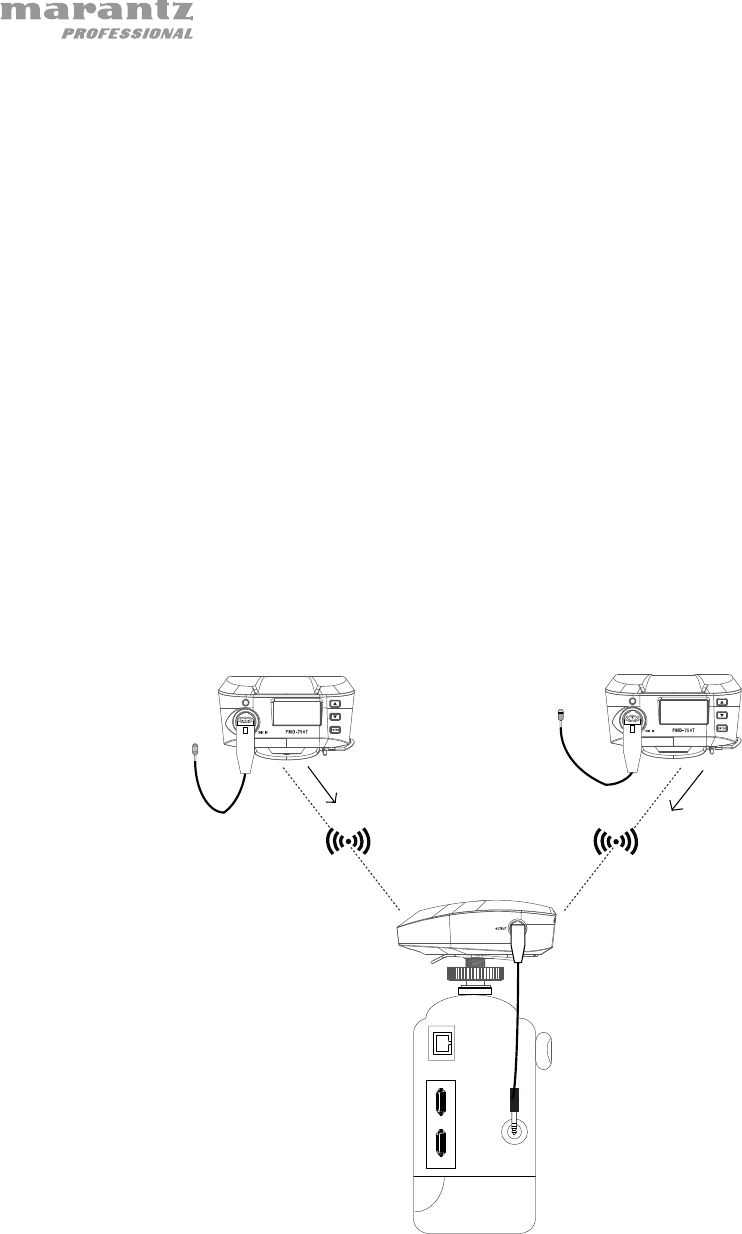
14
Ejemplo 2 – Funcionamiento en estéreo
Cómo enviar una señal estéreo desde 2 transmisores al receptor:
1. Conecte sus micrófonos a la entradas mic de los transmisores y conecte la
salida de audio output del receptor a la entrada para micrófono externo de su
cámara. Mantenga los controles de volumen de la cámara en sus ajustes mínimos.
2. De ser necesario, ajuste el nivel de RF dB en el transmisor para obtener una señal
fuerte y lograr un mayor alcance de funcionamiento y resistencia al ruido.
3. Encienda su cámara, ajuste el nivel de la salida RX del receptor y el nivel de la
entrada para micrófono externo de la cámara a fin de poder escuchar la señal de
audio (u observar el nivel en el nivel de entrada de la cámara).
4. En los ajustes de grabación de audio de su cámara, asegúrese de que esté
ajustada en Manual en lugar de Auto. Compruebe el medidor de nivel de entrada
y ajústelo de manera que los sonidos más fuertes no superen los -12 dB.
Asegúrese de que el sonido no exceda los 0 dB, lo cual distorsionará la señal.
5. Coloque el menú de salida del receptor en Stereo y ajuste el nivel de salida para
obtener una señal intensa sin recorte.
Receptor
T
ransmisor
Entrada para
micrófono de la
cámara
Transmisor
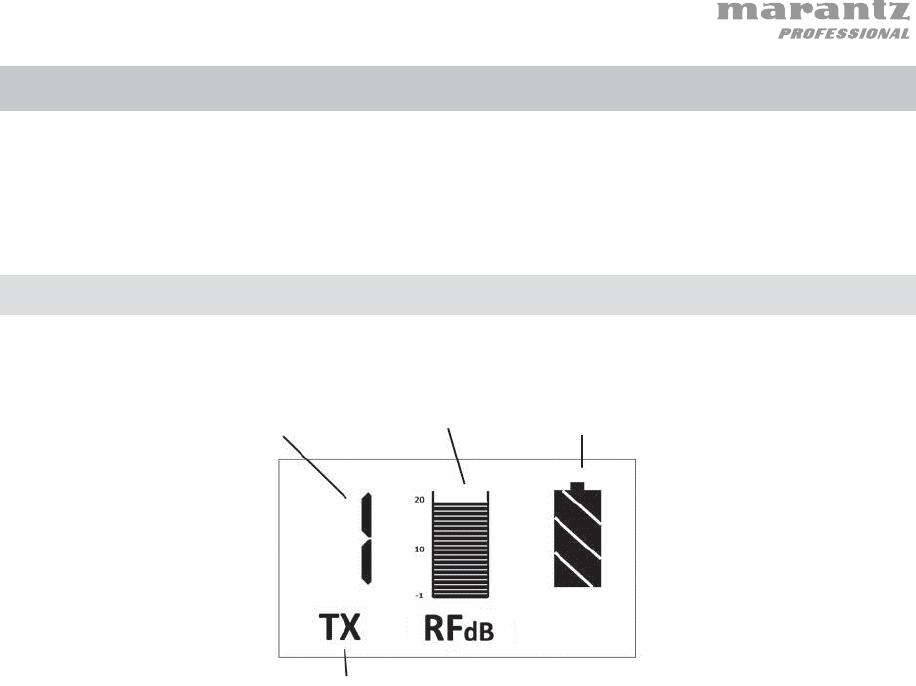
15
Funcionamiento
Para configurar y utilizar su PMD-750T, siga los pasos en el capítulo Apareamiento del
transmisor y receptor en orden. Si está instalando un sistema con dos transmisores,
instale cada transmisor de a uno a la vez y mantenga cada transmisor encendido a
medida que instala la unidad adicional.
Menú del transmisor
Menú principal:
• Silencie/anule el silenciamiento del transmisor pulsando y soltando
rápidamente el botón Power.
Modo de apareamiento:
• Pulse los botones de navegación para mover el cursor hasta el icono TX.
Una vez que TX esté resaltado, el icono mostrará PAIR. Pulse Enter para
entrar en modo de apareamiento y el icono parpadeará mientras espera
que el receptor se aparee. Una vez apareado, el icono quedará encendido
permanentemente.
Nivel de RF:
• Mantenga pulsado el botón Enter en el receptor para resaltar el medidor y
utilizar los botones de navegación para ajustar la potencia de RF. El valor
predeterminado es 10 dBM. Puede ajustarla en: -1, 3, 5, 8, 10, 12, 14, 16,
20 dBm.
La cantidad de
transmisores
apareados (en el orden
en el que se aparearon)
Ajuste de
potencia
de RF
Nivel de la pila del
transmisor
Transmisor/apareamiento
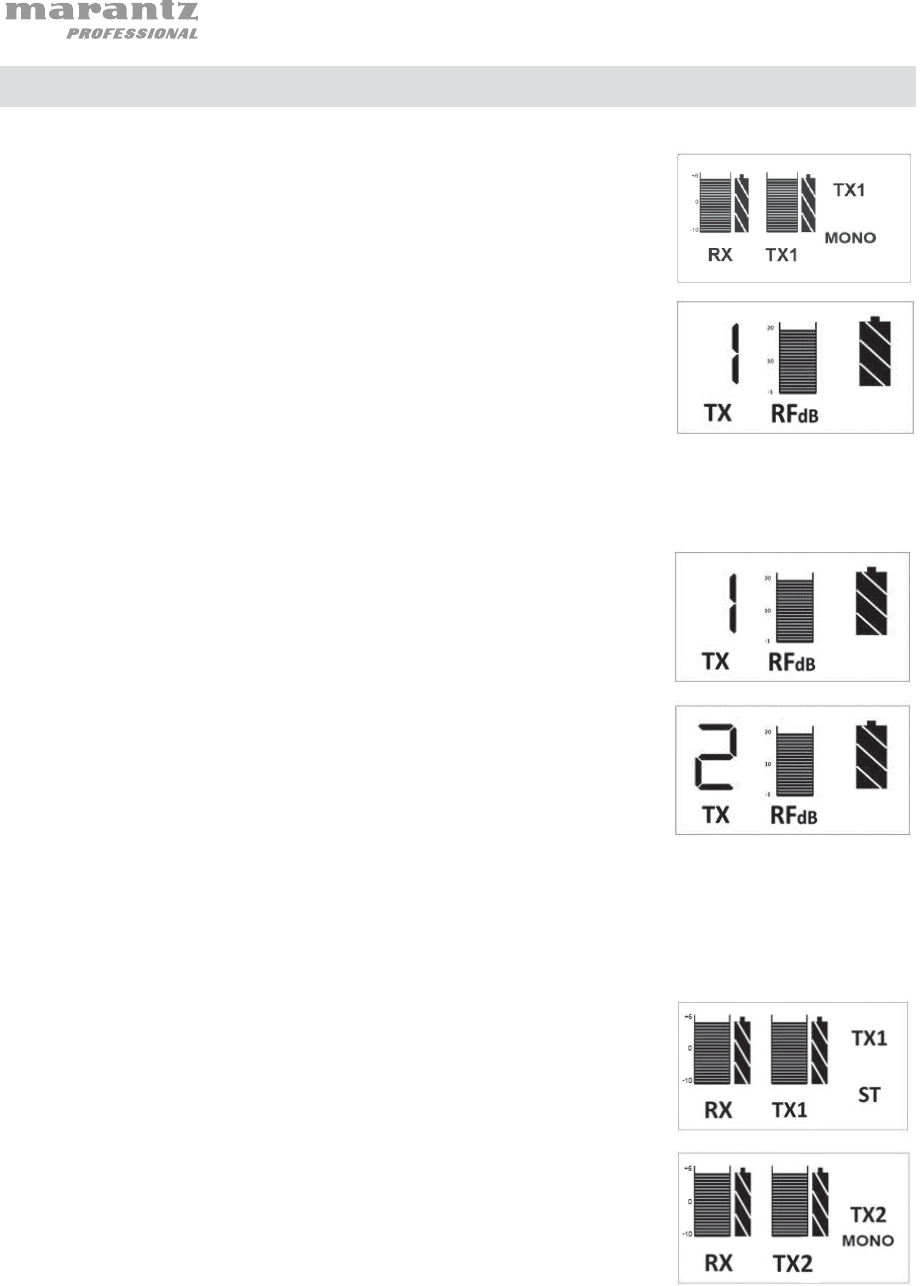
16
Apareamiento del transmisor y receptor
Apareamiento de 1 transmisor con el receptor
(automático):
1. Encienda el receptor y entrará en modo de
apareamiento.
2. Encienda el transmisor y se apareará automáticamente
con el receptor.
Apareamiento de 2 transmisores con el receptor (automático):
1. Encienda el receptor y entrará en modo de
apareamiento.
2. Encienda los transmisores y entrarán en modo de
apareamiento. El primer transmisor se apareará
automáticamente con el receptor.
3. Una vez apareado el transmisor 1, el transmisor 2 se
apareará con el receptor. Cuando el transmisor 2 se
aparea con el receptor, aparecerá “2 TX” en la pantalla
del transmisor.
4. La pantalla del receptor mostrará “Mono” o “Stereo”.
Pulse Enter para seleccionarlo y utilice los botones de
navegación para conmutar entre “Mono” y “Stereo”.
Pulse Enter para confirmar su selección.
Apareamiento de 1 o 2 transmisores con el receptor (manual):
1. Encienda el receptor y el/los transmisor(es).
2. Pulse los botones de navegación para mover el cursor
hasta el icono TX. Una vez que TX esté resaltado, el
icono mostrará PAIR. Pulse Enter en el/los
transmisor(es) para entrar en modo de apareamiento y
el icono parpadeará mientras espera que el receptor se
aparee. Una vez apareado, el icono quedará encendido
permanentemente.
Nota: El modo de salida se ajusta automáticamente a
“Mono” cuando sólo se apalea un transmisor.

17
Guide d’utilisation (Français)
Présentation
Contenu de la boîte
Émetteur PMD-750T
Micro-boutonnière à condensateur
Écran antivent en mousse
Écran en fourrure synthétique
Guide d’utilisation
Consignes de sécurité et informations concernant la garantie
Assistance technique
Pour les toutes dernières informations concernant la documentation, les
spécifications techniques, la configuration requise, la compatibilité et
l’enregistrement du produit, veuillez visiter marantzpro.com.
Pour de l’assistance supplémentaire, veuillez visiter le site
marantzpro.com/support.
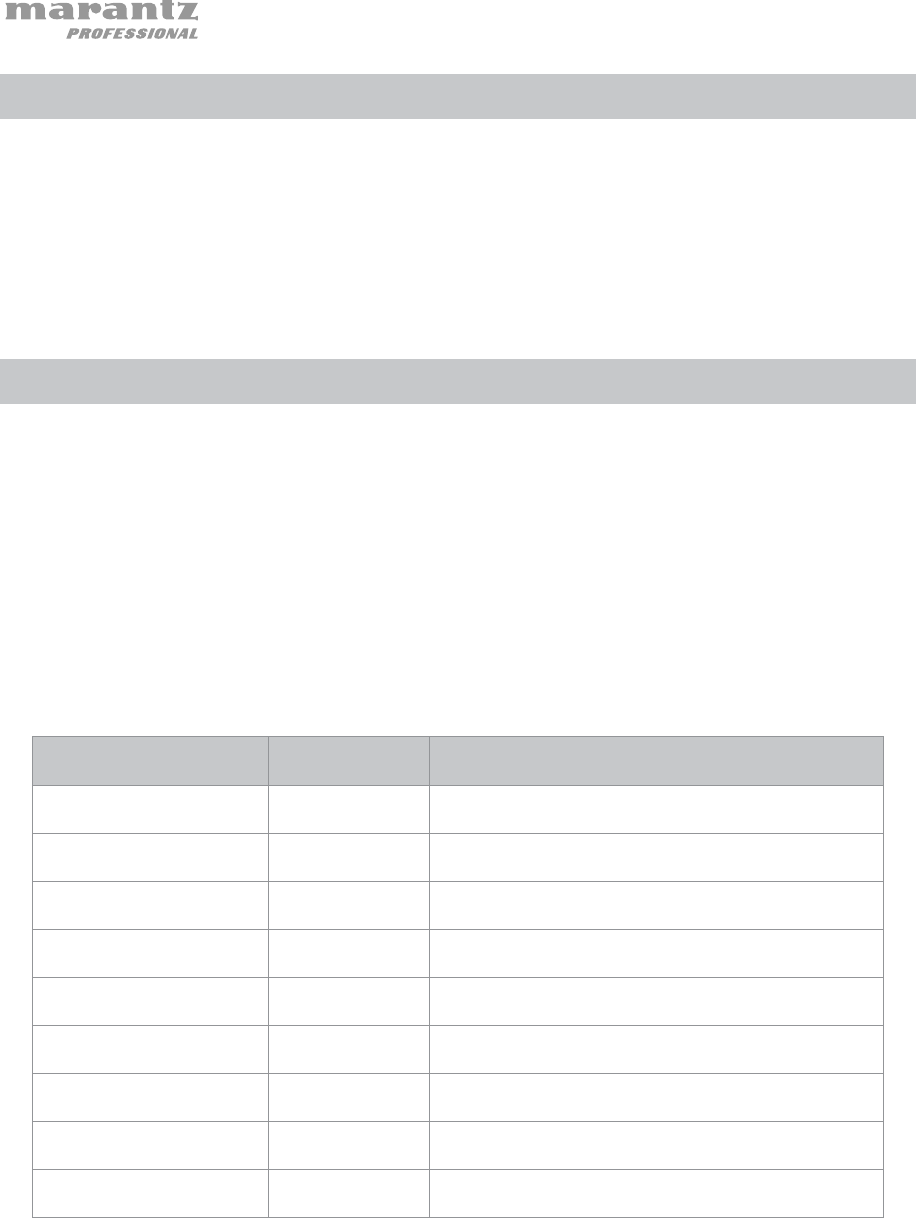
18
Consignes de sécurité importantes
Veuillez noter : Marantz Professional et inMusic ne sont pas responsables de
la mauvaise utilisation de leurs produits ou de l’utilisation faite de ces
informations. Marantz et inMusic ne sont pas responsables de la mauvaise
utilisation de leurs produits causés par le non-respect des procédures
d’entretien et d’inspection. Veuillez également consulter le guide des
consignes de sécurité et informations concernant la garantie inclus.
Niveau sonore
L’exposition aux niveaux extrêmement élevés de bruit peut causer une perte
d’audition permanente. Le comité de santé et de sécurité au travail des
États-Unis (OSHA) a établi des durées d’exposition acceptables pour
certains niveaux de bruit. Selon la OSHA, une exposition à des niveaux de
pression acoustique (NPA) au-dessus de ces limites peut avoir comme
conséquence une perte d’audition. Lors de l’utilisation d’équipement
capable de générer des niveaux de pression acoustique élevés, il faut
prendre des mesures afin de protéger son ouïe lorsque cette unité est en
fonction.
Heures par jour NPA (dB) Exemple
8 90 Petite salle de spectacle
6 92 Train
4 95 Rame de métro
3 97 Moniteurs de table à niveaux élevés
2 100 Concert de musique classique
1,5 102 Riveteuse
1 105 Usine de fabrication
0,50 110 Aéroport
0,25 ou moins 115 Concert rock
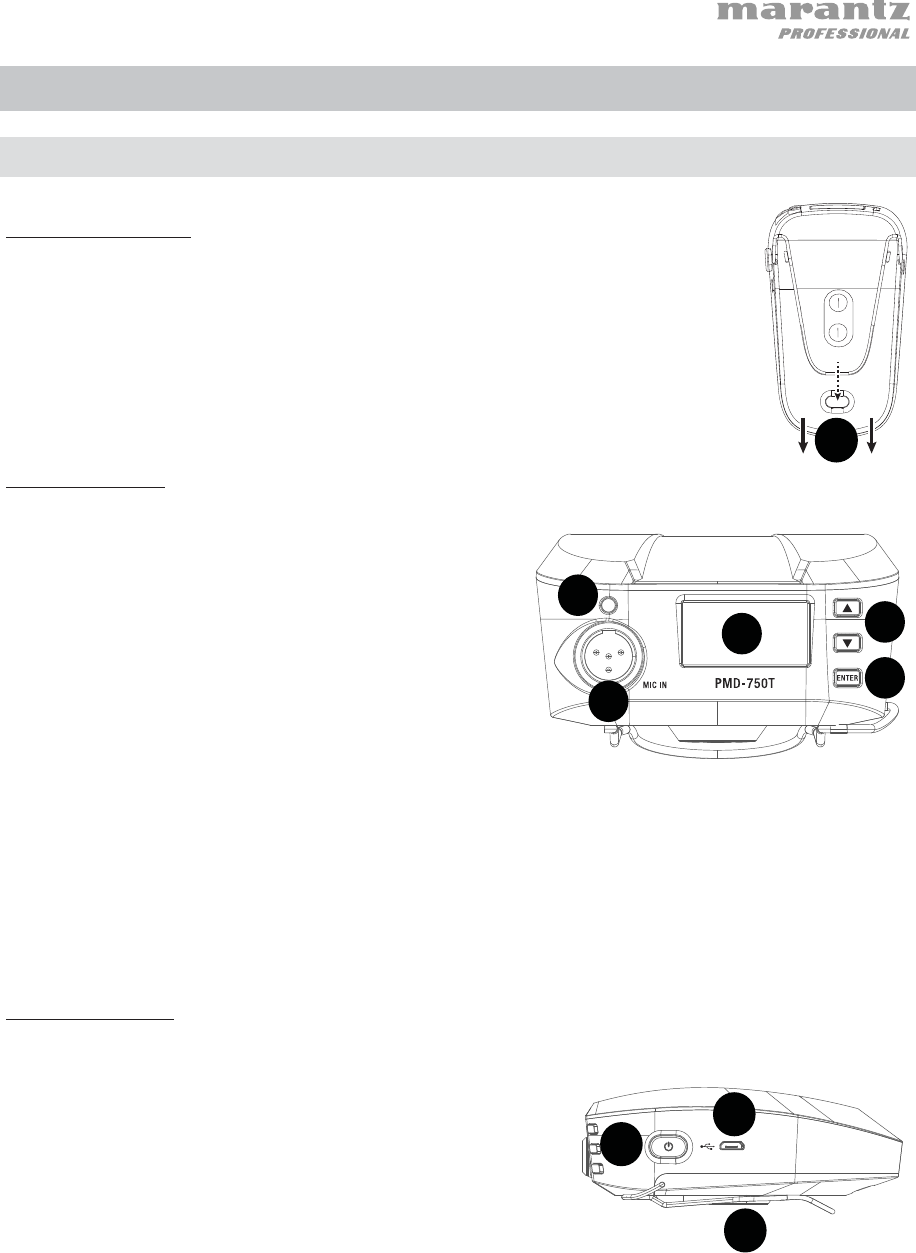
19
Caractéristiques
Émetteur
Panneau derrière
1. Compartiment des piles : Ce compartiment permet d’insérer 2
piles AA (non fournies) afin d’alimenter l’appareil. Nous
recommandons d’utiliser des piles alcalines. Veillez à toujours
remplacer les deux piles en même temps et à ne pas mélanger
les types de piles.
Panneau avant
1. Écran d’affichage : L’écran affiche le
canal utilisé par l’appareil pour
communiquer, l’état de jumelage et
l’indicateur de niveau de charge des piles.
2. DEL Pair : La DEL devient rouge et
clignote lorsque l'émetteur est mis en
sourdine. La DEL devient bleue et clignote
lorsque l’émetteur essaie de se jumeler au
récepteur. La DEL devient bleue lorsque
l’émetteur est jumelé au récepteur.
3. Touches de navigation : Ces touches permettent de déplacer le curseur sur les
différentes sections de l’écran.
4. Touche Enter : Appuyer sur cette touche permet de sélectionner une option
menu/sous-menu ou de confirmer une fonction spécifique.
5. Entrée microphone : Cette entrée permet de brancher le microphone-boutonnière à
condensateur équipé d’un connecteur mini-XLR fourni.
Panneau latéral
1. Port micro-USB : Ce port permet de
brancher un adaptateur d’alimentation USB
(vendu séparément) afin d’alimenter l’appareil
lorsque les piles AA ne sont pas utilisées.
2. Interrupteur d’alimentation : Maintenir cette
touche enfoncée permet de mettre l’appareil
sous et hors tension.
3. Clip de ceinture : Ce clip permet de fixer
l’appareil à une boucle de ceinture ou à une
poche.
1
2
3
4
5
1
2
1
3
1
2
3
4
5
1
2
1
3
1
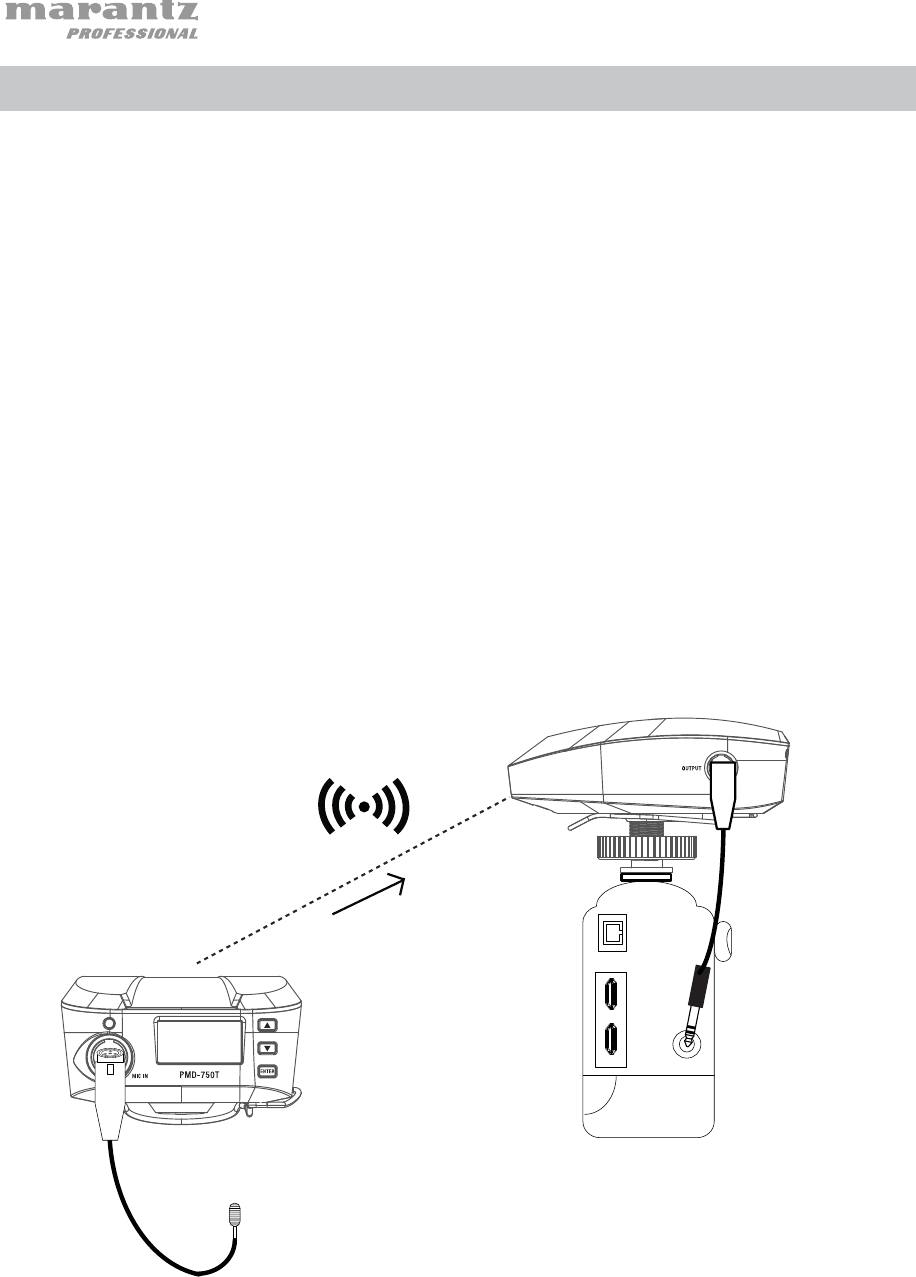
20
Installation
Les articles qui ne figurent pas dans la section Présentation > Contenu de la boîte sont
vendus séparément.
Exemple 1 – fonctionnement mono
Pour transmettre des signaux mono provenant d’un seul émetteur au récepteur :
1. Raccordez le microphone à l’entrée microphone de l’émetteur et raccordez la sortie
audio du récepteur à l’entrée microphone externe de l’appareil-photo. Réglez les
niveaux du volume de l’appareil photo au minimum.
2. Au besoin, réglez le niveau RF dB de l'émetteur pour obtenir un signal plus puissant
afin d’augmenter la portée de fonctionnement et d'améliorer la résistance au bruit.
3. Allumez l’appareil-photo, ajustez le niveau de sortie RX du récepteur et le niveau
d’entrée de l’entrée microphone externe de l’appareil-photo pour entendre le signal
audio (ou afficher le niveau d’entrée de l’appareil-photo).
4. Dans les paramètres d’enregistrement audio de votre appareil-photo, veillez à ce que le
mode Manuel soit sélectionné plutôt que le mode Auto. Vérifiez le vumètre du niveau
d’entrée et ajustez les niveaux de sorte que le son le plus fort ne dépasse pas -12 dB.
Assurez-vous que le son n’excède pas 0 dB afin d’éviter l’écrêtement du signal.
Récepteur
Émetteur
Entrée
microphone de
l’appareil-photo
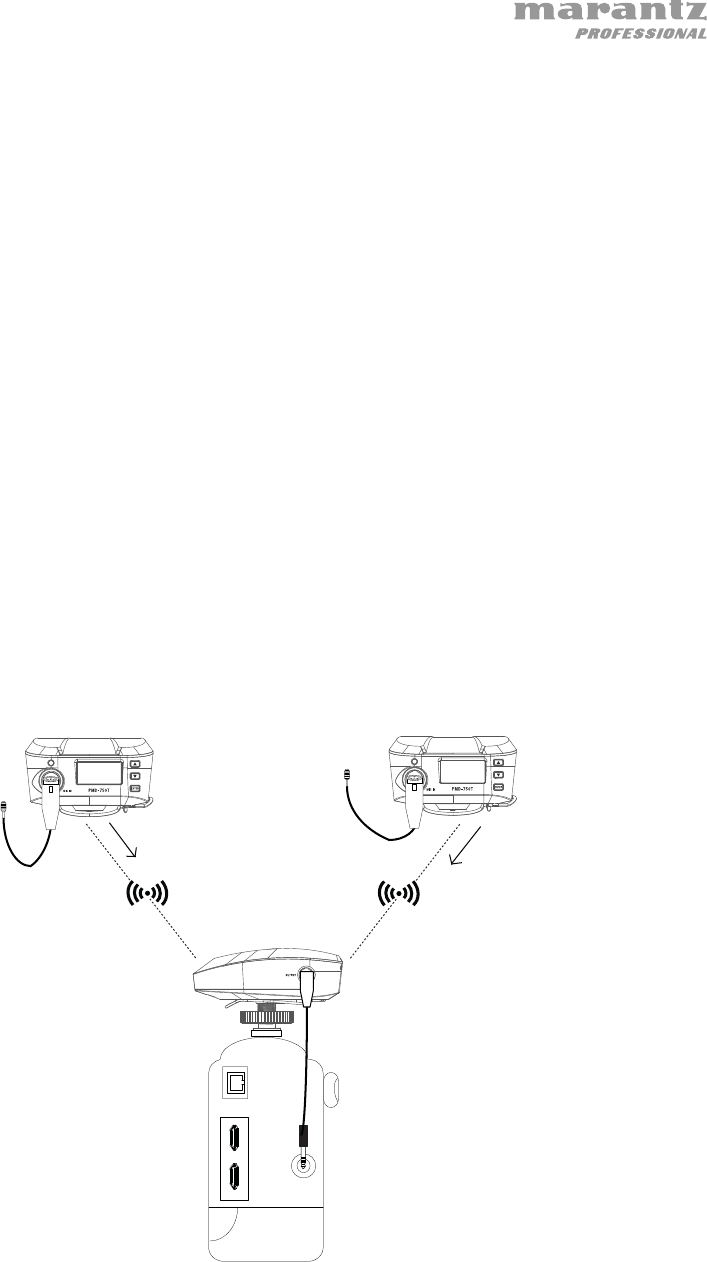
21
Exemple 2 - Fonctionnement stéréo
Pour transmettre des signaux stéréo provenant de deux émetteurs au récepteur :
1. Raccordez les microphones aux entrées microphone des émetteurs et raccordez la
sortie audio du récepteur à l’entrée microphone externe de l’appareil-photo. Réglez
les niveaux du volume de l’appareil photo au minimum.
2. Au besoin, réglez le niveau RF dB de l'émetteur pour obtenir un signal plus
puissant afin d’augmenter la portée de fonctionnement et d'améliorer la résistance
au bruit.
3. Allumez l’appareil-photo, ajustez le niveau de sortie RX du récepteur et le niveau
d’entrée de l’entrée microphone externe de l’appareil-photo pour entendre le signal
audio (ou afficher le niveau d’entrée de l’appareil-photo).
4. Dans les paramètres d’enregistrement audio de votre appareil-photo, veillez à ce
que le mode Manuel soit sélectionné plutôt que le mode Auto. Vérifiez le vumètre
du niveau d’entrée et ajustez les niveaux de sorte que le son le plus fort ne
dépasse pas -12 dB. Assurez-vous que le son n’excède pas 0 dB afin d’éviter
l’écrêtement du signal.
5. Réglez la sortie de l’émetteur sur Stereo et réglez le niveau de sortie afin d’obtenir
un signal puissant sans écrêtage.
Récepteur
Émetteur
Entrée microphone
de l’a
pp
areil-
p
hoto
Émetteur
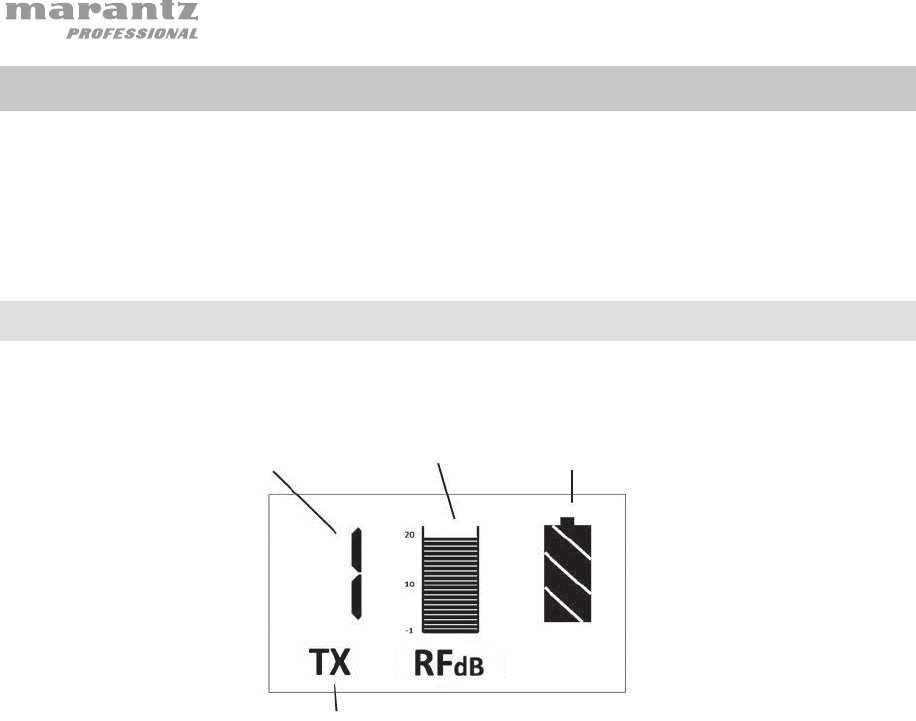
22
Fonctionnement
Pour configurer et utiliser le PMD-750T, veuillez suivre les étapes décrites dans la section
Jumelage de l’émetteur et du récepteur dans l’ordre. Lors de la configuration d’un
système qui utilise deux émetteurs, vous devez procéder à l’installation d’un émetteur à
la fois en vous assurant de garder chaque émetteur sous tension alors que vous
configurez les autres.
Menu de l’émetteur :
Menu principal :
• Appuyez et relâchez rapidement la touche d’alimentation de l’émetteur
pour activer et désactiver la mise en sourdine de l’émetteur.
Mode de jumelage :
• Utilisez les touches de navigation pour déplacer le curseur sur l'icône TX.
Une fois TX mis en surbrillance, l'icône affichera PAIR. Appuyez sur la
touche Enter pour passer en mode jumelage et l’icône se mettra à clignoter
jusqu’à ce que le récepteur soit jumelé. Une fois le récepteur jumelé, l’icône
restera allumée.
Niveau RF :
• Appuyez et relâchez la touche Enter du récepteur afin de mettre le vumètre
en surbrillance et utiliser les touches de navigation pour régler le niveau
RF. Le réglage par défaut est 10 dBm. Vous pouvez également le régler
sur : -1, 3, 5, 8, 10, 12, 14, 16 et 20 dBm.
Le nombre d’émetteurs
jumelés (dans l’ordre
qu’ils ont été jumelés)
Réglage du
signal RF
Indicateur de
charge des piles
de l’émetteur
Émetteur
/
en mode
jumelage
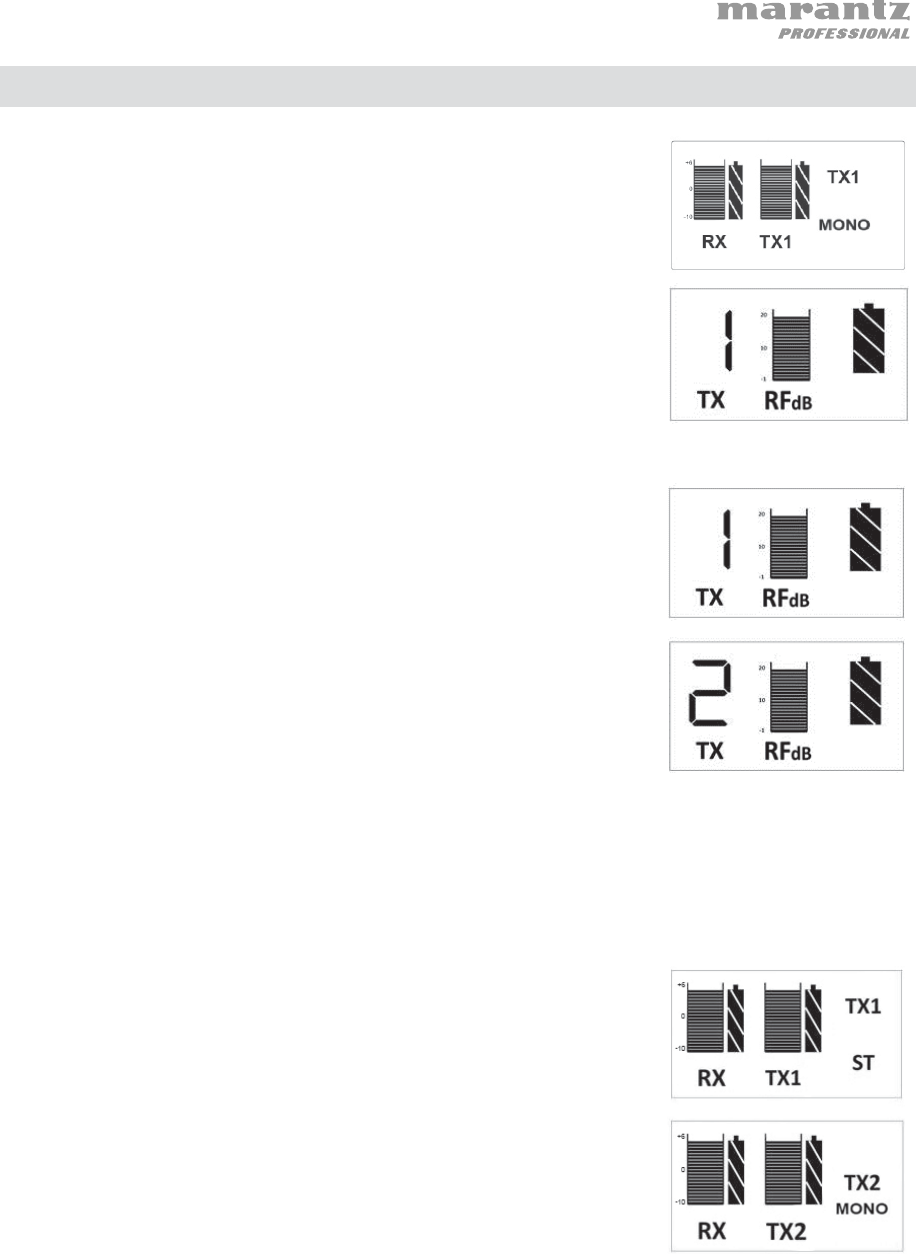
23
Jumelage de l’émetteur et du récepteur
Jumelage du récepteur avec un seul émetteur
(automatique) :
1. Allumez le récepteur et il lancera automatiquement le
mode jumelage.
2. Allumez l’émetteur et il se jumellera automatiquement
au récepteur.
Jumelage du récepteur avec deux émetteurs (automatique) :
1. Allumez le récepteur et il lancera automatiquement le
mode jumelage.
2. Dès que les émetteurs seront mis sous tension, ils
lanceront automatiquement le mode jumelage. Le
premier émetteur se jumellera automatiquement au
récepteur.
3. Une fois que le premier émetteur est jumelé, le
deuxième émetteur se jumellera au récepteur. Lorsque
le deuxième émetteur est jumelé au récepteur,
l’émetteur affichera « 2 TX ».
4. Le récepteur affichera « Mono » ou « Stereo ».
Appuyez sur la touche Enter pour le sélectionner et
utilisez les touches de sélection des canaux pour basculer entre les modes
« Mono » et « Stereo ». Appuyez sur la touche Enter pour confirmer la sélection.
Jumelage du récepteur avec un ou deux émetteurs (manuel) :
1. Allumez le récepteur et le ou les émetteurs.
2. Utilisez les touches de navigation pour déplacer le
curseur sur l'icône TX. Une fois TX mis en surbrillance,
l'icône affichera PAIR. Sur le ou les émetteurs,
appuyez sur la touche Enter pour passer en mode
jumelage et l’icône se mettra à clignoter jusqu’à ce que
le récepteur soit jumelé. Une fois le récepteur jumelé,
l’icône restera allumée.
3. Le récepteur affichera « Mono » ou « Stéréo ». Appuyez
sur la touche Enter pour le sélectionner et utilisez les
touches de navigation pour basculer entre les modes
« Mono » et « Stereo ». Appuyez sur la touche Enter
pour confirmer la sélection.
Remarque : Le mode de sortie est automatiquement réglé sur « Mono » lorsqu’un
seul émetteur est jumelé.

24
Guida per l’uso (Italiano)
Introduzione
Contenuti della confezione
PMD-750T Trasmttitore
Microfono a condensatore Lavalier
Antivento in schiuma
Antivento in pelliccia sintetica
Guida per l’uso
Istruzioni di sicurezza e garanzia
Assistenza
Per le ultime informazioni in merito a questo prodotto (documentazione,
specifiche tecniche, requisiti di sistema, informazioni sulla compatibilità,
ecc.) e per effettuarne la registrazione, recarsi alla pagina marantzpro.com.
Per ulteriore assistenza sul prodotto, recarsi alla pagina
marantzpro.com/support.

25
Importanti precauzioni
Nota bene: Marantz Professional e inMusic non sono responsabili per l’uso
dei rispettivi prodotti o per l’utilizzo errato delle presenti informazioni a
qualsiasi scopo. Marantz e inMusic non sono responsabili per l’uso improprio
dei rispettivi prodotti causato dal mancato rispetto delle procedure di
ispezione e di manutenzione. Per maggiori informazioni, fare inoltre
riferimento al manuale di sicurezza e garanzia in dotazione.
Livello audio
L’esposizione a livelli audio estremamente elevati può causare la perdita
permanente dell’udito. L’OSHA americana (Occupational Safety and Health
Administration) ha specificato i livelli di esposizione consentiti a certi tipi di
rumore. Secondo l’OSHA, l’esposizione a elevati livelli di pressione audio
(SPL) che superino tali limiti può causare la perdita dell’udito. Al momento di
utilizzare attrezzature in grado di generare un elevato SPL, servirsi di
dispositivi di protezione dell’udito per tutto il tempo in cui tale attrezzatura è
in uso.
Ore al giorno SPL (dB) Esempio
8 90 Piccolo concerto
6 92 Treno
4 95 Metropolitana
3 97 Monitor da tavolo di alto livello
2 100 Concerto di musica classica
1,5 102 Macchina ribaditrice
1 105 Fabbrica
0,50 110 Aeroporto
0,25 o meno 115 Concerto rock
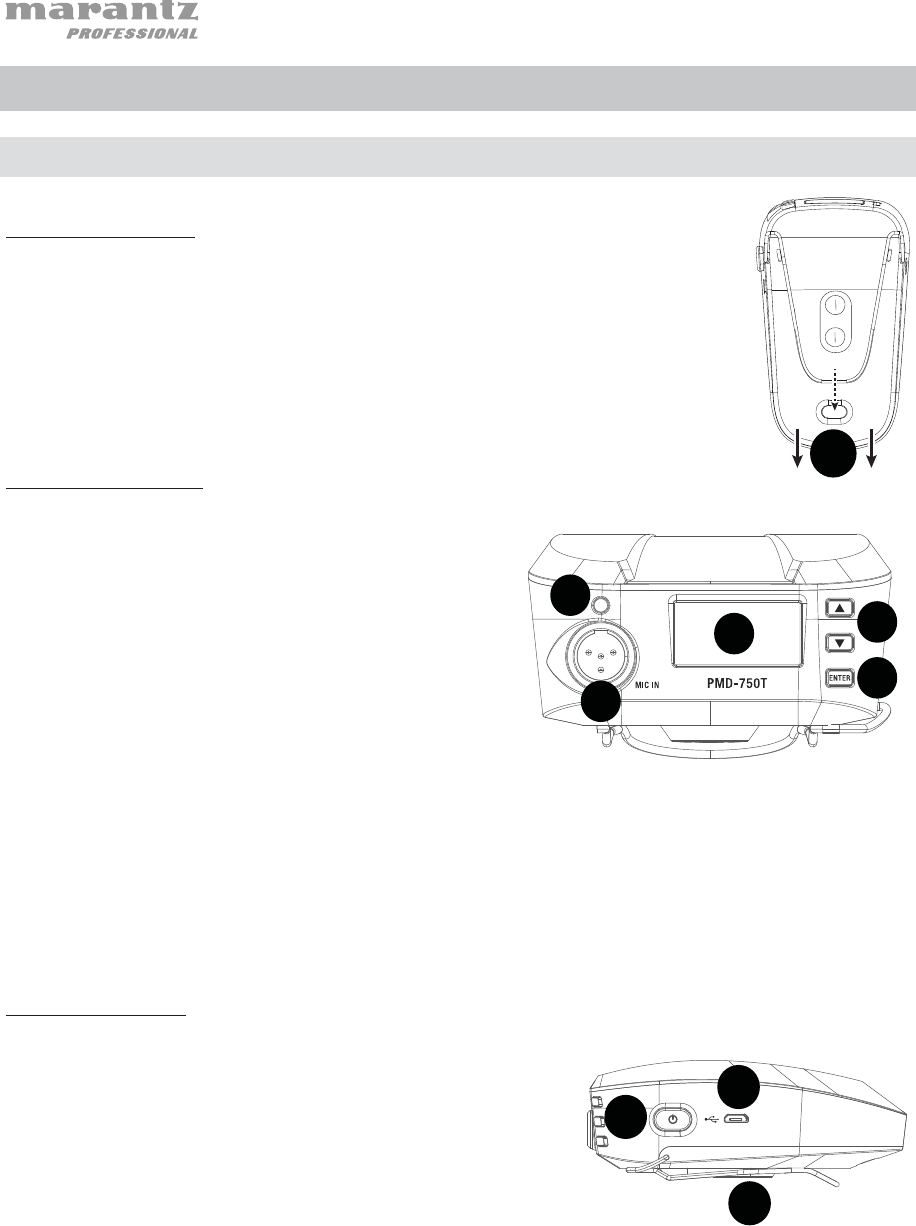
26
Caratteristiche
Trasmettitore
Pannello inferiore
1. Scomparto batterie: inserire (2) batterie AA a questo livello
(non in dotazione). Si consiglia l’uso di batterie alcaline;
sostituire sempre entrambe le batterie. Non mischiare diversi
tipi di batterie.
Pannello anteriore
1. Display: il display mostra il canale sul
quale sta comunicando l’apparecchio, lo
stato del collegamento e il misuratore del
livello della batteria.
2. LED Pair di collegamento: il LED
lampeggia di rosso quando il
trasmettitore è silenziato. Il LED
lampeggia di blu quando cerca di
collegarsi al ricevitore. Il LED sarà acceso
di blu fisso quando è collegato al
ricevitore.
3. Pulsanti di navigazione: premere questi tasti per cambiare le sezioni del display
evidenziate.
4. Tasto Enter: premere questo tasto per navigare fino a un menu/sottomenu o per
confermare una funzione specifica.
5. Ingresso mic: collegare il microfono a condensatore lavalier mini-XLR a questo
livello.
Pannello laterale
1. Porta micro USB: collegare un adattatore di
alimentazione USB (venduto separatamente) a
questo livello per alimentare l’apparecchio
quando non si utilizzano 2 batterie AA.
2. Accensione/spegnimento (on/off): tenere
premuto questo tasto per accendere e
spegnere l’apparecchio.
3. Clip da cintura: servirsi di questa clip per
fissare il prodotto a un passante per la cintura
o a una tasca.
1
2
3
4
5
1
2
1
3
1
2
3
4
5
1
2
1
3
1
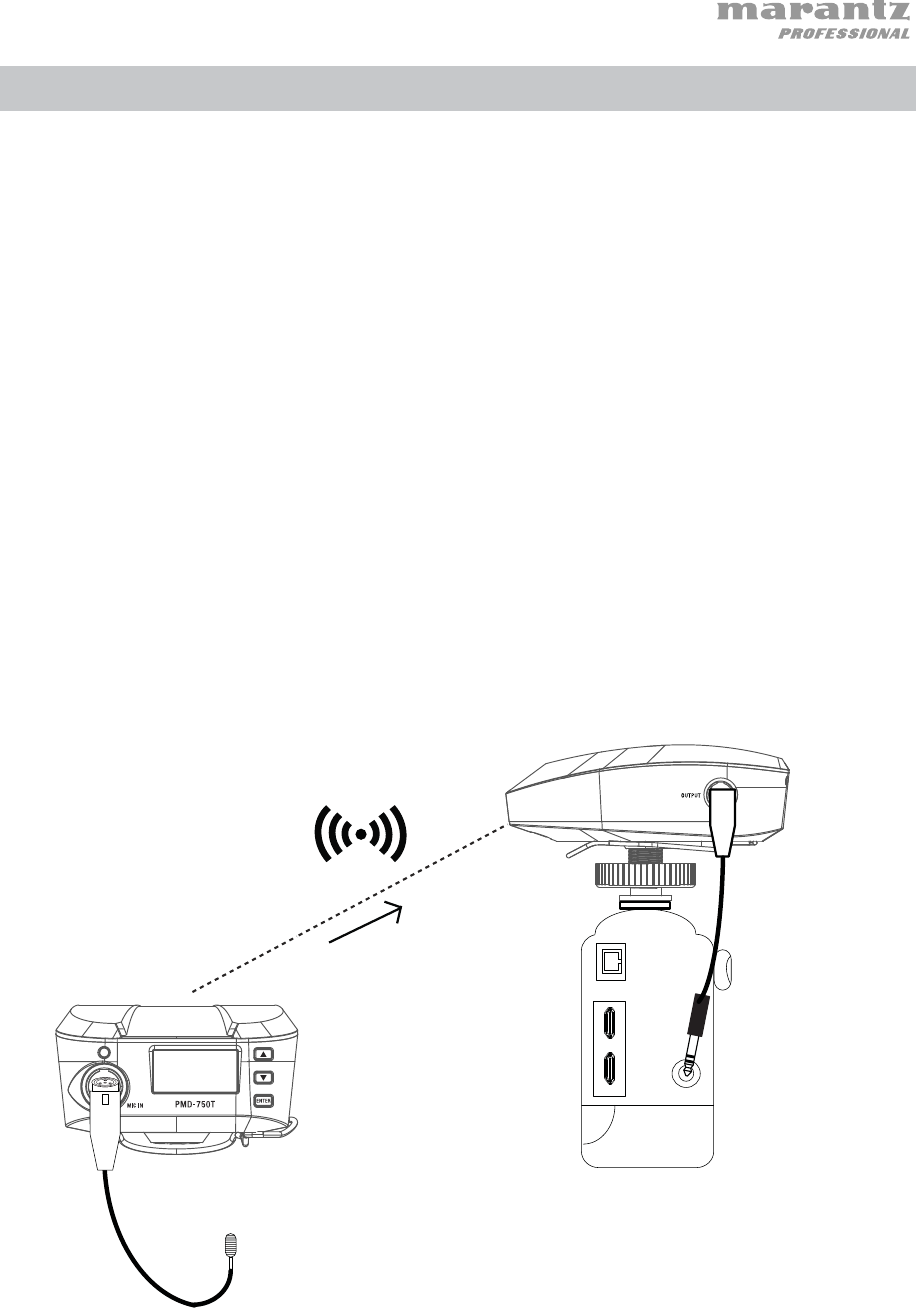
27
Configurazione
Gli elementi non elencati sotto Introduzione > Contenuti della confezione sono venduti
separatamente.
Esempio 1 – Operazione mono
Per inviare un segnale mono da un singolo trasmettitore al ricevitore:
1. Collegare il microfono all’ingresso mic sul trasmettitore e collegare l’uscita audio
all’ingresso mic esterno della videocamera. Mantenere i comandi del volume sulla
videocamera ai livelli minimi.
2. Se necessario, regolare il livello RF dB sul trasmettitore per ottenere un segnale
forte per una migliore portata operativa e una migliore resistenza ai rumori.
3. Accendere la videocamera, regolare il livello dell’uscita RX sul ricevitore e il livello di
ingresso dell’ingresso del microfono esterno della videocamera per sentire il segnale
audio (o visualizzare il livello sul livello di ingresso della videocamera).
4. Nelle impostazioni di registrazione audio della videocamera, assicurarsi che sia
impostato su Manual anziché su Auto. Verificare il misuratore di livello di ingresso e
regolare il livello in modo che i suoni più forti abbiano picco attorno a -12 dB. Assicurarsi
che il suono non superi 0 dB, in quanto si verificherebbe distorsione del segnale.
Ricevitore
Trasmettitore Videocamera
Mic
In
g
resso
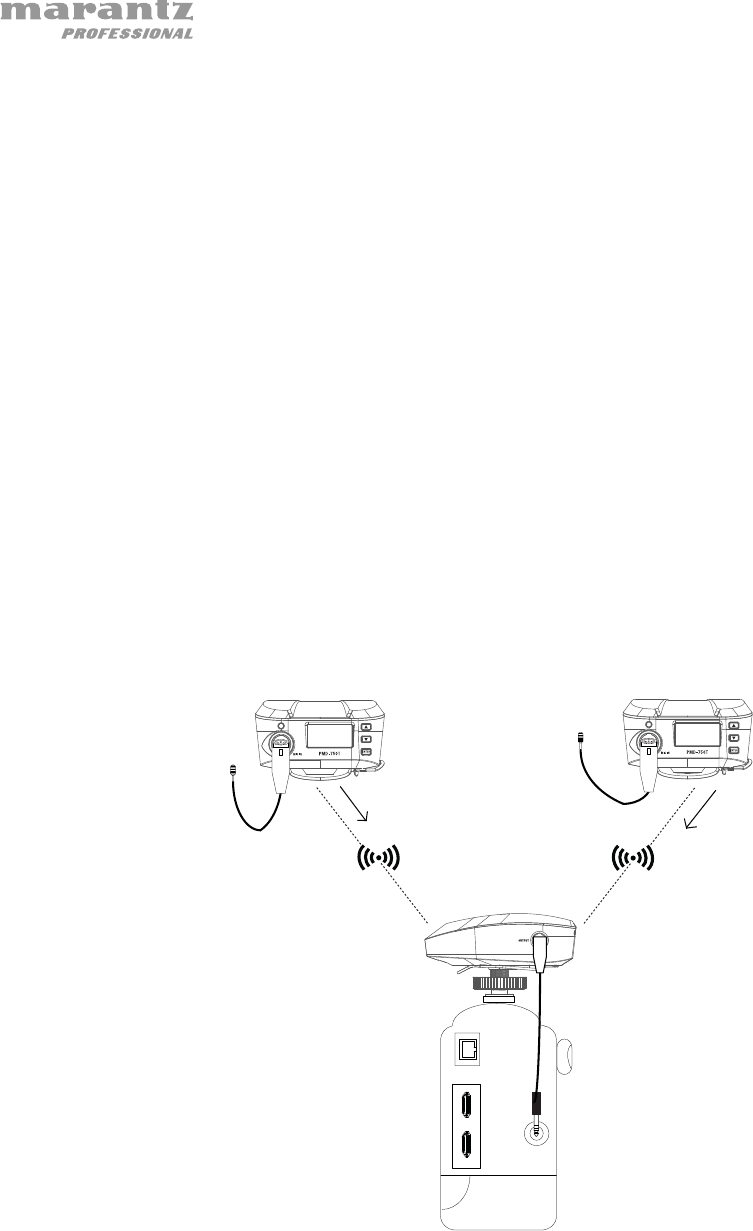
28
Esempio 2 – Operazione stereo
Per inviare un segnale stereo da 2 trasmettitori al ricevitore:
1. Collegare il microfono agli ingressi mic sui trasmettitori e collegare l’uscita audio
del ricevitore all’ingresso mic esterno della videocamera. Mantenere i comandi del
volume sulla videocamera ai livelli minimi.
2. Se necessario, regolare il livello RF dB sul trasmettitore per ottenere un segnale
forte per una migliore portata operativa e una migliore resistenza ai rumori.
3. Accendere la videocamera, regolare il livello dell’uscita RX sul ricevitore e il livello
di ingresso dell’ingresso del microfono esterno della videocamera per sentire il
segnale audio (o visualizzare il livello sul livello di ingresso della videocamera).
4. Nelle impostazioni di registrazione audio della videocamera, assicurarsi che sia
impostato su Manual anziché su Auto. Verificare il misuratore di livello di ingresso
e regolare il livello in modo che i suoni più forti abbiano picco attorno a -12 dB.
Assicurarsi che il suono non superi 0 dB, in quanto si verificherebbe distorsione
del segnale.
5. Impostare il menu di uscita del ricevitore su Stereo e regolare il livello di uscita per
ottenere un segnale forte senza salti.
Ricevitore
Trasmettitore
Ingresso mic
videocamera
Trasmettitore
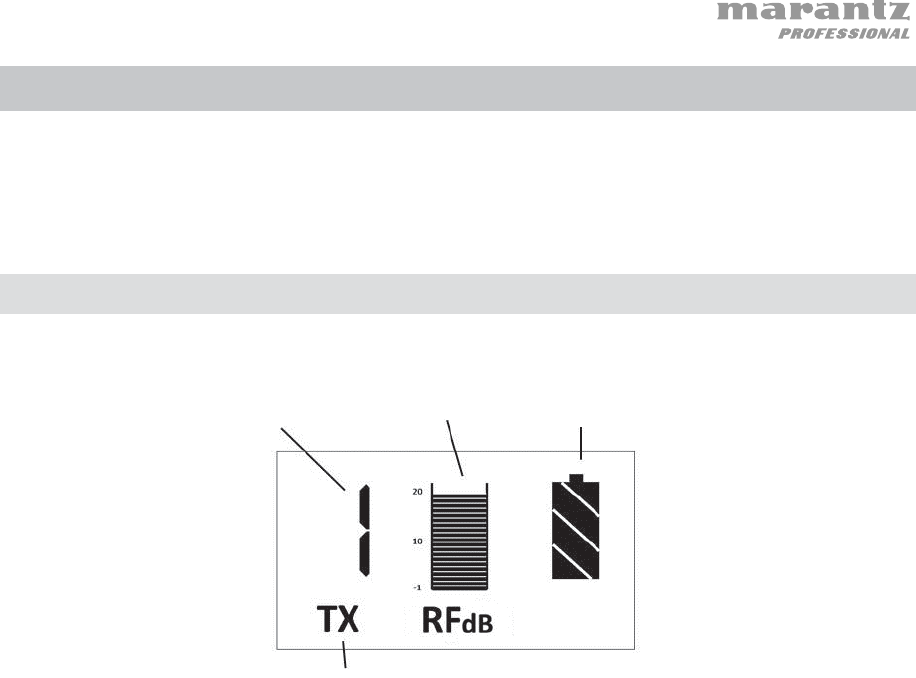
29
Operazione
Per configurare e utilizzare il PMD-750T, seguire i passaggi indicati nel capitolo
Collegamento del trasmettitore e del ricevitore in ordine. Se si sta configurando un
impianto che impiega due trasmettitori, configurare ciascun trasmettitore uno alla volta e
mantenere acceso ciascuno di essi mentre si configura l’altro.
Menu trasmettitore
Menu principale:
• Silenzia/annulla il silenziamento del trasmettitore premendo e rilasciando
rapidamente il tasto Power.
Modalità di collegamento:
• Premere i tasti di navigazione per portare il cursore sull’icona TX. Una
volta evidenziato TX, l’icona mostra PAIR a display. Premere Enter per
entrare in modalità di collegamento e l’icona lampeggerà in attesa del
collegamento del ricevitore. Una volta effettuato il collegamento, l’icona si
illuminerà in maniera fissa.
Livello RF:
• Premere e rilasciare il tasto Enter sul ricevitore per evidenziare il misuratore
e servirsi dei tasti navigazione per regolare l’alimentazione RF.
L’impostazione predefinita è 10 dBm. Il valore può essere impostato su: -1,
3, 5, 8, 10, 12, 14, 16, 20 dBm.
Il numero di
trasmettitori collegati
(nell’ordine in cui sono
stati collegati)
Impostazioni
alimentazione
RF Livello batteria
trasmettitore
Trasmettitore/collegamento
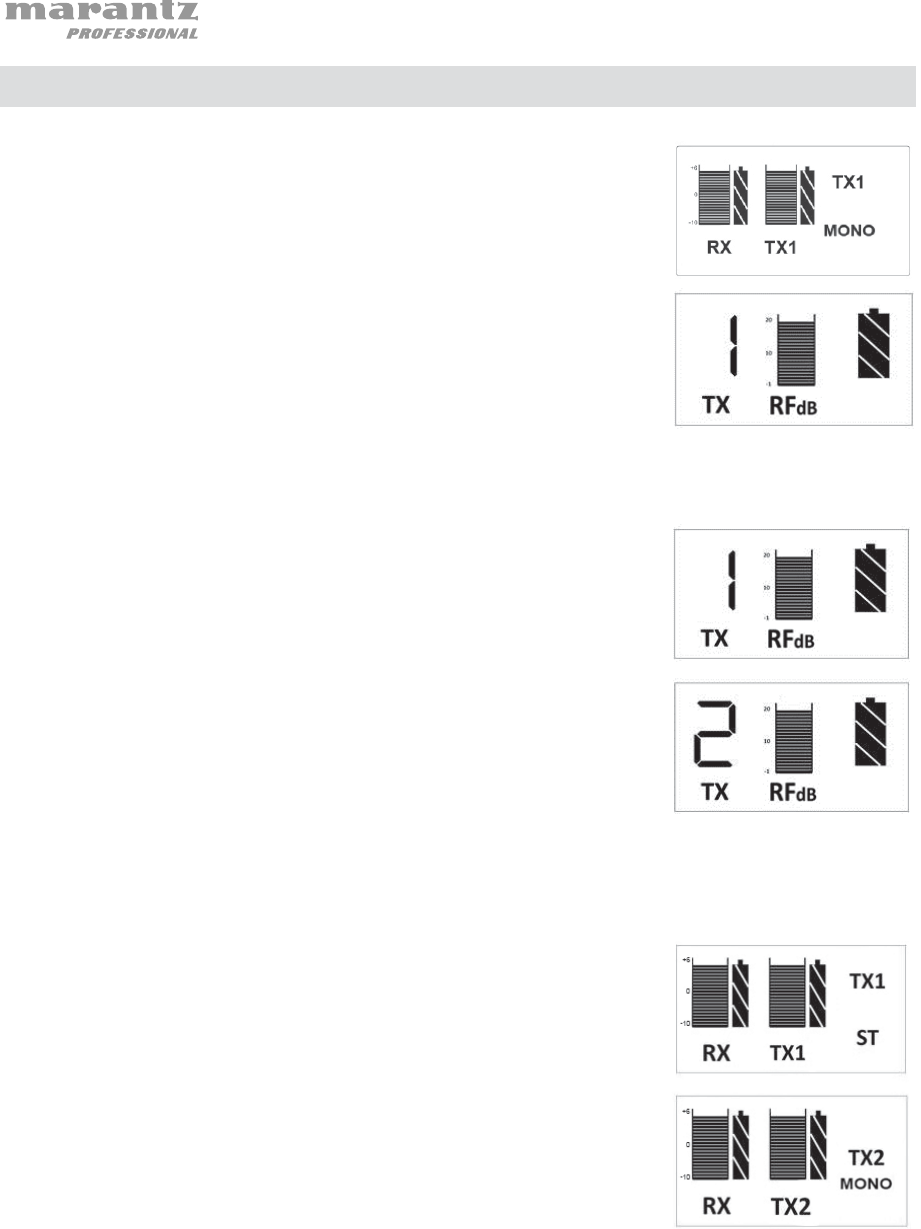
30
Collegamento di trasmettitore e ricevitore
Collegamento di 1 trasmettitore al ricevitore (automatico)
1. Accendere il ricevitore. Entrerà in modalità di
collegamento.
2. Accendendo il trasmettitore si collegherà
automaticamente con il ricevitore.
Collegamento di 2 trasmettitori al ricevitore (automatico)
1. Accendere il ricevitore. Entrerà in modalità di
collegamento.
2. Accendere i ricevitori. Entreranno in modalità di
collegamento. Il primo trasmettitore si collegherà
automaticamente con il ricevitore.
3. Una volta che il Trasmettitore 1 è collegato il
Trasmettitore 2 si collegherà al ricevitore. Quando il
Trasmettitore 2 è collegato al ricevitore, sul display del
trasmettitore compare la scritta “2 TX”.
4. Il display del ricevitore mostrerà “Mono” o “Stereo”.
Premere Enter per selezionarlo e servirsi dei tasti
navigazione per commutare tra “Mono” e “Stereo”.
Premere Enter per confermare la selezione.
Collegamento di 1 o 2 trasmettitori al ricevitore (manuale)
1. Accendere il ricevitore e i trasmettitori.
2. Premere i tasti di navigazione per portare il cursore
sull’icona TX. Una volta evidenziato TX, l’icona mostra
PAIR a display. Premere Enter sul/i trasmettitore/i per
entrare in modalità di collegamento e l’icona
lampeggerà in attesa del collegamento del ricevitore.
Una volta effettuato il collegamento, l’icona si illuminerà
in maniera fissa.
3. Il display del ricevitore mostrerà “Mono” o “Stereo”.
Premere Enter per selezionarlo e servirsi dei tasti
navigazione per commutare tra “Mono” e “Stereo”.
Premere Enter per confermare la selezione.
Nota bene: la modalità di uscita è impostata automaticamente su “Mono” quando
è collegato un solo trasmettitore.

31
Benutzerhandbuch (Deutsch)
Einführung
Lieferumfang
PMD-750T Sender
Lavalier-Kondensatormikrofon
Schaumstoff-Windschutz
Kunstfellwindschutz
Benutzerhandbuch
Sicherheitshinweise und Garantieinformationen
Kundendienst
Für die neuesten Informationen zu diesem Produkt (Dokumentation,
technische Daten, Systemanforderungen, Informationen zur Kompatibilität
etc.) und zur Produktregistrierung besuchen Sie bitte marantzpro.com.
Für zusätzlichen Produkt-Support besuchen Sie marantzpro.com/support.
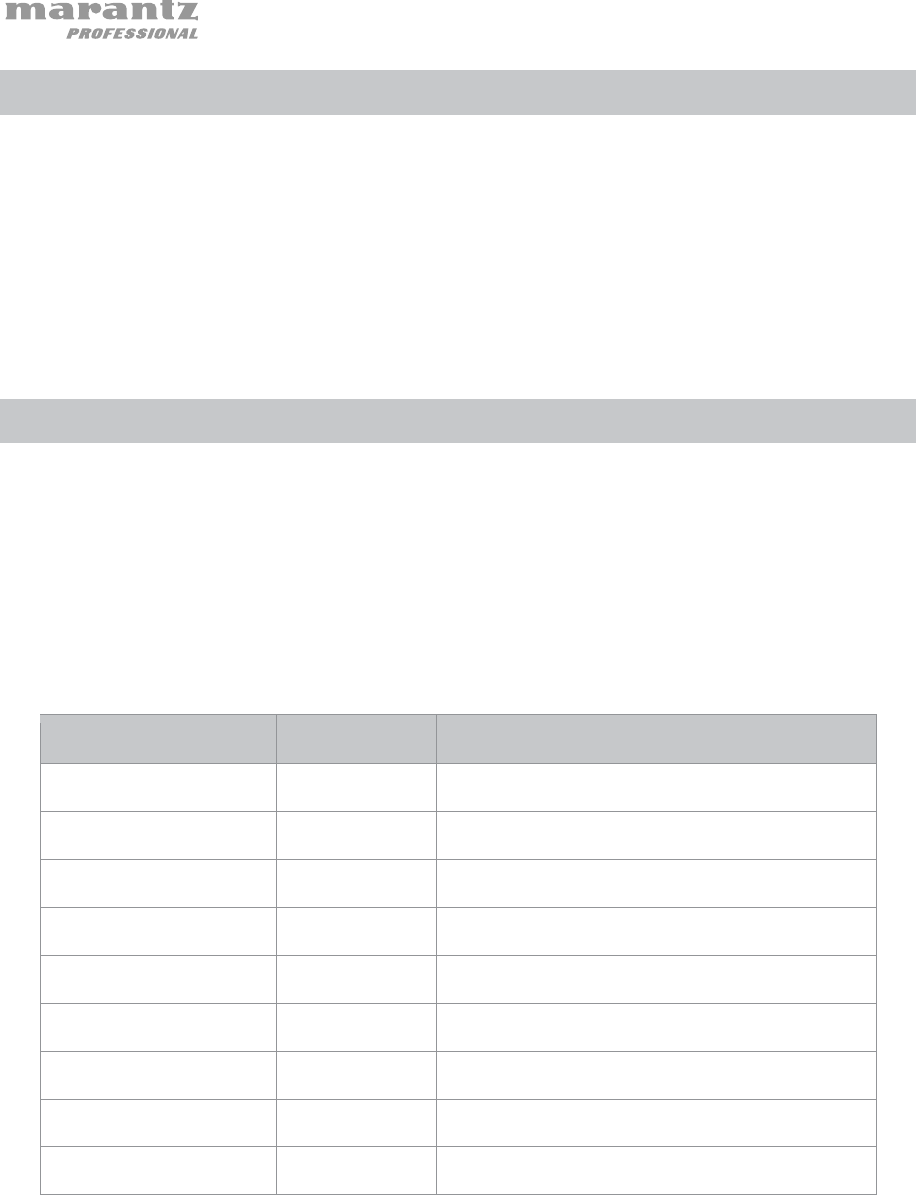
32
Wichtige Sicherheitshinweise
Bitte beachten Sie: Marantz Professional und inMusic sind weder für die
Verwendung ihrer Produkte noch für den Missbrauch dieser Informationen für
beliebige Zwecke verantwortlich. Marantz Professional und inMusic sind nicht
für die missbräuchliche Verwendung ihrer Produkte verantwortlich, die durch
verabsäumte Inspektions- und Wartungsarbeiten verursacht wurde. Bitte
beachten Sie auch das mitgelieferte Handbuch für Sicherheitshinweise und
Garantieinformationen.
Schallpegel
Eine Exposition gegenüber extrem hohen Lärmpegeln kann zu bleibenden
Hörschäden führen. Die Occupational Safety and Health Administration
(OSHA) der US-Regierung hat zulässige Expositionswerte für bestimmte
Lärmpegel festgelegt. Laut OSHA können Belastungen durch
Schalldruckpegel (SPL), die diese Grenzwerte überschreiten, zu Hörverlust
führen. Tragen Sie beim Einsatz von Geräten, die einen hohen Schalldruck
erzeugen können, stets einen Gehörschutz.
Stunden pro Tag SPL (dB) Beispiel
8 90 Kleines Konzert
6 92 Zug
4 95 U-Bahn
3 97 Leistungsstarke Desktop-Monitore
2 100 Konzert mit klassischer Musik
1.5 102 Nietmaschine
1 105 Maschinenfabrik
0.50 110 Flughafen
0.25 oder weniger 115 Rock-Konzert
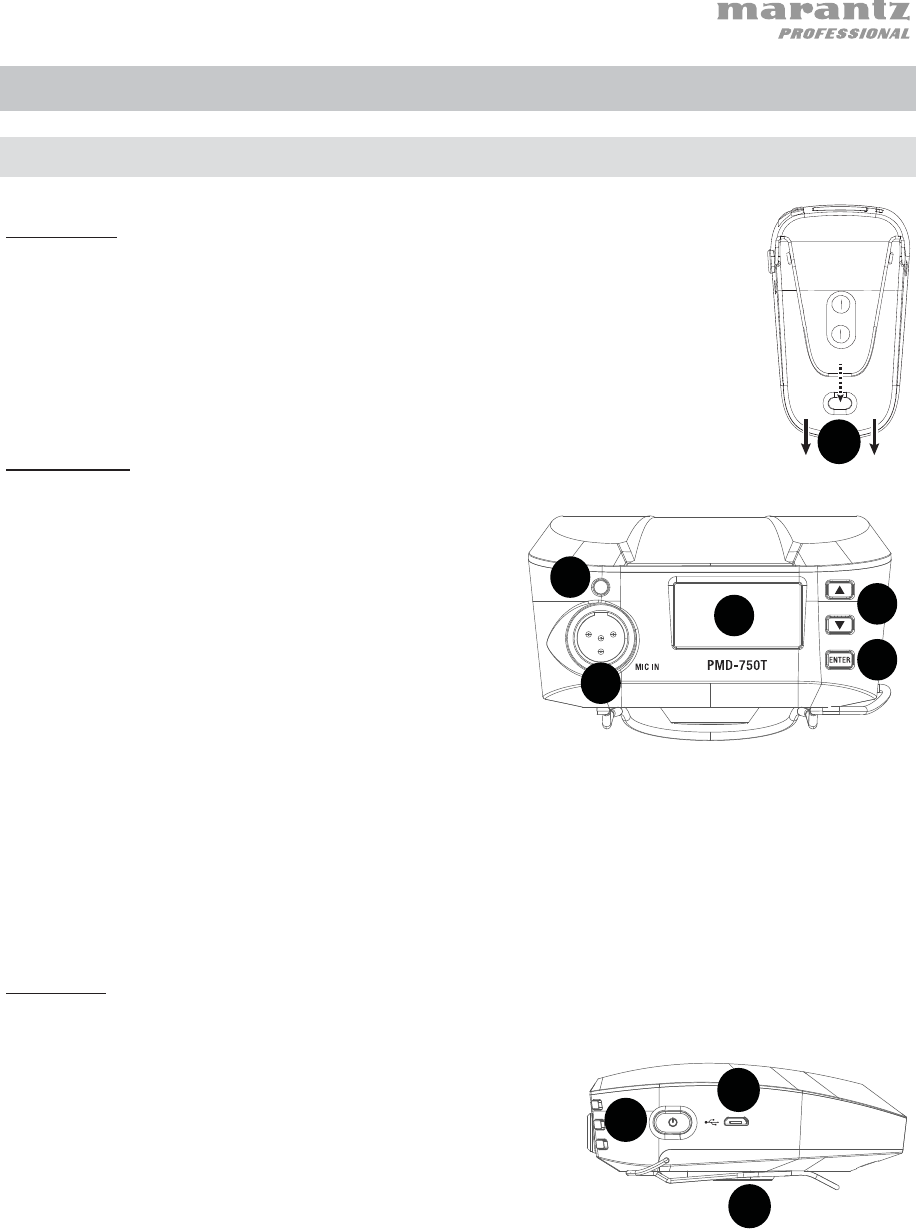
33
Funktionen
Sender
Unterseite
1. Batteriefach: Legen Sie hier (2) AA Batterien ein (nicht im
Lieferumfang enthalten). Wir empfehlen Alkalibatterien; Ersetzen
Sie immer beide Batterien. Verwenden Sie keine unterschiedlichen
Batterietypen.
Vorderseite
1. Display: Auf dem Display erscheinen der
Kanal, auf dem das Gerät kommuniziert,
sowie der Koppel-Status und die
Batteriestandanzeige.
2. Pair-LED: Die LED blinkt rot, wenn der
Sender stummgeschaltet ist. Die LED
blinkt blau, wenn das Gerät mit dem
Empfänger verbunden werden soll. Die
LED leuchtet dauerhaft blau, wenn sie
mit dem Empfänger gekoppelt ist.
3. Navigationstasten: Drücken Sie diese Tasten, um zu ändern, welche Bereiche
des Displays hervorgehoben werden.
4. Enter-Taste: Drücken Sie diese Taste, um zu einer Menü-/Untermenü-Auswahl zu
navigieren oder eine bestimmte Funktion zu bestätigen.
5. Mic-Eingang: Schließen Sie hier das mitgelieferte Mini-XLR Lavalier-
Kondensatormikrofon an.
Seitenteil
1. Mikro-USB-Anschluss: Schließen Sie einen
USB-Netzadapter (separat erhältlich) an, um
das Gerät mit Strom zu versorgen, wenn Sie
keine 2 AA-Batterien verwenden.
2. Einschalten/Ausschalten: Halten Sie diese
Taste gedrückt, um das Gerät ein- oder
auszuschalten.
3. Gürtelclip: Befestigen Sie diesen Clip, um
eine Gürtelschlaufe oder eine Tasche zu
sichern.
1
2
3
4
5
1
2
1
3
1
2
3
4
5
1
2
1
3
1
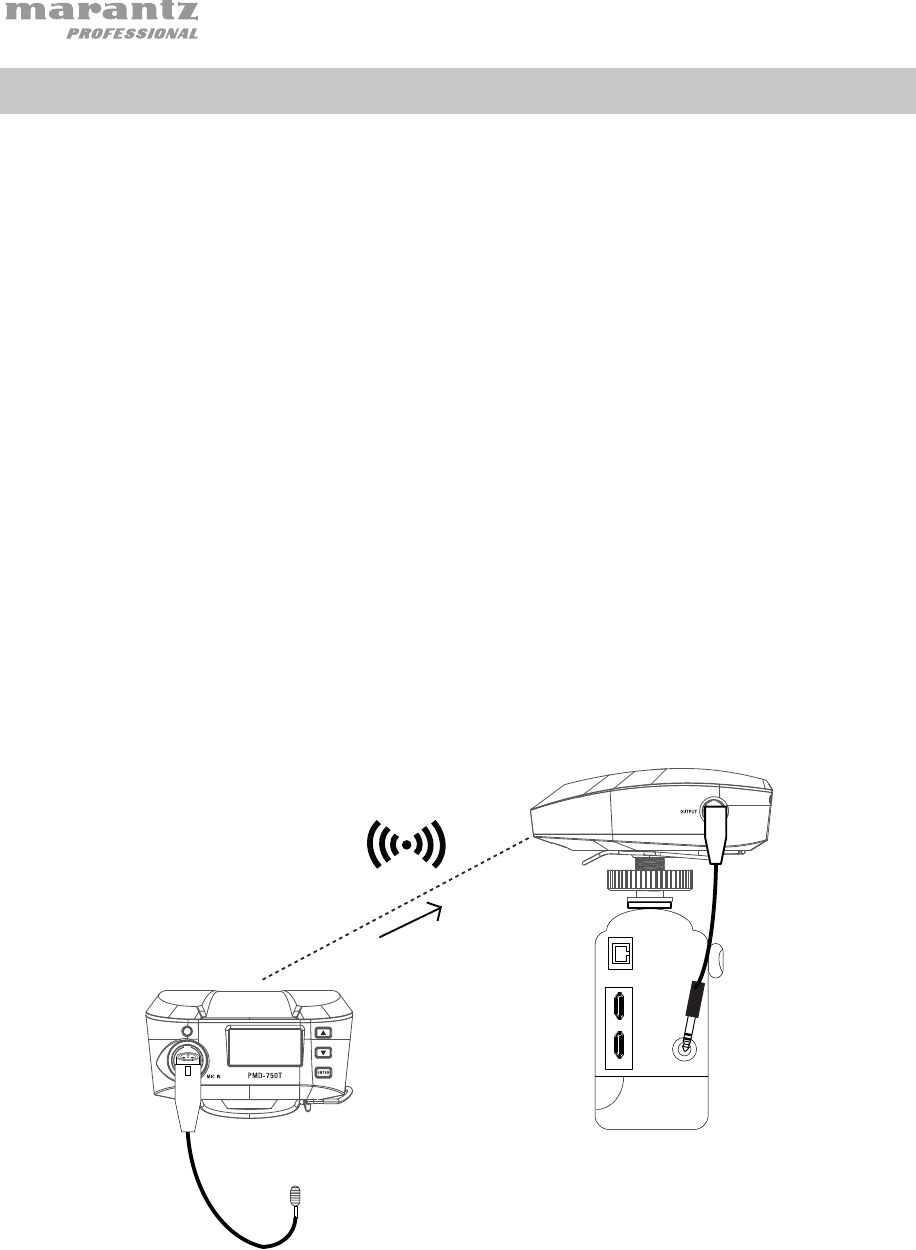
34
Setup
Teile, die nicht unter Einführung > Lieferumfang angegeben sind, sind separat
erhältlich.
Beispiel 1 - Mono-Betrieb
Um ein Monosignal von einem einzigen Sender an den Empfänger zu senden:
1. Verbinden Sie Ihr Mikrofon mit dem Mikrofoneingang am Sender und verbinden
Sie den Audioausgang des Empfängers mit dem externen Mikrofoneingang Ihrer
Kamera. Belassen Sie die Lautstärkeregler der Kamera auf den niedrigsten
Einstellungen.
2. Falls erforderlich, stellen Sie den RF dB-Pegel am Sender ein, um ein starkes
Signal für einen besseren Betriebsbereich und Rauschwiderstand zu erhalten.
3. Schalten Sie die Kamera ein, stellen Sie den RX-Ausgangspegel am Empfänger
und den Eingangspegel des externen Mikrofoneingangs der Kamera ein, um das
Audiosignal zu hören (oder den Eingangspegels der Kamera anzuzeigen).
4. Vergewissern Sie sich, dass die Audio-Aufnahmeeinstellungen Ihrer Kamera auf
Manual und nicht auf Auto eingestellt sind. Überprüfen Sie das Eingangspegel-
Messgerät und stellen Sie den Pegel so ein, dass die lautesten Signale um -12 dB
liegen. Vergewissern Sie sich, dass der Ton 0 dB nicht überschreitet, wodurch das
Signal verfälscht wird.
Empfän
g
er
Sender Kamera
Mic
Ein
g
an
g
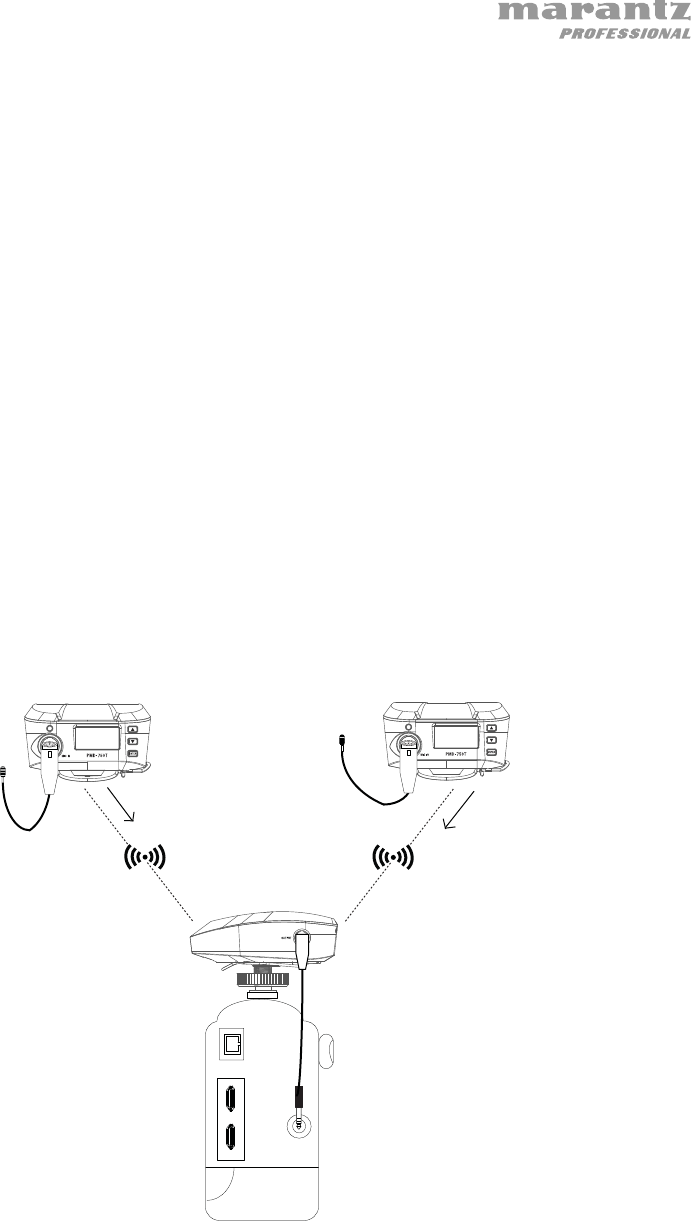
35
Beispiel 2 - Stereobetrieb
Um ein Stereosignal von 2 Sendern an den Empfänger zu senden:
1. Verbinden Sie Ihr Mikrofon mit den Mikrofoneingängen der Sender und verbinden
Sie den Audioausgang des Empfängers mit dem externen Mikrofoneingang Ihrer
Kamera. Belassen Sie die Lautstärkeregler der Kamera auf den niedrigsten
Einstellungen.
2. Falls erforderlich, stellen Sie den RF dB-Pegel am Sender ein, um ein starkes
Signal für einen besseren Betriebsbereich und Rauschwiderstand zu erhalten.
3. Schalten Sie die Kamera ein, stellen Sie den RX-Ausgangspegel am Empfänger
und den Eingangspegel des externen Mikrofoneingangs der Kamera ein, um das
Audiosignal zu hören (oder den Eingangspegels der Kamera anzuzeigen).
4. Vergewissern Sie sich, dass die Audio-Aufnahmeeinstellungen Ihrer Kamera auf
Manual und nicht auf Auto eingestellt sind. Überprüfen Sie das Eingangspegel-
Messgerät und stellen Sie den Pegel so ein, dass die lautesten Signale um -12 dB
liegen. Vergewissern Sie sich, dass der Ton 0 dB nicht überschreitet, wodurch das
Signal verfälscht wird.
5. Stellen Sie das Ausgabe-Menü des Empfängers auf Stereo und passen Sie den
Ausgangspegel an, um ein starkes Signal ohne Clipping zu erhalten.
Empfän
g
er
Sender
Kameramikrofonein
g
an
g
Sender
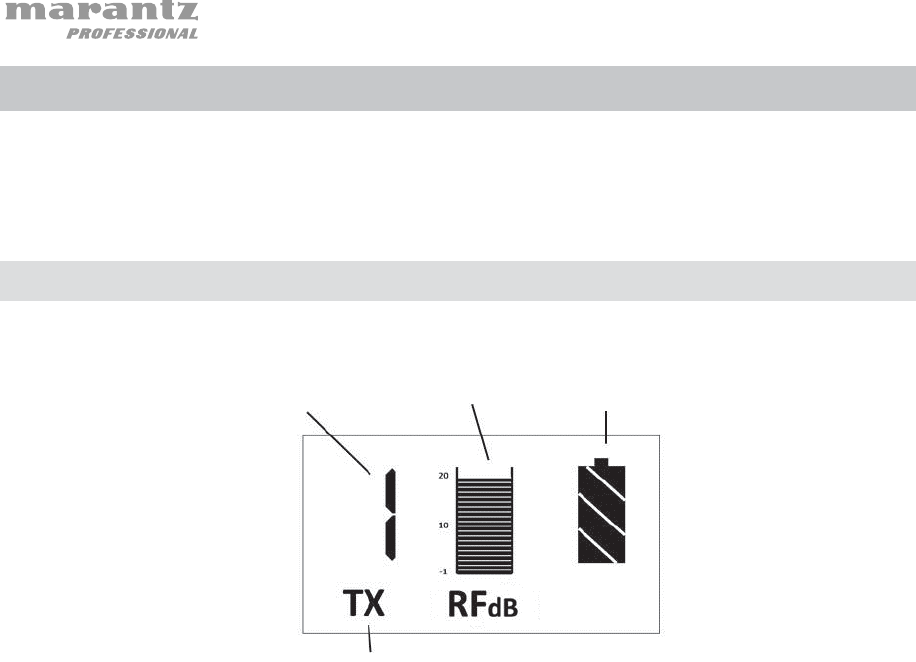
36
Betrieb
Um Ihren PMD-750T einzurichten und zu verwenden, folgen Sie den Schritten im Kapitel
Sender und Empfänger koppeln in der richtigen Reihenfolge. Wenn Sie ein System mit
zwei Sendern einrichten, richten Sie jeden Sender einzeln ein und halten Sie jeden
Sender eingeschaltet, während Sie die zusätzliche Einheit einrichten.
Sendermenü
Hauptmenü:
• Stummschaltung/Aufheben der Stummschaltung des Senders durch
schnelles Drücken des Netzschalters.
Koppelmodus:
• Bewegen Sie den Cursor mit den Navigationstasten auf das TX-Symbol.
Sobald TX markiert ist, zeigt das Symbol PAIR an. Drücken Sie die Taste
Enter, um in den Kopplungsmodus zu wechseln. Das Symbol beginnt zu
blinken und wartet bis der Empfänger die Verbindung hergestellt hat.
Nachdem eine Verbindung hergestellt wurde leuchtet das Symbol
durchgehend.
RF-Stufe:
• Drücken Sie kurz die Enter-Taste am Empfänger, um die Anzeige zu markieren
und verwenden die Navigationstasten, um die RF-Leistung einzustellen. Die
Standardeinstellung ist 10 dBm. Sie können dies auf folgende Werte
einstellen: -1, 3, 5, 8, 10, 12, 14, 16, 20 dBm.
Die Anzahl der
gekoppelten Sender (in
der Reihenfolge, in der
die Verbindung
hergestellt wurde)
RF-Leistungsstufe
Senderbatteriestand
Sender/Koppeln
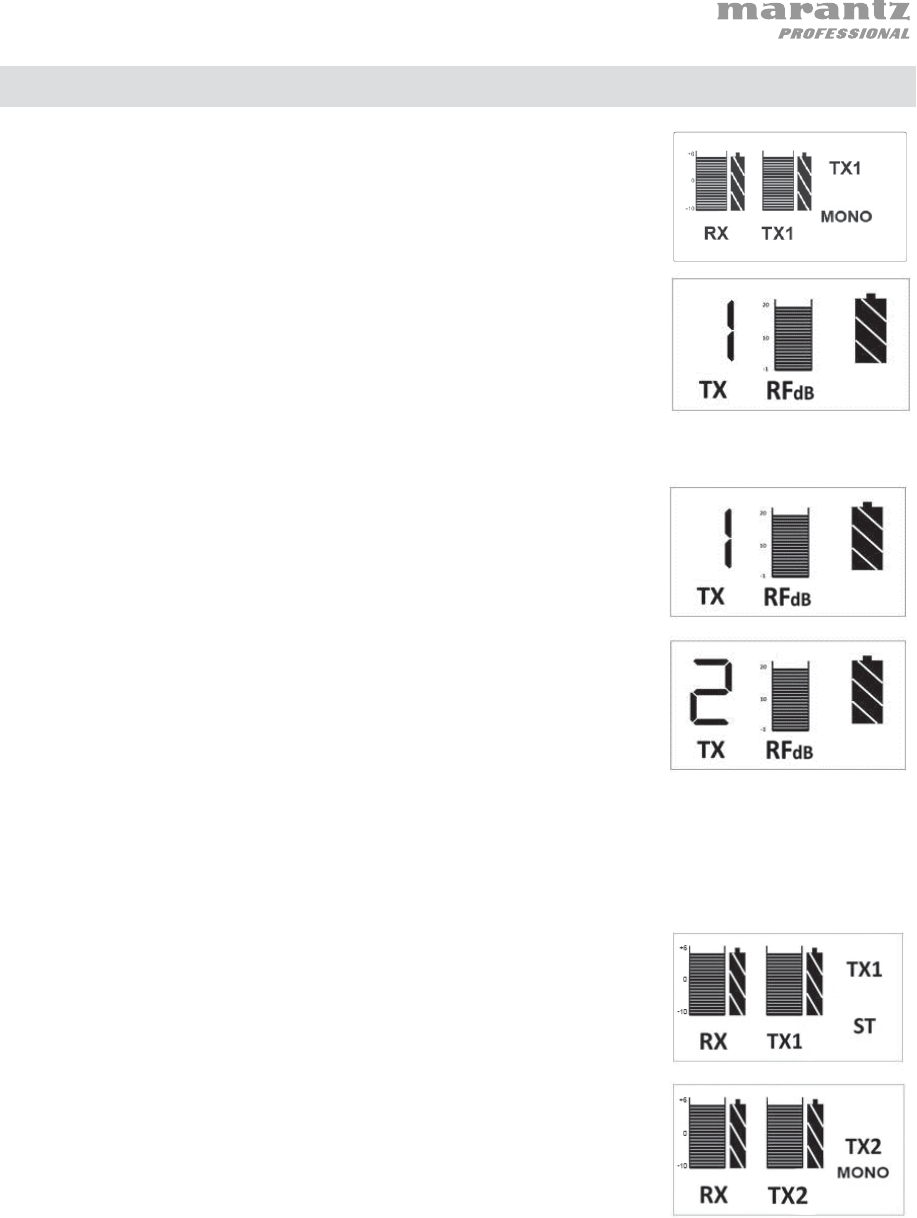
37
Koppeln von Sender und Empfänger
Koppeln von 1 Sender mit dem Empfänger (automatisch):
1. Schalten Sie den Empfänger ein und navigieren Sie in den
Koppel-Modus.
2. Schalten Sie den Sender ein und er stellt automatisch
mit dem Empfänger eine Verbindung her.
Koppeln von 2 Sendern mit dem Empfänger (automatisch):
1. Schalten Sie den Empfänger ein und navigieren Sie in den
Koppel-Modus.
2. Schalten Sie die Sender ein und sie navigieren in den
Koppel-Modus. Schalten Sie den ersten Sender ein
und er stellt automatisch eine Verbindung mit dem
Empfänger her.
3. Sobald Sender 1 gekoppelt ist, stellt Sender 2 eine
Verbindung mit dem Empfänger her. Wenn Sender 2
an den Empfänger gekoppelt ist, zeigt die
Senderanzeige „2 TX“ an.
4. Die Empfängeranzeige zeigt „Mono“ oder „Stereo“ an.
Drücken Sie Enter, um sie auszuwählen, und wählen Sie
mit den Navigationstasten zwischen „Mono“ und „Stereo“. Drücken Sie Enter, um
die Auswahl zu bestätigen.
Koppeln von 1 oder 2 Sendern mit dem Empfänger (manuell)
1. Schalten Sie den Empfänger und den/die Sender ein.
2. Bewegen Sie den Cursor mit den Navigationstasten
auf das TX-Symbol. Sobald TX markiert ist, zeigt das
Symbol PAIR an. Drücken Sie die Taste Enter am
Sender (bzw. den Sendern), um in den
Kopplungsmodus zu wechseln. Das Symbol beginnt zu
blinken und wartet bis der Empfänger die Verbindung
hergestellt hat. Nachdem eine Verbindung hergestellt
wurde leuchtet das Symbol durchgehend.
3. Die Empfängeranzeige zeigt „Mono“ oder „Stereo“ an.
Drücken Sie Enter, um sie auszuwählen, und wählen Sie
mit den Navigationstasten zwischen „Mono“ und
„Stereo“. Drücken Sie Enter, um die Auswahl zu bestätigen.
Hinweis: Der Ausgabemodus wird automatisch auf „Mono“ gesetzt, wenn nur ein Sender
gekoppelt ist.

38
Appendix (English)
Technical Specifications
Audio
Performance
Frequency Spectrum: 2.401 – 2.483 GHz
Dynamic Range: >100 dB
THD: 0.2%, typical
Latency: 4.5 ms
Operating Range: Up to 100 ft. / 30.5 m
Battery Life* Receiver: up to 7 hours (1CH), up to 6 hours
(1CH+2CH)
Transmitter: up to 10 hours
Transmitter Frequency Response: 50 Hz – 18 kHz
Maximum Input Level: -20 dB
Bias Voltage: 3 V
Input Impedance: >10 M
Power: 2 AA alkaline batteries
Dimensions (width x depth x height):
2.6” x 4.0” x 1.6” / 65 mm x 102 mm x 40 mm
Weight: 82g
*Use high-quality alkaline batteries. Non-alkaline or rechargeable batteries will give
dramatically different results.
Specifications are subject to change without notice.
Trademarks & Licenses
Marantz is a trademark of D&M Holdings Inc., registered in the U.S. and
other countries. Marantz Professional products are produced by inMusic
Brands, Inc., Cumberland, RI 02864, USA.
All other product names, company names, trademarks, or trade names are
those of their respective owners.

39
marantzpro.com
Manual Version 1.6

Important Safety Instructions
& Warranty Information
English (3–14)
Instrucciones importantes de seguridad
e información de la garantía
Español (15–23)
Instructions importantes de sécurité
et informations de garantie
Français (24–31)
Istruzioni importanti di sicurezza
e le informazioni della garanzia
Italiano (33–41)
Wichtige Sicherheitsanweisungen
und Garantieinformationen
Deutsch (42–50)
2
Marantz is a trademark of D&M Holdings Inc., registered in the U.S. and other countries.
Marantz Professional products are produced by inMusic Brands, Inc., Cumberland, RI
02864 U.S.A.
NEMA® is the registered trademark and service mark of the National Electrical
Manufacturers Association.
All other product names, company names, trademarks, or trade names are those of their
respective owners.

3
Product Warranty
(for products purchased in the U.S.A.)
1. What is covered and for how long?
All Products: inMusic Brands, Inc. (“inMusic”) warrants to the original
purchaser that Marantz Professional (“Marantz Pro”) products and all
other accessories are free from defects in material and workmanship
under normal use and service for the period commencing upon the date
of purchase from an authorized Marantz Pro dealer and continuing for
the following period of time after that date for one (1) year. inMusic
warrants factory-refurbished merchandise to be free of material and
operational defects for a period of ninety (90) days from the original date
of retail sale. This refurbished merchandise warranty is not transferable.
2. What is not covered? This Limited Warranty is conditioned upon
proper use of the product by the purchaser. This Limited Warranty does
not cover: (a) damage caused by improper installation or improper
connection to any peripheral; (b) damage caused by an external
electrical fault; (c) damage from use of parts not manufactured or sold
by Marantz Pro; (d) product purchased from anyone other than an
Marantz Pro authorized dealer; (e) modifications to product not
approved in writing by Marantz Pro; (f) equipment that has the serial
number removed or made illegible; (g) normal cosmetic and mechanical
wear; (h) damage or loss during transit to an Authorized Marantz Pro
Repair Center; or (i) units that are purchased and/or located outside of
the continental USA.
3. What are inMusic’s obligations? During the applicable warranty
period, Marantz Pro will repair or replace, at Marantz Pro’s sole option,
without charge to the purchaser, any defective component part of the
product. To obtain service under this Limited Warranty, purchaser must
first contact Marantz Pro and obtain a return merchant authorization
(“RMA”) number. Purchaser must then return the product to Marantz
Pro in an adequate container for shipping, accompanied by purchaser’s
sales receipt or comparable proof of sale showing the date of purchase,
the serial number of the product, and the seller’s name and address. To
obtain an RMA number and assistance on where to return the product,
contact Marantz Pro customer service at 401-658-5766. Upon receipt,
Marantz Pro will repair or replace the defective products. Marantz Pro
4
may, at Marantz Pro’s sole option, use rebuilt, reconditioned, or new
parts or components when repairing any product or replace a product
with a rebuilt, reconditioned, new or comparable product. Repaired
products will be warranted for a period equal to the remainder of the
original Limited Warranty on the original product or for 90 days,
whichever is longer. All replaced parts, components, boards, and
equipment become the property of Marantz Pro. If Marantz Pro
determines that any product is not covered by this Limited Warranty,
purchaser must pay all parts, shipping, and labor charges for the repair
or return of such product.
4. What are the limits on inMusic’s liabilities? THE WARRANTIES
GIVEN IN THIS LIMITED WARRANTY, TOGETHER WITH ANY IMPLIED
WARRANTIES COVERING MARANTZ PRO PRODUCTS, INCLUDING
WITHOUT LIMITATION ANY WARRANTIES OF MERCHANTABILITY OR
FITNESS FOR A PARTICULAR PURPOSE, ARE LIMITED TO THE
DURATION OF THIS LIMITED WARRANTY. EXCEPT TO THE EXTENT
PROHIBITED BY APPLICABLE LAW, INMUSIC OR MARANTZ PRO
SHALL NOT BE LIABLE FOR ANY SPECIAL, INCIDENTAL,
CONSEQUENTIAL, INDIRECT OR SIMILAR DAMAGES, LOSS OF
PROFITS, DAMAGES TO PURCHASER’S PROPERTY, OR INJURY TO
PURCHASER OR OTHERS ARISING OUT OF THE USE, MISUSE OR
INABILITY TO USE ANY MARANTZ PRO PRODUCT, BREACH OF
WARRANTY, OR NEGLIGENCE, INCLUDING BUT NOT LIMITED TO
INMUSIC’S OR MARANTZ PRO’S OWN NEGLIGENCE, EVEN IF
INMUSIC, MARANTZ PRO, OR THEIR AGENTS HAVE BEEN ADVISED
OF SUCH DAMAGES, OR FOR ANY CLAIM BROUGHT AGAINST
PURCHASER BY ANY OTHER PARTY. THIS LIMITED WARRANTY IS
THE COMPLETE WARRANTY FOR MARANTZ PRO PRODUCTS, AND
IS GIVEN IN LIEU OF ALL OTHER EXPRESS WARRANTIES. THIS
LIMITED WARRANTY SHALL NOT EXTEND TO ANYONE OTHER THAN
THE ORIGINAL PURCHASER OF THIS PRODUCT AND STATES
PURCHASER’S EXCLUSIVE REMEDY. IF ANY PORTION OF THIS
LIMITED WARRANTY IS ILLEGAL OR UNENFORCEABLE BY REASON
OF ANY LAW, SUCH PARTIAL ILLEGALITY OR UNENFORCEABILTY
SHALL NOT AFFECT THE ENFORCEABILITY OF THE REMAINDER OF
THIS LIMITED WARRANTY WHICH PURCHASER ACKNOWLEDGES IS
AND WILL ALWAYS BE CONSTRUED TO BE LIMITED BY ITS TERMS
OR AS LIMITED AS THE LAW PERMITS.
This Limited Warranty allocates risk of product failure between
purchaser and Marantz Pro, and Marantz Pro’s product pricing reflects
this allocation of risk and the limitations of liability contained in this
5
Limited Warranty. The agents, employees, distributors, and dealers of
Marantz Pro are not authorized to make modifications to this Limited
Warranty, or make additional warranties binding on Marantz Pro or
inMusic. Accordingly, additional statements such as dealer advertising
or presentation, whether oral or written, do not constitute warranties by
Marantz Pro or inMusic and should not be relied upon.
5. How does state law apply to this warranty? SOME STATES DO NOT
ALLOW THE EXCLUSION OR LIMITATIONS OF INCIDENTAL OR
CONSEQUENTIAL DAMAGES OR HOW LONG AN IMPLIED
WARRANTY LASTS, SO THE ABOVE LIMITATIONS OR EXCLUSIONS
MAY NOT APPLY TO PURCHASER.
This Limited Warranty gives you specific legal rights. You may also have
other rights, which vary from one jurisdiction to another.
Please record the serial number of your unit as shown on the back of the
chassis as well as the name of the dealer from whom you purchased the unit.
Retain this information and your original purchase receipt for your records.
Go to our website marantzpro.com to register your product with us.
Model:Purchased From:
Serial Number:Date of Purchase:

6
Product Warranty
(for products purchased outside of the U.S.A.)
1. inMusic Brands, Inc. (“inMusic”) warrants to the original purchaser that
Marantz Professional (“Marantz Pro”) products are free from defects in
material and workmanship under normal use and service for the period
commencing upon the date of purchase from an authorized Marantz
Pro dealer and continuing for the following period of time after that date
for (1) Year.
2. This Limited Warranty is conditioned upon proper use of the product by
the purchaser.
This Limited Warranty does not cover: (a) defects or damage resulting
from accident, misuse, abuse, neglect, unusual physical or electrical
stress, modification of any part of the product, or cosmetic damage; (b)
equipment that has the serial number removed or made illegible; (c) all
plastic surfaces and other externally exposed parts that are scratched
or damaged due to normal use; (d) defects or damage from improper
testing, operation, maintenance, installation, adjustment, or service of
the products.
3. During the applicable warranty period, Marantz Pro will repair or
replace, at Marantz Pro’s sole discretion, without charge to the
purchaser, any defective component part of the product. Marantz Pro
may, at Marantz Pro’s sole discretion, use rebuilt, reconditioned, or new
parts or components when repairing any product or replace a product
with a rebuilt, reconditioned, new or comparable product.
4. THE WARRANTIES GIVEN IN THIS LIMITED WARRANTY, TOGETHER
WITH ANY IMPLIED WARRANTIES COVERING MARANTZ PRO
PRODUCTS, INCLUDING WITHOUT LIMITATION ANY WARRANTIES
OF MERCHANTABILITY OR FITNESS FOR A PARTICULAR PURPOSE,
ARE LIMITED TO THE DURATION OF THIS LIMITED WARRANTY.
EXCEPT TO THE EXTENT PROHIBITED BY APPLICABLE LAW,
INMUSIC OR MARANTZ PRO SHALL NOT BE LIABLE FOR ANY
SPECIAL, INCIDENTAL, CONSEQUENTIAL, INDIRECT OR SIMILAR
DAMAGES, LOSS OF PROFITS, DAMAGES TO PURCHASER’S
PROPERTY, OR INJURY TO PURCHASER OR OTHERS ARISING OUT
OF THE USE, MISUSE OR INABILITY TO USE ANY MARANTZ PRO
PRODUCT, BREACH OF WARRANTY, OR NEGLIGENCE, INCLUDING
7
BUT NOT LIMITED TO INMUSIC’S OR MARANTZ PRO’S OWN
NEGLIGENCE, EVEN IF INMUSIC, MARANTZ PRO, OR ITS AGENTS
HAVE BEEN ADVISED OF SUCH DAMAGES, OR FOR ANY CLAIM
BROUGHT AGAINST PURCHASER BY ANY OTHER PARTY. THIS
LIMITED WARRANTY IS THE COMPLETE WARRANTY FOR MARANTZ
PRO’S PRODUCTS, AND IS GIVEN IN LIEU OF ALL OTHER EXPRESS
WARRANTIES. THIS LIMITED WARRANTY SHALL NOT EXTEND TO
ANYONE OTHER THAN THE ORIGINAL PURCHASER OF THIS
PRODUCT AND STATES PURCHASER’S EXCLUSIVE REMEDY. IF ANY
PORTION OF THIS LIMITED WARRANTY IS ILLEGAL OR
UNENFORCEABLE BY REASON OF ANY LAW, SUCH PARTIAL
ILLEGALITY OR UNENFORCEABILTY SHALL NOT AFFECT THE
ENFORCEABILITY OF THE REMAINDER OF THIS LIMITED WARRANTY
WHICH PURCHASER ACKNOWLEDGES IS AND WILL ALWAYS BE
CONSTRUED TO BE LIMITED BY ITS TERMS OR AS LIMITED AS THE
LAW PERMITS.
This Limited Warranty allocates risk of product failure between purchaser
and Marantz Pro, and Marantz Pro’s product pricing reflects this allocation
of risk and the limitations of liability contained in this Limited Warranty. The
agents, employees, distributors, and dealers of Marantz Pro are not
authorized to make modifications to this Limited Warranty, or make
additional warranties binding on Marantz Pro or inMusic. Accordingly,
additional statements such as dealer advertising or presentation, whether
oral or written, do not constitute warranties by Marantz Pro or inMusic and
should not be relied upon. Some jurisdictions do not allow limitations on
how long an implied warranty lasts, so the above limitation may not apply to
you. This warranty gives you specific legal rights, and you may also have
other rights which vary under local laws.
Please record the serial number of your unit as shown on the back of the
chassis as well as the name of the dealer from whom you purchased the unit.
Retain this information and your original purchase receipt for your records.
Go to our website marantzpro.com to register your product with us.
Model:Purchased From:
Serial Number: Date of Purchase:
8
Return Information
•A return merchant authorization number must be obtained from your
local Marantz Pro representative. For your representative go to
marantzpro.com.
•A copy of the original sales receipt must also be included for the
equipment to be repaired under warranty.
•The faulty equipment must be packed in its original packaging.
•One additional outer layer of packaging must be included to ensure
product safety. Failure to do so may inadequately protect the
equipment in transit and therefore jeopardize the warranty.
•Marantz Pro will not accept COD shipments and no call tags will be
issued for merchandise return.
•Marantz Pro will not return repaired merchandise to customers by
priority service except by written request at the customer’s cost.
Requests must be submitted in writing with returned merchandise.
•The defective Marantz Pro equipment should be sent freight
prepaid with the return merchant authorization number printed
clearly on the outer packaging and original sales receipt enclosed to
your local service center.
Very Important
Please read this section before connecting this unit to your system:
For optimum performance:
•All slide faders are subject to wear. Excessive force can wear out the
faders quickly. User-replaceable slide faders are not covered by our
warranty.
•Never use spray cleaners on the slide controls. Residues cause
excessive dirt build-up and this will void your warranty. In normal
use, slide controls can last for many years. If they malfunction
(usually because of a dirty or dusty environment), consult a
professional technician.
• Always make sure that AC power is off while making any connections.
9
• Use appropriate cables throughout your system. Do not use
excessively long cables (i.e. over 32 feet / 10 meters). Be sure plugs
and jacks are tightly mated. Loose connections can cause hum, noise,
or intermittents that could easily damage your speakers. Make the
input and output connections with readily available low-capacitance
stereo cables. Cable quality makes a big difference in audio fidelity
and “punch.” See your Marantz Pro dealer or an electronics or audio
specialist store if you are not sure which cables to use.
•Never attempt to make any adjustments other than those described
in this manual, or repairs. Take the unit to your dealer or to an
authorized Marantz Pro service center.
• Always remember: turn amps on last and off first. Begin with master
faders or volume controls on minimum and the amplifier gain/input
control(s) down. Wait 8–10 seconds before turning up the volume. This
prevents transients which may cause severe speaker damage.
• Use restraint when operating controls. Try to move them slowly. Rapid
adjustments could damage equipment due to amplifier clipping.
•Avoid amplifier “clipping” at all costs: this occurs when the red LEDs
(usually on the front panel of most professional power amplifiers)
start flashing. “Clipping” is when the power amplifier is distorting
and working beyond its limits. Amplifier distortion is the main cause
of speaker failure.
•To prevent fire or shock hazard, do not expose the unit to rain or
moisture. Never place cans of beer, soda, glasses of water or
anything wet near or on top of the unit!
•Headphone outputs can be set to levels which can cause damage to
your ears. Use caution.
•This unit may contain a microcomputer for signal processing and
control functions. In very rare situations, severe interference, noise
from an external source, or static electricity may cause it to lockup.
In the unlikely event that this should happen, turn off the unit, wait at
least five seconds, and then turn it back on again.
•Under rare circumstances, if this product is exposed to
electromagnetic interference during use, there may be a slight drop
in signal-to-noise ratio.
•Intended electromagnetic environments: residential, commercial,
light industrial, urban outdoors.
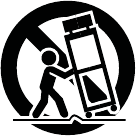
10
Important Safety Instructions
1. Read and keep these instructions. Heed all warnings and follow all Instructions.
2. Do not use this apparatus near water (if applicable).
3. Clean only with dry cloth.
4. Do not block any ventilation openings (if applicable). Install in accordance with
the manufacturer’s instructions. Do not install this equipment in a confined or
“boxed-in” space such as a bookcase or similar unit, and maintain good
ventilation conditions. The ventilation should not be impeded by covering the
ventilation openings with items such as newspaper, tablecloths, curtains, etc.
5. Do not install near any heat sources such as radiators, heat registers, stoves,
or other apparatus (including amplifiers) that produce heat. Do not place
exposed flame sources such as lighted candles on the apparatus.
6. Do not defeat the safety purpose of the polarized or grounding-type plug (if
applicable). A polarized plug has two blades with one wider than the other. A
grounding type plug has two blades and a third grounding prong. The wide blade
or the third prong is provided for your safety. If the provided plug does not fit into
your outlet, consult an electrician for replacement of the obsolete outlet.
7. (If applicable) Protect the power cord from being walked on or pinched
particularly at plugs, convenience receptacles, and the point where they exit
from the apparatus.
8. Only use attachment/accessories specified by the manufacturer.
9. Use only the cart, stand, tripod, bracket or table specified by the
manufacturer, or sold with the apparatus (if applicable). When a
cart is used, use caution when moving the cart/apparatus
combination to avoid injury from tip-over.
10. Unplug this apparatus during lightning storms or when unused for long periods
of time.
11. Refer all servicing to qualified service personnel. Servicing is required when
the apparatus has been damaged in any way, such as power-supply cord or
plug is damaged, liquid has been spilled or objects have fallen into the
apparatus, the apparatus has been exposed to rain or moisture, does not
operate normally, or has been dropped.
12. Power Sources (if applicable): This product should be connected to a power
supply only of the type described in these operating instructions, or as marked
on the unit.
13. Internal/External Voltage Selectors (if applicable): Internal or external voltage
selector switches, if any, should only be reset and re-equipped with a proper
plug for alternative voltage by a qualified service technician. Do not attempt to
alter this yourself.
14. Water and Moisture (if applicable): This product should be kept away from
direct contact with liquids. The apparatus shall not be exposed to dripping or
splashing and that no objects filled with liquids, such as vases, shall be placed
on the apparatus.

11
15. Caution (if applicable): Danger of explosion if battery is incorrectly replaced.
Replace only with the same or equivalent type. Batteries (a battery pack or an
installed battery) shall not be exposes to excessive heat such as sunshine, fire,
etc.
16. (If applicable) Where the mains plug or an appliance coupler is used as the
disconnect device, the disconnect device shall remain readily operable.
17. Protective earthing terminal (if applicable): The apparatus should be
connected to a mains socket outlet with a protective earthing connection.
•Denmark (Danmark): Apparatets stikprop skal tilsluttes en stikkontakt
med jord, som giver forbindelse til stikproppens jord.
• Finland (Suomi): Laite on liitettävä suojakoskettimilla varustettuun pistorasiaan.
•Norway (Norge): Apparatet må tilkoples jordet stikkontakt.
•Sweden (Sverige): Apparaten skall anslutas till jordat uttag.
18. (If applicable) This symbol means the equipment is a Class II or double-
insulated electrical appliance. It has been designed in such a way that it
does not require a safety connection to electrical earth.
19. Warning (if applicable): Provide an earthing connection before the mains plug
is connected to the mains. When disconnecting the earthing connection, be
sure to disconnect it after pulling the mains plug out from the mains.
20. This apparatus is for professional use only. Intended operational climate:
tropical, moderate.
21. (If applicable) When moving or not using the appliance, secure the power cord
(e.g., wrap it with a cable tie). Be careful not to damage the power cord.
Before using it again, make sure the power cord has not been damaged. If the
power cord has been damaged at all, bring the unit and cord to a qualified
service technician for repair or replacement as specified by the manufacturer.
22. Warning (if applicable): Excessive sound pressure (high volumes) from
headphones can cause hearing loss.
23. Warning (if applicable): Please refer to any important information (e.g.,
electrical, safety, etc.) printed on the exterior bottom enclosure or rear panel
before installing or operating the product.
Service Instructions
•Disconnect power cord before servicing.
•Replace critical components only with factory parts or recommended
equivalents.
•For AC line powered units: Before returning repaired unit to user, use an
ohmmeter to measure from both AC plug blades to all exposed metal parts.
The resistance should be more than 2,000,000 ohms.
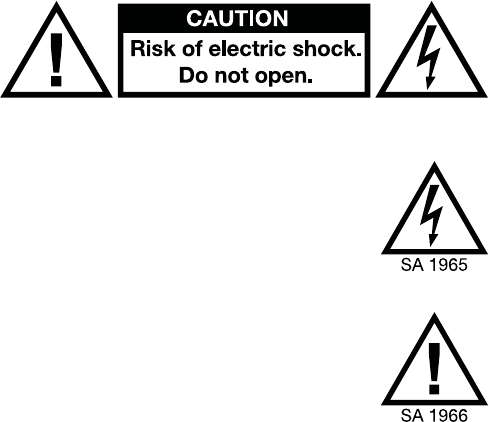
12
Safety Notices
CAUTION: TO REDUCE THE RISK OF
ELECTRIC SHOCK, DO NOT REMOVE
ANY COVER. NO USER- SERVICEABLE
PARTS INSIDE. REFER SERVICING TO
QUALIFIED SERVICE PERSONNEL ONLY.
DANGEROUS VOLTAGE: The lightning flash with arrowhead symbol within
the equilateral triangle is intended to alert the user to the presence of un-
insulated “dangerous voltage” within the product’s enclosure that may be of
sufficient magnitude to constitute a risk of electric shock.
INSTRUCTIONS: The exclamation point within the equilateral triangle is intended
to alert the user to the presence of important operating and maintenance
(servicing) instructions in the literature accompanying this appliance.
WARNING: To reduce the risk of fire or electrical shock, do not expose this appliance to rain
or moisture. Electrical equipment should NEVER be kept or stored in damp environments.
CAUTION (for U.S.A. & CANADIAN models only): TO PREVENT ELECTRIC SHOCK DO
NOT USE THIS (POLARIZED) PLUG WITH AN EXTENSION CORD, RECEPTACLE OR
OTHER OUTLET UNLESS THE BLADES CAN BE FULLY INSERTED TO PREVENT
BLADE EXPOSURE.
NOTICE CONCERNING LASER PRODUCTS: DANGER: INVISIBLE LASER RADIATION
WHEN OPEN AND INTERLOCK FAILED OR DEFEATED. AVOID DIRECT EXPOSURE TO
BEAM. USE OF CONTROLS OR ADJUSTMENTS OTHER THAN THOSE SPECIFIED
HEREIN MAY RESULT IN HAZARDOUS RADIATION EXPOSURE.
NOTICE CONCERNING FCC REGULATIONS: You are cautioned that changes or
modifications not expressly approved by the part responsible for compliance could void
the user’s authority to operate the equipment. This equipment has been tested and found
to comply with the limits for a Class B digital device, pursuant to Part 15 of the FCC rules.
These limits are designed to provide reasonable protection against harmful interference in
a residential installation. This equipment generates uses and can radiate radio frequency
energy and, if not installed and used in accordance with the instructions, may cause
harmful interference to radio communications. However, there is no guarantee that
interference will not occur in a particular installation. If this equipment does cause harmful
interference to radio or television reception, which can be determined by turning the
equipment off and on, the user is encouraged to try to correct the interference by one or
more of the following measures: (a) reorient or relocate the receiving antenna; (b) move this
unit; (c) increase the separation between the equipment and receiver; (d) connect the
equipment into an outlet on a circuit different from that to which the receiver is connected;
(e) be sure that all cables are properly shielded, using a choke or ferrite where appropriate;
or (f) consult the dealer or an experienced radio/television technician for help.

13
This device complies with Part 15 of the FCC rules. Operation is subject to the
following two conditions: (1) this device may not cause harmful interference,
and (2) this device must accept any interference received, including
interference that may cause undesired operation.
FCC RF Radiation Exposure Statement: 7KLVHTXLSPHQWFRPSOLHVZLWK)&&UDGLDWLRQ
H[SRVXUHOLPLWVVHWIRUWKIRUDQXQFRQWUROOHGHQYLURQPHQW0DLQWDLQDGLVWDQFHRIDWOHDVW
LQFKHVFHQWLPHWHUVRIVHSDUDWLRQEHWZHHQWKHWUDQVPLWWHU¶VUDGLDWLQJVWUXFWXUHVDQG
\RXUERG\RURWKHUSHRSOHQHDUE\
For Canadian models:
• This device complies with Industry Canada licence-exempt RSSs. Operation is
subject to the following two conditions: (1) this device may not cause interference,
and (2) this device must accept any interference, including interference that may
cause undesired operation of the device.
•Under Industry Canada regulations, this radio transmitter may only operate using an
antenna of a type and maximum (or lesser) gain approved for the transmitter by
Industry Canada. To reduce potential radio interference to other users, the antenna
type and its gain should be so chosen that the equivalent isotropically radiated
power (e.i.r.p.) is not more than that necessary for successful communication.
•This radio transmitter (identify the device by certification number, or model number
if Category II) has been approved by Industry Canada to operate with the antenna
types listed below with the maximum permissible gain and required antenna
impedance for each antenna type indicated. Antenna types not included in this list,
having a gain greater than the maximum gain indicated for that type, are strictly
prohibited for use with this device.
• This unit does not exceed the Class B limits for radio noise emission from digital
apparatus set out in the radio interference regulations of the Canadian Department
of Communications.
ESD/EFT Warning: This unit may contain a microcomputer for signal
processing and control functions. In very rare situations, severe interference,
noise from an external source, or static electricity may cause it to lock up. In
the unlikely event that this should happen, turn off the unit, wait at least five
seconds, and then turn it back on again. The pins of connectors identified with
this ESD warning symbol should not be touched.
For best audio quality, avoid using this device in a high RF-radiated environment. In an
environment with radio frequency interference, the unit may malfunction and resume
normal operation after removal of the interference.
For 240-volt use in U.K., use NEMA®-style 240-volt plug. For other countries use proper
plug for local outlet.
Double-Insulated: When servicing use only identical replacement parts.

14
Correct Disposal of This Product: This marking indicates that this product
should not be disposed with other household wastes throughout the EU. To
prevent possible harm to the environment or human health from uncontrolled
waste disposal, recycle it responsibly to promote the sustainable reuse of
material resources. To return your used device, please use the return and
collection systems or contact the retailer where the product was purchased.
They can take this product for environmentally safe recycling.
Disposal of Batteries (if applicable):
• Never dispose of any types of batteries in fire or near excessive heat or direct
sunlight. Overheated batteries can rupture or explode.
• If you are unsure of how or where to dispose of a battery, refer to your local
ordinances for the proper location, method, etc.
•Alkaline batteries & lithium button cell batteries: You can safely dispose of
alkaline and lithium button cell batteries with normal household waste. They do not
pose a health or environmental risk during normal use or disposal. (Alkaline batteries
are composed primarily of common metals like steel, zinc, and manganese.)
Do not dispose of large amounts of alkaline or lithium button cell batteries in a
group. Used batteries are often not completely “dead.” Grouping them together can
bring these “live” batteries into contact with one another, creating safety risks. To
avoid this, insulate each battery with tape or other non-conductive material to
ensure it does not discharge.
Proven cost-effective and environmentally safe recycling processes are not yet
universally available for alkaline and lithium button cell batteries. Some communities
offer recycling or collection of these batteries. For more information, refer to your
local ordinances or contact your local government.
•Lead-acid batteries: Dispose of lead-acid batteries by bringing them to an
electronic waste center or recycling center, or dispose of them in accordance with
your local ordinances. (Rechargeable lead-acid batteries are the same type used in
automobiles and should be disposed of in a similar fashion.)
California Proposition 65 Warning: This product may contain chemicals known to the
State of California to cause cancer and birth defects or other reproductive harm.
(California law requires this warning to be given to customers in the State of California.)
General Note on the Declaration of Conformity: We
hereby declare that this device is in accordance with the
essential requirements of the European Directive
2014/53/EU. The full EU declaration of conformity can be
requested at the address shown here or at
marantzpro.com/safety
inMusic GmbH
Harkortstr. 12 - 32
40880 Ratingen
GERMANY

15
Garantía del producto
(para productos adquiridos fuera de EE.UU.)
1. inMusic Brands, Inc. (“inMusic”) garantiza al comprador original que
todos los productos de Marantz Professional (“Marantz Pro”) están
libres de defectos de material y de mano de obra bajo su uso y servicio
normal por el período que comienza en la fecha de compra en un
vendedor autorizado por Marantz Pro y que continúa durante el tiempo
que sigue a esa fecha por un (1) año.
2. Esta Garantía Limitada está condicionada al uso adecuado del producto
por parte del comprador.
Esta Garantía Limitada no cubre: (a) defectos o daños que resultan de
accidentes, el uso incorrecto, abuso, negligencia, estrés físico o eléctrico
fuera de lo común, modificación de cualquier parte del producto o daño
cosmético; (b) equipos que tienen el número de serie retirado o ilegible; (c)
todas las superficies de plástico y otras partes expuestas externamente
que han sido rayadas o dañadas debido a su uso normal; (d) defectos o
daños debido a pruebas, operación, mantenimiento, instalación, ajustes o
reparación incorrectos de los productos.
3. Durante el período de garantía aplicable, Marantz Pro reparará o
cambiará, a su sola discreción, sin costo para el comprador, cualquier
componente defectivo del producto. Marantz Pro puede, bajo su sola
discreción, usar repuestos o componentes nuevos, reconstruidos o
renovados al reparar cualquier producto o cambiar un producto con un
producto nuevo, reconstruido, renovado o comparable.
4. LAS GARANTÍAS OTORGADAS EN ESTA GARANTÍA LIMITADA,
JUNTO CON CUALQUIER OTRA GARANTÍA IMPLÍCITA QUE CUBRA
LOS PRODUCTOS DE MARANTZ PRO, INCLUYENDO PERO NO
LIMITANDO NINGUNA GARANTÍA DE COMERCIO O DE UTILIDAD
PARA UN PROPÓSITO EN PARTICULAR, ESTÁN LIMITADAS A LA
DURACIÓN DE ESTA GARANTÍA LIMITADA. SALVO EN LA MEDIDA EN
QUE LO PROHÍBAN LAS LEYES APLICABLES, INMUSIC O MARANTZ
PRO NO SERÁ RESPONSABLE POR NINGÚN DAÑO ESPECIAL,
ACCIDENTAL, CONSECUENTE, INDIRECTO O SIMILAR, PÉRDIDA DE
GANANCIAS, DAÑOS A LA PROPIEDAD DEL COMPRADOR O
LESIONES AL COMPRADOR Ó A OTROS RESULTANTES DEL USO, EL
USO INCORRECTO O LA INCAPACIDAD DE USAR UN PRODUCTO DE
MARANTZ PRO, INCUMPLIMIENTO DE GARANTÍA O NEGLIGENCIA,
16
INCLUYENDO PERO NO LIMITADA A LA PROPIA NEGLIGENCIA DE
INMUSIC O MARANTZ PRO, AUNQUE INMUSIC, MARANTZ PRO O SU
AGENTE HAYAN SIDO ADEVERTIDOS DE TALES DAÑOS O POR
CUALQUIER DEMANDA PRESENTADA CONTRA EL COMPRADOR
POR CUALQUIER OTRA PARTE. ESTA GARANTÍA LIMITADA ES LA
GARANTÍA COMPLETA PARA LOS PRODUCTOS DE MARANTZ PRO Y
SE DA A CAMBIO DE TODAS LAS DEMÁS GARANTÍAS ESCRITAS.
ESTA GARANTÍA LIMITADA NO ALCANZARÁ A NINGUNA OTRA
PERSONA QUE NO SEA EL COMPRADOR ORIGINAL DEL PRODUCTO
Y ESTABLECE UNA REPARACIÓN EXCLUSIVA PARA EL
COMPRADOR. SI ALGUNA PARTE DE ESTA GARANTÍA LIMITADA ES
ILEGAL O INEXIGIBLE DEBIDO A ALGUNA LEY, TAL ILEGALIDAD
PARCIAL O INEXIGIBILIDAD NO AFECTARÁ AL CUMPLIMIENTO DEL
RESTO DE ESTA GARANTÍA LIMITADA QUE EL COMPRADOR
RECONOCE Y RECONOCERÁ SIEMPRE COMO LIMITADA POR SUS
TÉRMINOS O TAN LIMITADA COMO LO PERMITA LA LEY.
Esta Garantía Limitada distribuye el riesgo de fallos del producto entre el
comprador y Marantz Pro y los precios de los productos de Marantz Pro
reflejan esta distribución de riesgos y las limitaciones de las
responsabilidades contenidas en esta Garantía Limitada. Los agentes,
empleados, distribuidores y vendedores de Marantz Pro no están
autorizados para hacer modificaciones a esta Garantía Limitada o para
hacer garantías adicionales vinculantes para Marantz Pro o inMusic. Por lo
tanto, las declaraciones adicionales como la publicidad o presentaciones de
los vendedores, sea oral o por escrito, no constituyen garantías por Marantz
Pro o inMusic y no debieran ser fiables. Algunas jurisdicciones no permiten
limitaciones en cuanto a la duración de una garantía implícita, por lo que
puede que la limitación anterior no le aplique a usted. Esta garantía le otorga
derechos legales específicos y podría también disponer de otros derechos
que varían bajo las leyes municipales.
Por favor, escriba el número de serie de su unidad tal y como aparece en la
parte trasera del chasis y también el nombre del vendedor que se lo vendió.
Conserve esta información y su recibo de compra original para su referencia.
Visite nuestro sitio Web marantzpro.com para registrar su producto.
Modelo: Comprado en:
Número de serie: Fecha de compra:
17
Información sobre devoluciones
•Debe obtenerse un número de autorización de devolución (RMA) del
representante local de su fabricante. Para información sobre su
representante, visite marantzpro.com.
•Debe incluirse una copia del recibo original para que pueda repararse el
equipo en garantía.
•En caso de un equipo defectuoso, este debe ser embalado en su
embalaje original.
•Debe incluirse una capa de adicional de embalaje exterior para asegurar
la seguridad del producto. En caso de que no se siga este
procedimiento, el equipo podría estar desprotegido en tránsito y, por
tanto, se podría poner en peligro la garantía.
•Marantz Pro no aceptará envíos COD (contra reembolso) y no se ofrecerá
petición de servicio (call tag) para mercancías devueltas.
•Marantz Pro no devolverá mercancía reparada a los clientes mediante
servicio prioritario, a menos que exista una petición por escrito a
expensas del cliente. Las peticiones deben ser dirigidas por escrito junto
con la mercancía devuelta.
•El equipo defectuoso debería ser enviado al servicio de reparación local,
con los gastos de transporte pagados por adelantado junto con un
número de autorización de devolución (RMA) impreso con claridad en el
embalaje externo y el recibo de compra original.
Muy importante
Por favor, lea esta sección antes de conectar la unidad con su sistema
Para el funcionamiento óptimo:
•Todos los atenuadores se pueden desgastar. La fuerza excesiva del
utilizador puede desgastar rápidamente el atenuador. Los atenuadores
cambiados por el utilizador no son items con garantía.
•Nunca utilice los productos de limpieza en los controles de atenuadores.
Los residuos causan la acumulación excesiva de suciedad y ésto anulará
su garantía. Si los controles se hacen amenudo la unidad puede duran
muchos años. Si funcionan incorrectamente (generalmente debido a un
ambiente sucio o polvoriento) consulte a un técnico profesional.
•Sea siempre seguro de que la corriente alterna esté apagada mientras se
hace cualquier conexión.
18
•Utilice los cables adecuados a través de su sistema. No utilice los cables
excesivamente largos (por ejemplo más de 10 metros / 32 pies). Sea
seguro que los enchufes están conectados firmemente. Las conexiones
flojas pueden causar un ronquido, ruido o los intermitentes pueden dañar
fácilmente sus altavoces. Haga las conexiónes de entrada y salida con
los cables disponibles de estereofonia de bajo-capacitancia. La calidad
del cable hace la gran diferencia en la fidelidad audio y poder. Vea su
Marantz Pro distribuidor o un especialista en electrónica o en audio si
usted no está seguro de los cables que tiene que utilizar.
•Nunca procure reparar cualquier ajuste con excepción de los escritos en
este manual, o lleve la unidad a su distribuidor o a un centro de servicio
autorizado Marantz Pro.
•Recuerde siempre: encienda los amplificadores en el último y
apaguelos primero. Comience con los atenuadores principales o los
controles de volumen en mínimo y el control(es) del amplificador
gain/input tiene que estar al cero. Espera 8–10 segundos antes de subir
el volumen. Esto previene a corrientes transeúntes que puedan causar un
daño grave a los altavoces.
• Utilice con cuidado los controles. Intente moverlos lentamente. Los ajustes
rápidos podían dañar el equipo debido al truncamiento de amplificador.
•Evite el “truncamiento” del amplificador a toda costa: esto ocurre cuando
los LED rojos (generalmente en el panel delantero de la mayoría de los
amplificadores de potencia profesionales) comienzan a parpadear. El
“truncamiento” es cuando el amplificador de poder tuerce y funciona
más allá de sus límites. La distorsión dentro del amplificador es la causa
principal de la destrucción del altavoz.
• Para prevenir el peligro de fuego o de choque, no exponga la unidad a la
lluvia o a la humedad. Nunca coloque las latas de cerveza, soda, los cristales
de agua o cualquier cosa que puede mojar, cerca o encima de la unidad!
•Las salidas de los auriculares se pueden fijar en niveles que puedan
causar daño a sus oídos. Tenga cuidado.
• Este producto puede contener un microprocesador para el procesamiento de
las señales y las funciones de control. En situaciones excepcionales, las
interferencias acusadas, el ruido de una fuente externa o la electricidad
estática pueden hacer que se bloquee. En el caso poco probable de que esto
suceda, apagar el producto, esperar cinco segundos y volver a encenderlo.
•En raras circunstancias, si este producto se expone a la interferencia
electromagnética durante el uso, puede producirse una ligera
disminución de la relación señal-ruido.
•Ambientes electromagnéticos previstos: residencial, comercial, industria
liviana y exteriores urbanos.
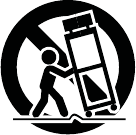
19
Instrucciones importantes de seguridad
1. Lea y conserve estas instrucciones. Preste atención a las advertencias y siga
todas las instrucciones.
2. No use este equipo cerca de agua (si es aplicable).
3. Límpielo sólo con un paño seco.
4. No bloquee las aberturas de ventilación (si es aplicable). Instale el equipo de
acuerdo con las instrucciones del fabricante. No instale este equipo en un
espacio confinado o “dentro de una caja” tal como una biblioteca o una
unidad similar, y mantenga buenas condiciones de iluminación. No debe
impedirse la ventilación cubriendo las aberturas correspondientes (si es
aplicable) con elementos tales como periódicos, manteles, cortinas, etc.
5. No instale el equipo cerca de fuentes de calor tales como radiadores,
aberturas de entrada de calefacción, calefactores u otros aparatos (incluidos
amplificadores) que generen calor. No coloque fuentes de llamas vivas tales
como velas encendidas en el aparato.
6. No anule la función de seguridad del enchufe tipo polarizado o con conexión a
tierra (si es aplicable). Un enchufe polarizado tiene dos patillas, una más ancha
que la otra. Un enchufe de tipo de conexión a tierra tiene dos patillas y una
clavija de puesta a tierra. La patilla ancha o la tercera clavija son para su
seguridad. Si el enchufe provisto no entra en su tomacorriente, consulte a un
electricista y solicítele el reemplazo del tomacorriente obsoleto.
7. (Si es aplicable) Proteja el cable de alimentación de modo que no lo pisen ni
quede estrangulado, particularmente en los enchufes, tomacorrientes y el
punto donde sale del equipo.
8. Use sólo agregados y accesorios especificados por el fabricante.
9. Use sólo el carrito, soporte, trípode, ménsula o mesa especificados
por el fabricante o vendidos con el equipo (si es aplicable). Si usa un
carrito, tenga cuidado al mover la combinación de carrito/equipo
para evitar que se vuelque y produzca lesiones.
10. Desenchufe este equipo durante las tormentas eléctricas o
cuando no lo use por períodos prolongados.
11. Solicite todo servicio a personal de servicio calificado. Se requiere servicio
cuando el equipo se dañó de cualquier manera, por ejemplo si se dañaron el
cable o el enchufe de alimentación, si se derramó líquido o cayeron objetos
dentro del equipo, si el mismo estuvo expuesto a la lluvia o la humedad, si no
funciona normalmente o se dejó caer.
12. Suministro eléctrico (si es aplicable): Conecte este producto solamente a un
suministro eléctrico del tipo que se describe en estas instrucciones de
operación o según se indique en la unidad.
13. Selectores de voltaje interno/externo (si es aplicable): Los conmutadores
selectores de voltaje interno y externo, si existen, solo deben ser reconfigurados
y reequipados con un enchufe adecuado para voltaje alternativo por un técnico
cualificado. No intente modificar esto usted mismo.

20
14. Agua y humedad (si es aplicable): Este producto se debe mantener fuera del
contacto directo con los líquidos. El aparato no debe ser expuesto al goteo o
a la salpicadura y ningun objeto lleno de líquidos, como serián los floreros,
debe ser colocados cerca del aparato.
15. Precaución (si es aplicable): Peligro de la explosión si la batería se substituye
incorrectamente. Substituir solamente por el mismo o el tipo equivalente. Las
baterías (un bloque de baterías o una batería instalada) no se deben exponer a
calor excesivo, tal como la luz solar, el fuego, etc.
16. (Si es aplicable) Cuando se usa el enchufe del suministro eléctrico o el
acoplador de un artefacto como dispositivo de desconexión, el mismo debe
permanecer listo a operar.
17. Terminal de conexión a tierra de protección (si es aplicable): El
artefacto debe conectarse a un tomacorriente del suministro eléctrico
con una conexión a tierra de protección.
18. (Si es aplicable) Este símbolo significa que el equipo es un artefacto
eléctrico Clase II o de doble aislamiento. Está diseñado de manera tal
que no requiere una conexión de seguridad a la tierra eléctrica.
19. Precaución (si es aplicable): Antes de conectar el cable de alimentación a la
corriente eléctrica, consiga una conexión a tierra. Además, a la hora de
desconectar esta toma de tierra, asegúrese de hacerlo después de haber
extraído el cable de alimentación del chasis.
20. Este aparato es para uso profesional únicamente. Climas de funcionamiento
previstos: tropical, moderado.
21. (Si es aplicable) Cuando traslade o no use el artefacto, sujete el cable de
alimentación (por ejemplo, envuélvalo con un precinto). Tenga cuidado de no
dañar el cable de alimentación. Antes de usarlo nuevamente, asegúrese de
que el cable de alimentación no esté dañado. Si dicho cable presenta algún
daño, lleve la unidad y el cable a un técnico de servicio calificado para
reparación o reemplazo según lo especifique el fabricante.
22. Advertencia (si es aplicable): La presión sonora excesiva (altos volúmenes) de
los auriculares puede causar pérdidas de audición.
23. Advertencia (si es aplicable): Antes de instalar u operar el producto, consulte
toda la información importante (como la relativa a electricidad, seguridad, etc.)
impresa en la envuelta inferior exterior o el panel trasero.
Las instrucciones de servicio
•Desconecte el cable eléctrico antes de empezar el servicio.
•Substituya los componentes críticos solamente por las piezas de la
fábrica o las piezas equivalentes recomendadas.
• Para las unidades accionadas por CA: Antes de devolver la unidad reparada al
utilizador, utilice un ohmímetro para medir entre las dos láminas del enchufe de CA
y todas las partes expuestas. La resistencia tiene que ser más de 2,000,000 ohms.
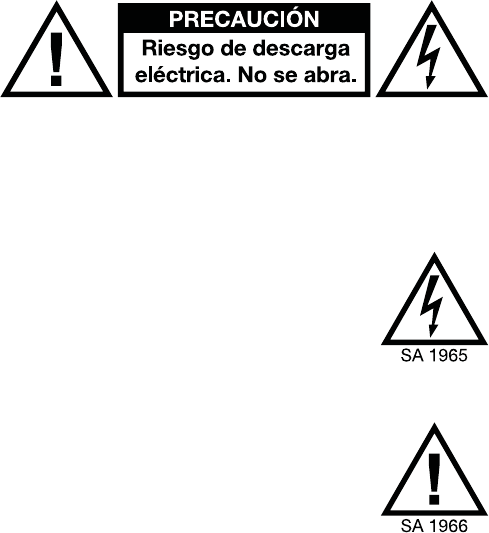
21
Señales de advertencia
PRECAUCIÓN: PARA REDUCIR EL
RIESGO DE DESCARGA ELÉCTRICA
NO QUITE NINGUN TAPADERO.
DENTRO DE LA UNIDAD NO HAY
COMPONENTES ÚTILES PARA EL
UTILIZADOR. PARA EL SERVICIO SE
DEBE DIRIGIRSE SOLAMENTE AL
PERSONAL DE SERVICIO CUALIFICADO.
VOLTAJE PELIGROSO NO AISLADO: La seña de relámpago con la punta
de la flecha dentro del triángulo equilátero está puesto para alertar al
utilizador de la presencia del “voltaje peligroso no aislado” dentro del recinto
de producto que puede tener la magnitud suficiente de correr un riesgo de
descarga eléctrica.
INSTRUCCIONES: El signo de exclamación, dentro del triángulo equilátero,
es para alertar el utilizador de la presencia de las instrucciones importantes
de funcionamiento y de mantenimiento (servicio) en la literatura que
acompaña este dispositivo.
ADVERTENCIA: Para reducir el riesgo de incendio o descarga eléctrica, no exponga
este aparato a la lluvia o a la humedad. Los equipos eléctricos NUNCA deberían
guardarse o almacenarse en ambientes húmedos.
SOLO PARA LOS MODELOS DE LOS EE.UU. Y CANADÁ: PARA EVITAR DESCARGAS
ELÉCTRICAS, NO UTILICE ESTE ENCHUFE (POLARIZADO) CON UN CABLE DE
EXTENSIÓN, RECEPTÁCULO U OTRA TOMA DE CORRIENTE A MENOS QUE LAS
PALAS DEL ENCHUFE PUEDAN SER INSERTADAS POR COMPLETO PARA EVITAR
SOBREEXPOSICIÓN.
AVISO SOBRE LOS PRODUCTOS LÁSER: PELIGRO: RADIACIÓN LÁSER INVISIBLE
CUANDO ESTÁ ABIERTO Y EL BLOQUEO FALLA O ES INUTILIZABLE. EVITE LA
EXPOSICIÓN DIRECTA AL HAZ. EL USO DE CONTROLES O AJUSTES NO
ESPECIFICADOS AQUÍ PUEDE RESULTAR EN LA RADIOEXPOSICIÓN PELIGROSA.
AVISO SOBRE LAS REGULACIONES DEL FCC (Federal Communications
Commission): Este equipo genera y usa energía de radiofrecuencia y puede causar
interferencia en la recepción de radio y de televisión si no la opera estrictamente según
los procedimientos detallados en este manual de operación. Esta unidad cumple con las
reglas de aparatos informáticos de Clase B en conformidad con las especificaciones en
la Subparte J o Parte 15 de las Reglas FCC, que están diseñadas para proporcionar una
protección razonable contra tal interferencia en una instalación residencial. Sin embargo,

22
no existen garantías de que no ocurrirá una interferencia en una instalación específica. Si
la unidad causa interferencia en alguna recepción de radio o de televisión, intente
reducirla realizando uno o más de los siguientes métodos: (a) reposicione la otra unidad
y/o su antena, (b) mueva esta unidad, (c) deje más espacio entre esta unidad y la(s)
otra(s) unidad(es), (d) enchufe esta unidad a una toma de corriente alterna diferente para
que esté en un circuito diferente al de los demás equipos o (e) asegúrese que todos los
cables estén blindados correctamente, usando un inductor o ferrite cuando sea
adecuado. Esta nota está en conformidad con la Sección 15.838 de las Reglas de FCC.
Declaración sobre exposición a las radiaciones de RF según normas de la FCC:
(VWHHTXLSRFXPSOHORVOtPLWHVGHH[SRVLFLyQDODUDGLDFLyQHVWDEOHFLGRVSRUOD)&&SDUD
XQ DPELHQWH QR FRQWURODGR 0DQWHQJD XQD GLVWDQFLD GH DO PHQRV FHQWtPHWURV
SXOJDGDV HQWUH ODV HVWUXFWXUDV GH ORV WUDQVPLVRUHV TXH LUUDGLDQ UDGLRIUHFXHQFLDV \ VX
FXHUSRXRWUDVSHUVRQDVHQODVFHUFDQtDV
Advertencia ESD/EFT: Este producto puede contener un microprocesador
para el procesamiento de las señales y las funciones de control. En
situaciones excepcionales, las interferencias acusadas, el ruido de una fuente
externa o la electricidad estática pueden hacer que se bloquee. En el caso
poco probable de que esto suceda, apagar el producto, esperar cinco
segundos y volver a encenderlo.
Para obtener la mejor calidad de audio, evite usar este dispositivo en ambientes con
radiaciones intensas de RF. En un ambiente con interferencia de radiofrecuencia, la
unidad puede funcionar incorrectamente y reanudar el funcionamiento normal después
de la desaparición de la interferencia.
Esta unidad no excede los límites de la Classe B para la emisión de ruidos radioeléctricos de
aparatos digitales incluidos en las regulaciones de perturbación radioeléctrica del
Departamento de comunicaciones de Canadá (Canadian Department of Communications).
Para el uso de 220 voltios en U.K., use un enchufe de 220 voltios de estilo NEMA®. Para
otros países, use el enchufe adecuado para la toma de corriente local.
Doble aislamiento: Para la reparación, utilice solo repuestos idénticos.
Disposición final correcta de este producto: Esta marca indica que ese
producto no debe desecharse junto con otros desperdicios domésticos en
toda la Unión Europea. Para evitar posibles daños al medio ambiente o a la
salud humana debidos a la disposición final sin control de los residuos,
recíclelo responsablemente a fin de promover la reutilización sustentable de
los recursos materiales. Para devolver su producto usado, use los sistemas de
devolución o recolección o póngase en contacto con el comercio minorista
donde adquirió dicho producto. El mismo puede recibir este producto para un
reciclado ambientalmente seguro.

23
Disposición final de pilas (si aplica):
• Nunca deseche pilas de ningún tipo en el fuego o cerca de fuentes de calor excesivo o
luz solar directa. Las pilas sobrecalentadas pueden romperse o explotar.
• Si no está seguro de cómo o dónde desechar una pila, consulte la ubicación,
método, etc. apropiados en sus reglamentos locales.
• Pilas alcalinas y baterías de celda de litio tipo botón: Puede desechar las pilas
alcalinas y las pilas de celda de litio tipo botón junto con los desechos normales del
hogar. No presentan un riesgo a la salud o al medioambiente durante el uso o
disposición final normal. (Las pilas alcalinas están compuestas principalmente de
metales comunes tales como acero, zinc y manganeso).
No deseche grandes cantidades de pilas alcalinas o pilas de celda de litio tipo
botón en grupo. Las pilas usadas a menudo no están completamente “agotadas”.
Si se agrupan, estas pilas “activas” pueden entrar en contacto entre sí y crear
riesgos para la seguridad. Para evitar esto, aísle cada pila con cinta u otro material
no conductor para asegurarse de que no se descargue.
No se dispone aún a nivel universal de procesos de reciclaje probados, rentables y
seguros para el medio ambiente aplicables a las pilas alcalinas y a las pilas de celda
de litio tipo botón. Algunas comunidades ofrecen el reciclado o recolección de
estas pilas. Para obtener más información, consulte sus reglamentos locales o
contacte a su gobierno local.
• Baterías de plomo-ácido: Deseche las pilas de plomo-ácido llevándolas a un centro
de residuos electrónicos o a un centro de reciclaje, o deséchelas de acuerdo a sus
reglamentos locales. (Las pilas de plomo-ácido recargables son del mismo tipo que
las que se usan en los automóviles y deben desecharse de la misma manera).
Advertencia de la Proposición 65 de California: Este producto puede contener
sustancias químicas que el Estado de California reconoce que pueden causar cáncer y
defectos de nacimiento u otros daños reproductivos. (La ley de California requiere que
esta advertencia sea dada a los clientes en el Estado de California.)
Observación general sobre la declaración de
conformidad: Por el presente declaramos que este
dispositivo se encuentra en conformidad con los
requisitos esenciales de la Directiva Europea
2014/53/EU. La declaración de conformidad completa
de la UE se puede solicitar a la dirección que se
muestra aquí o a marantzpro.com/safety
inMusic GmbH
Harkortstr. 12 - 32
40880 Ratingen
A
LEMANI
A

24
Garantie du produit
(pour les produits achetés à l’extérieur
des États-Unis d’Amérique)
1. inMusic Brands, Inc. (« inMusic ») garantit à l’acheteur initial que les
produits Marantz Professional (« Marantz Pro ») sont exempts de tout
défaut de matériel ou de main-d’œuvre sous des conditions normales
d’utilisation pour une période d’un (1) an à compter de la date de l’achat
effectué chez un distributeur Marantz Pro autorisé.
2. La présente garantie limitée ne s’applique que sous une utilisation
adéquate du produit par l’acheteur.
La présente garantie limitée ne couvre pas les éléments suivants : (a) les
défectuosités ou les dommages découlant d’un accident, d’un usage
abusif, d’une mauvaise utilisation, de négligence, de contraintes
physiques, électriques inhabituelles, de modification de l’une ou l’autre
partie du produit ou dommages d’ordre esthétique; (b) un équipement
dont le numéro de série a été supprimé ou rendu illisible; (c) toutes les
surfaces de plastique et autres pièces exposées qui sont égratignées ou
endommagées à la suite d’un usage normal; (d) les défectuosités ou les
dommages découlant d’essais, d’une utilisation, d’un entretien, d’une
installation, réglage ou réparation inadéquat des produits.
3. Au cours de la période de garantie applicable, Marantz Pro réparera ou
à remplacera, à sa seule discrétion et sans frais pour l’acheteur, tous
composant défectueux du produit. Marantz Pro peut, à sa seule
discrétion, utilisée des pièces ou composants neufs, remis en état ou
remis à neuf lors de la réparation de tous produits ou encore de
remplacer ledit produit par un produit neuf, comparable, remis en état
ou remis à neuf.
4. LES GARANTIES ACCORDÉES DANS LE CADRE DE LA PRÉSENTE
GARANTIE LIMITÉE, AINSI QUE TOUTES LES GARANTIES IMPLICITES
COUVRANT LES PRODUITS MARANTZ PRO, INCLUANT SANS
LIMITATION TOUTES GARANTIE DE QUALITÉ MARCHANDE OU DE
CONVENANCE À UN USAGE PARTICULIER, ET SONT LIMITÉES À LA
DURÉE DE LA PRÉSENTE GARANTIE LIMITÉE. SAUF DANS LA MESURE
INTERDITE PAR LES LOIS APPLICABLES, INMUSIC OU MARANTZ PRO
NE POURRA ÊTRE TENUE POUR RESPONSABLE DE TOUS DOMMAGES
SPÉCIAUX, INDIRECTS, CONSÉCUTIFS OU AUTRES DOMMAGES
SIMILAIRES, DE TOUTES PERTES DE BÉNÉFICES, DE DOMMAGES AUX
BIENS DE L’ACHETEUR OU DE BLESSURES À L’ACHETEUR OU À DES
25
TIERS DÉCOULANT DE L’UTILISATION, DE L’USAGE ABUSIF OU DE
L’INCAPACITÉ D’UTILISER TOUS PRODUIT MARANTZ PRO, D’UN NON-
RESPECT DE GARANTIE, OU DE NÉGLIGENCE, INCLUANT MAIS NON
LIMITÉE À LA NÉGLIGENCE, MÊME SI INMUSIC, MARANTZ PRO OU SES
AGENTS ONT ÉTÉ AVISÉS DE LA POSSIBILITÉ DE TELS DOMMAGES,
OU DE TOUTE RÉCLAMATION DÉPOSÉE CONTRE L’ACHETEUR PAR
UNE AUTRE PARTIE. CETTE GARANTIE LIMITÉE CONTIENT L’ENTIÈRE
GARANTIE POUR LES PRODUITS MARANTZ PRO ET DEMEURE À LA
PLACE DE TOUTE AUTRE GARANTIE EXPRÈS. LA PRÉSENTE GARANTIE
LIMITÉE NE POURRA S’ÉTENDRE À TOUTE PERSONNE AUTRE QUE LE
PREMIER ACHETEUR ET ÉNOUNCE LES RECOURS EXCLUSIFS DE
L’ACHETEUR. SI UNE PARTIE DE LA PRÉSENTE GARANTIE LIMITÉE EST
ILLÉGALE OU INAPPLICABLE EN RAISON D’UNE LOI, LADITE PARTIE
ILLÉGALE OU INAPPLICABLE N’AURA AUCUN EFFET SUR
L’APPLICABILITÉ DU RESTE DE LA GARANTIE LIMITÉE, QUE
L’ACHETEUR RECONNAÎT COMME ÉTANT ET DEVANT TOUJOURS
ÊTRE JUGÉE LIMITÉE PAR SES MODALITÉS OU DANS LA MESURE
PERMISE PAR LA LOI.
La présente garantie limitée partage le risque des défectuosités de produit
entre l’acheteur et Marantz Pro, et les prix d’Marantz Pro reflètent ce
partage de risque et les limitations de responsabilité contenues dans la
présente garantie limitée. Les agents, employés, distributeurs et marchands
d’Marantz Pro ne sont pas autorisés à apporter des modifications à la
présente garantie limitée, ni à offrir des garanties additionnelles pouvant lier
Marantz Pro ou inMusic. En conséquence, les déclarations supplémentaires
comme la publicité ou les représentations des marchands, verbales ou
écrites, ne constituent pas des garanties d’Marantz Pro ou d’inMusic et
n’ont aucun effet. Certaines juridictions ne permettent pas de limitations sur
la durée d’une garantie tacite, il se peut donc que les limitations ci-dessus
ne s’appliquent pas à votre cas. La présente garantie vous confère des
droits spécifiques, il se pourrait que vous ayez d’autres droits, lesquels
peuvent varier d’une juridiction à l’autre.
Veuillez inscrire le numéro de série de votre appareil tel qu’il est indiqué au
dos du châssis ainsi que le nom du marchand d’où vous l’avez acheté.
Conservez cette information ainsi que votre facture originale afin de pouvoir
les consulter ultérieurement. Allez sur notre site Internet marantzpro.com
pour enregistrer votre produit.
Modèle : Détaillant :
Numéro de série : Date d’achat :
26
Politique de retour de marchandise
•Vous devez d’abord obtenir un numéro d’autorisation de retour de
marchandise (RMA) de votre représentant autorisé. Pour obtenir les
coordonnées de votre représentant autorisé vous pouvez aller au site
Internet marantzpro.com.
•Vous devez faire parvenir une copie de la facture originale du produit
pour lequel vous demandez une réparation sous garantie.
•Le produit défectueux pour lequel vous demandez une réparation sous
garantie doit être emballé dans son emballage original.
• Pour assurer la sécurité du produit, ajoutez un emballage supplémentaire. À
défaut de respecter cette condition, le produit pourrait être inadéquatement
protégé pour le transport et pourrait compromettre la garantie.
• Marantz Pro n’accepte aucune livraison contre remboursement (COD) et
aucune étiquette de rappel ne sera délivrée pour le retour de marchandise.
•Marantz Pro ne renvoie pas la marchandise réparée aux clients par
service prioritaire, à moins qu’une demande soit faite par écrit et que les
frais soient à la charge du client. Les demandes doivent être faites par
écrit et soumises avec la marchandise retournée.
•Les produits défectueux doivent être retournés au centre de service le
plus près avec le fret payé d’avance, le numéro d’autorisation de retour
de marchandise (RMA) indiqué clairement sur l’emballage ainsi que la
facture originale du produit.
Tres important
Lisez cette section avant de connecter cette unité au système.
Pour une performance optimale :
•Tous le potentiomètres de réglage qui sont sujets à l’usure doivent être
utilisés. La force excessive peut rapidement faire sortir de l’usage le
potentiomètre de réglage. Les potentiomètres de l’utilisateur ne sont pas
des parties de la garantie.
• N’utilisez jamais de sprays nettoyants sur les potentiomètres de réglage.
Les résidus causent une agglomération de saleté et cela peut annuler votre
garantie. Si on l’utilise normalement le potentiomètre de réglage peut
fonctionner pendant plusieurs années. En cas de mal fonctionnement
(d’habitude causé par un environnement sale ou poussiéreux) consultez un
technicien professionnel.
•Soyez sûrs que la source d’alimentation n’est pas branché quand vous
faites des connections.
27
• Utilisez des câbles propres dans tout le système. N’utilisez pas des câbles
trop longues (i.e. plus de 10 mètres / 32 pieds). Soyez sûrs que les câbles
et les prises sont connectées durablement. Sinon ils peuvent causer du
bruit ou des intermittences qui peuvent faire des dommages aux haut-
parleurs. Faites les connexions input et output avec des câbles stéréo de
capacité réduite. La qualité du câble fait la différence dans la fidélité audio.
Consultez un représentant Marantz Pro ou un spécialiste en électronique
ou audio si vous avez des doutes quand vous choisissez les câbles.
•N’essayez jamais de faire des ajustements ou réparations autres que
ceux décrits dans ce manuel. Amenez votre unité à votre dealer dans un
Centre Service Marantz Pro autorisé.
•Rappelez-vous : connectez dernierement les amplificateurs et
debranchez les en premier. Commencez avec les potentiomètres de
réglage master ou les contrôleurs de volume sur le minimum de
l`amplificateur. Attendez de 8 à 10 secondes avant d’élever le volume.
Cela prévient les éventuels dommages causés sur le haut-parleur.
•Usez de la restriction en opérant les contrôles. Essayez de les bouger
doucement. Les ajustements rapides peuvent causer du dommage à
l’équipement dû au coupage d’amplificateur.
• Evitez à tout coût les coupures de l’amplificateur : cela apparaît quand les
LEDs rouges (d’habitude sur la façade des amplificateurs professionnels)
commencent a faire des flashes. Les « coupures » arrivent quand
l’amplificateur fonctionne sous ses limites. La distorsion des amplificateurs
est la principale cause du mal fonctionnement du haut-parleur.
•Pour éviter le feu ou les chocs, n’exposez pas l’unité à la pluie ou à
l’humidité. Ne placez jamais de boîtes de bière, soda ou des verres d’eau
près ou sur l’unité!
•Les niveaux des casques peuvent être réglés à un niveau qui peut causer
des dommages à vos oreilles. Utilisez – les avec précaution.
• Ce produit peut contenir un micro-ordinateur pour le traitement des
signaux et les fonctions de contrôle Rarement, des graves interférences,
du bruit provenant d’une source extérieure ou l’électricité statique peuvent
le bloquer. Si cet événement très rare se produit, débranchez le produit,
attendez cinq secondes au moins puis branchez de nouveau l’appareil.
•Sous certaines conditions, lorsque ce produit est utilisé en présence
d’interférences électromagnétiques, il pourrait y avoir une augmentation
des bruits parasitaires.
•Environnements électromagnétiques destinés : milieux résidentiels,
commerciaux, industriels légers et extérieurs urbains.
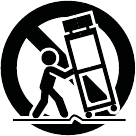
28
Instructions importantes de sécurité
1. Lire et conserver les instructions qui suivent. Respecter tous les avertissements
et suivre toutes les instructions fournies.
2. Ne pas utiliser cet appareil à proximité des sources d’eau (le cas échéant).
3. Nettoyer seulement avec un chiffon doux sec.
4. Ne pas obstruer les orifices de ventilation. Installer conformément aux
instructions du fabricant (le cas échéant). Cet appareil ne doit pas être installé
dans un endroit confiné tel qu’une bibliothèque ou un meuble fermé. Veillez à
ce que la ventilation soit adéquate. Veillez à ne pas bloquer les orifices de
ventilation (le cas échéant) avec des journaux, nappes, rideaux, etc.
5. Ne pas installer près des sources de chaleur telles que radiateurs, les registres
de chaleur, poêles ou autres appareils (y compris les amplificateurs) qui
génèrent de la chaleur. Ne pas placer de sources de flammes nues telles que
des chandelles allumées sur l’appareil.
6. Ne pas casser l’élément de sécurité de la fiche polarisée ou de mise à la terre
(le cas échéant). Une fiche polarisée est dotée de deux lames, une étant plus
large que l’autre. Une fiche de mise à la terre est dotée de deux lames et d’une
broche de mise à la terre. La lame plus large ou la troisième broche est pour
votre sécurité. Si la fiche ne s’insère pas dans la prise murale, consulter un
électricien pour qu’il vienne remplacer la prise adéquate.
7. (Le cas échéant) Protéger le câble d’alimentation de sorte à ne pas pouvoir
marcher dessus ou à coincer les fiches au niveau des connexions et au point
de sortie de l’appareil.
8. N’utiliser que des accessoires recommandés par le fabricant.
9. Utiliser uniquement un socle, un support, un trépied, une console
ou une table recommandés par le fabricant ou vendus avec
l’appareil (le cas échéant). Lorsqu’un socle est utilisé, déplacer
l’ensemble appareil-socle avec soin pour éviter de le faire basculer.
10. Débrancher l’appareil durant les orages ou lorsque non utilisé pendant de
longues périodes.
11. Confier la réparation à du personnel technique qualifié. Faire réparer lorsque
l’appareil est endommagé; lorsque le câble ou la fiche d’alimentation est
endommagé, lorsqu’on a renversé du liquide ou si des objets sont tombés
dans l’appareil, lorsque l’appareil a été exposé à de la pluie ou à de l’humidité,
si l’appareil ne fonctionne pas normalement, ou lorsqu’il est tombé.
12. Sources d’alimentation (le cas échéant) : Cet appareil doit être alimenté
uniquement par le type de source de courant indiqué dans le guide
d’utilisation, ou tel qu’indiqué sur le produit.
13. Sélecteurs de tension interne/externe (le cas échéant) : Les sélecteurs de
tension interne ou externe, s’il y en a, doivent être réinitialisés et équipés avec
une fiche adéquate par un technicien qualifié. Ne jamais tenter de modifier
ceci vous-même.

29
14. Eau et humidité (le cas échéant) : Ce produit dot être placé loin du contact
direct avec des liquides. L’appareil ne doit pas être exposé à graisse ou gouttes
et les objets remplis, comme les vases ne doivent être placés sur l’appareil.
15. Attention (le cas échéant) : Danger d’explosion si la batterie est inexactement
remplacée. Remplacer seulement avec la même chose ou le type équivalent.
Les piles (un bloc-piles ou une pile) ne doivent pas être exposées à une
chaleur excessive comme la lumière directe du soleil, le feu, etc.
16. (Le cas échéant) Lorsqu’une prise de branchement ou un coupleur d’appareils
est utilisé comme dispositif de débranchement, ce dispositif de débranchement
devra demeurer pleinement fonctionnel avec raccordement à la masse.
17. Borne de terre de protection (le cas échéant) : Par mesure de sécurité,
l’appareil doit être branché à une prise de courant comprenant une
borne de mise à la terre.
18. (Le cas échéant) Ce symbole signifie que l’appareil est de classe II ou
possède une double isolation électrique. Il est conçu de manière à ce
que l’utilisation d’une prise de terre ou de masse n’est pas requise.
19. Attention (le cas échéant) : Veuillez vous assurer que l’appareil soit mis à la terre
avant de connecter la fiche au secteur. De la même façon, assurez-vous que la
terre soit déconnectée en dernier lorsque vous déconnectez la prise du secteur.
20. Cet appareil est destiné à un usage professionnel. Climat opérationnel prévu :
tropical, modéré.
21. (Le cas échéant) Veillez à toujours fixer le câble d’alimentation lors du déplacement
de l’appareil ou lorsqu’il n’est pas utilisé. Veillez à ne pas endommager le câble
d’alimentation. Vérifiez toujours le câble d’alimentation avant d’utiliser l’appareil. Si
le câble d’alimentation est endommagé de quelconque façon, faites vérifier
l’appareil et le câble d’alimentation par un technicien qualifié recommandé par le
fabricant afin de les faire réparer ou replacer.
22. Mise en garde (le cas échéant) : Une pression sonore excessive (volume
élevé) provenant du casque d’écoute peut entraîner une perte auditive.
23. Mise en garde (le cas échéant) : Veuillez vous reporter aux importantes
informations (p. ex., informations électriques, de sécurité, etc.) imprimées sur
le dessous ou le panneau arrière de l’unité avant de procéder à son installation
ou à son utilisation.
Instructions de service
•Déconnectez l’appareil avant le service.
•Remplacez les components seulement avec des components de la
fabrique ou avec des équivalents recommandés.
•Pour les unités AC (courant alternatif), avant de retourner l’unité réparé, utilisez
un ohmmètre pour mesurer la résistance d’isolement (mesure entre les 2
broches de la prise de courant). La résistance devrait être supérieure à
2.000.000 ohms.
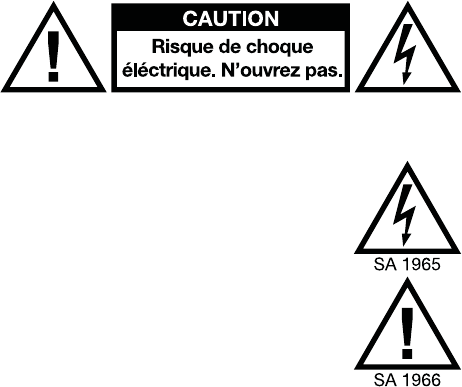
30
Avis de sécurité
CAUTION : POUR REDUIRE LE RISQUE DE
CHOQUE ELECTRIQUE N’ELOIGNEZ PAS
LA COUVERTURE. PAS DE COMPONENTS
UTILISABLES AU SERVICE A L’INTERIEUR.
DEMANDEZ SERVICE SEULEMENT AU
PERSONNEL QUALIFIE.
VOLTAGE DANGEREUX : Quand le flash avec le symbole d’une flèche dans le
triangle équilatéral est allumé il signale la présence d’un « voltage dangereux »
dans le produit qui est suffisant pour constituer un risque de choc électrique.
INSTRUCTIONS : Le signe d’exclamation dans le triangle équilatéral signale à
l’utilisateur la présence des instructions importantes pour le fonctionnement et
la maintenance de ce produit.
MISE EN GARDE : Afin de réduire les risques d’incendie ou d’électrocution, ne pas
exposer cet appareil à la pluie ou à l’humidité. Tout équipement électrique ne devrait
jamais être placé ou remisé dans un environnement humide.
POUR LES MODÈLES AMÉRICAINS ET CANADIENS SEULEMENT : POUR ÉVITER
TOUT RISQUE ÉLECTROCUTION, NE PAS UTLISER CETTE FICHE POLARISÉE AVEC
UN PROLONGATEUR, UNE PRISE DE COURANT OU UNE AUTRE SORTIE DE
COURANT, SAUF SI LES LAMES PEUVENT ÊTRE INSERRÉES À FOND SANS EN
LAISSER AUCUNE PARTIE À DÉCOUVERT.
AVIS CONCERNANT LES PRODUITS LASER : DANGER : RADIATION INVISIBLE QUAND
L’APPAREIL EST OUVERT OU QUE LE VERROUILLAGE EST EN PANNE OU DÉSACTIVÉ.
ÉVITER UNE EXPOSITION DIRECTE AU RAYON. L’UTILISATION DE COMMANDES OU DE
RÉGLAGES AUTRES QUE CELLES INDIQUÉES CI-DESSUS PEUVENT AVOIR COMME
CONSÉQUENCE UNE EXPOSITION DANGEREUSE DE RADIATION.
AVIS CONCERNANT LA RÉGLEMENTATION FCC (Commission Fédérale américaine
des Communications ou CCE): Cet équipement génère et utilise de l’énergie sur des
fréquences radio et peut causer des interférences à la réception des programmes radio
et télévision si vous ne l’utilisez pas dans une stricte concordance avec les procédures
détaillées dans ce guide de fonctionnement. Cette unité est conforme aux normes de
Classe B en accord avec les spécifications des sous paragraphe J ou de l’article 15 de la
réglementation FCC, qui sont désignées à offrir une protection raisonnable contre de
telles interférences dans une installation résidentielle. Toutefois, il n’est pas garanti
qu’aucune interférence n’apparaisse dans des installations particulières. Si l’unité cause
des interférences avec la réception de la radio ou de la télévision, vous pouvez essayer
de les corriger en utilisant une ou plusieurs des mesures suivantes : (a) repositionnez
l’autre appareil et/ou son antenne, (b) déplacez cet appareil, (c) éloignez cet appareil le
plus loin possible de l’autre appareil, (d) branchez cet appareil dans une autre prise AC,
de cette façon, ils seront sur des circuits différents ou (e) assurez vous que tous les
câbles soient blindés à l’aide d’une bobine d’arrêt ou ferrite, où nécessaire. Cet avis est
conforme à l’article 15.838 de la réglementation FCC.

31
Le présent appareil est conforme aux l’article 15 de la réglementation FCC.
L’exploitation est autorisée aux deux conditions suivantes : (1) l’appareil ne
doit pas produire de brouillage, et (2) l’utilisateur de l’appareil doit accepter
tout brouillage radioélectrique subi, même si le brouillage est susceptible d’en
compromettre le fonctionnement.
Énonce sur l’exposition au rayonnement de fréquence radio de la FCC : &HW
pTXLSHPHQWHVWFRQIRUPHDX[OLPLWHVG¶H[SRVLWLRQDXUD\RQQHPHQWGHIUpTXHQFHUDGLRGH
OD )&& pWDEOLHV SRXU XQ HQYLURQQHPHQW QRQ FRQWU{Op 8QH GLVWDQFH GDX PRLQV
FHQWLPqWUHVGRLWrWUHPDLQWHQXHHQWUHOHVpOpPHQWVUD\RQQDQWVGHOpPHWWHXUHWOHFRUSVGH
OXWLOLVDWHXURXOHVSHUVRQQHVVHWURXYDQWjSUR[LPLWp
Pour les modèles Canadiens :
• Le présent appareil est conforme aux CNR d’Industrie Canada applicables aux
appareils radio exempts de licence. L’exploitation est autorisée aux deux conditions
suivantes : (1) l’appareil ne doit pas produire de brouillage, et (2) l’utilisateur de
l’appareil doit accepter tout brouillage radioélectrique subi, même si le brouillage est
susceptible d’en compromettre le fonctionnement.
• Conformément à la réglementation d’Industrie Canada, le présent émetteur radio peut
fonctionner avec une antenne d’un type et d’un gain maximal (ou inférieur) approuvé
pour l’émetteur par Industrie Canada. Dans le but de réduire les risques de brouillage
radioélectrique à l’intention des autres utilisateurs, il faut choisir le type d’antenne et
son gain de sorte que la puissance isotrope rayonnée équivalente (p.i.r.e.) ne dépasse
pas l’intensité nécessaire à l’établissement d’une communication satisfaisante.
• Le présent émetteur radio (identifier le dispositif par son numéro de certification ou son
numéro de modèle s’il fait partie du matériel de catégorie I) a été approuvé par Industrie
Canada pour fonctionner avec les types d’antenne énumérés ci-dessous et ayant un
gain admissible maximal et l’impédance requise pour chaque type d’antenne. Les
types d’antenne non inclus dans cette liste, ou dont le gain est supérieur au gain
maximal indiqué, sont strictement interdits pour l’exploitation de l’émetteur.
• Cet appareil n’excede pas les limites de la Classe B pour les émissions des
fréquences radio à partir d’un appareil numérique établit par le Ministère des
communications.
Avertissement ESD/EFT : Ce produit peut contenir un micro-ordinateur pour le
traitement des signaux et les fonctions de contrôle Rarement, des graves
interférences, du bruit provenant d’une source extérieure ou l’électricité statique
peuvent le bloquer. Si cet événement très rare se produit, débranchez le
produit, attendez cinq secondes au moins puis branchez de nouveau l’appareil.
Pour une meilleure qualité audio, évitez d’utiliser cet appareil dans un environnement
irradié de fréquences radio. Lorsqu’utilisé en présence d’interférences aux fréquences
radio électriques, l’appareil pourrait défaillir et reprendre un fonctionnement normal une
fois les interférences supprimées.

32
Utilisez une prise de modèle NEMAMD de 220 volts pour utiliser avec une tension secteur
de 220V au U.K. Pour les autres pays, utliser une prise secteur adéquate pour cette
tension de secteur.
Double isolation : Lors de réparation, utilisez uniquement des pièces de remplacement
identiques.
Mise au rebut convenable de ce produit : Ce repère indique que ce produit
ne doit pas être mis au rebut dans l’UE avec d’autres ordures ménagères. Afin
d’éviter tout dommage potentiel pour l’environnement ou la santé humaine
résultant d’une élimination incontrôlée des déchets, recyclez-le de façon
responsable afin de promouvoir la réutilisation durable des ressources
matérielles. Pour remettre votre appareil usagé, veuillez utiliser les systèmes
de remise et de collecte ou contacter le vendeur où le produit a été acheté.
Ceux-ci pourront assurer le recyclage écologique de ce produit.
Élimination des piles (le cas échéant) :
•Ne jamais jeter de piles d’aucun type au feu ou à proximité de toute source de
chaleur excessive ou de la lumière directe du soleil. Les piles surchauffées peuvent
se rompre ou exploser.
•En cas d’incertitude sur la façon appropriée et l’endroit où disposer des piles, se
reporter aux réglementations locales afin d’en savoir plus sur l’emplacement et la
méthode appropriée.
• Piles alcalines et piles au lithium de type bouton : Les piles alcalines et les piles au
lithium de type bouton peuvent être éliminées en toute sécurité avec les ordures
ménagères. Ces piles ne représentent aucun risque pour la santé ou pour l’environnement
lorsqu’elles sont utilisées et recyclées normalement. (Les piles alcalines sont composées
principalement de métaux courants comme l’acier, le zinc et le manganèse.)
Il est important de ne pas disposer de grandes quantités de piles alcalines et de
piles au lithium de type bouton en même temps. Les piles usagées ne sont souvent
pas entièrement déchargées. Regrouper des piles usagées peut créer un risque de
contact et compromettre la sécurité. Pour éviter cela, isoler les contacts de chaque
pile avec du ruban adhésif ou un autre matériel non-conducteur afin de s’assurer
qu’elle ne se décharge pas.
Des procédés de recyclage rentables et écologiques pour les piles alcalines et les
piles au lithium de type bouton ne sont pas encore accessibles partout. Certaines
communautés offrent le recyclage ou la collecte de ces types de piles. Pour plus
d’informations, se reporter aux réglementations locales ou communiquer avec
l’administration locale.
• Piles au plomb : Disposer des piles au plomb en les apportant à un centre de
recyclage ou de récupération des déchets électroniques, ou conformément aux
réglementations locales. (Les piles au plomb rechargeables sont du même type que les
batteries utilisées dans les automobiles et doivent être disposées de la même façon.)
Note générale sur la déclaration de conformité : Nous
déclarons par la présente que cet appareil est conforme à
toutes les exigences essentielles de la Directive 2014/53/EU du
Parlement européen et du Conseil. Une copie du texte intégral
de la déclaration de conformité UE est disponible sur demande
à l’adresse indiquée ici ou à marantzpro.com/safety
inMusic GmbH
Harkortstr. 12 - 32
40880 Ratingen
A
LLEMAGNE

33
Garanzia del prodotto
(per prodotti acquistati al di fuori degli Stati Uniti)
1. inMusic Brands, Inc. (“inMusic”) garantisce all’acquirente originale che i
prodotti Marantz Professional (“Marantz Pro”) sono esenti da difetti di
materiale e di fabbricazione in normali condizioni d’uso e manutenzione,
e per il periodo di garanzia avente inizio a decorrere dalla data di
acquisto presso un rivenditore autorizzato Marantz Pro per il termine di
un (1) anno.
2. La presente Garanzia Limitata è valida a fronte di un uso appropriato del
prodotto da parte dell’acquirente.
La presente Garanzia Limitata non copre: (a) difetti o danni derivanti da
cause accidentali, uso improprio o eccessivo, negligenza, stress
elettrico o fisico abnorme, modifiche di parti del prodotto, o danni
apparenti; (b) apparecchiature il cui numero di serie è stato rimosso o
reso illeggibile; (c) tutte le superfici in plastica e altre parti esterne rigate
o danneggiate a causa del normale utilizzo; (d) difetti o danni derivanti
da operazioni improprie di test, utilizzo, manutenzione, installazione,
regolazione o revisione del prodotto.
3. Nel periodo di garanzia applicabile, Marantz Pro provvederà, a sua
discrezione, a riparare o a sostituire qualsiasi componente difettosa
facente parte del prodotto, senza addebito a carico dell’acquirente.
Marantz Pro può, a sua discrezione, utilizzare parti o componenti
ricostruiti, revisionati o nuovi per la riparazione del prodotto, o sostituire
un prodotto con un altro ricostruito, revisionato, nuovo o simile.
4. LE GARANZIE FORNITE NELLA PRESENTE GARANZIA LIMITATA, E
QUALSIASI ALTRA GARANZIA IMPLICITA CHE COPRA I PRODOTTI
MARANTZ PRO, INCLUSO E SENZA LIMITAZIONI QUALSIASI GARANZIA
DI COMMERCIABILITÀ O IDONEITÀ AD UNO SCOPO PARTICOLARE,
SONO LIMITATE ALLA DURATA DELLA PRESENTE GARANZIA LIMITATA.
ECCETTUATA LA SFERA DI COMPETENZA PROIBITA DAL DIRITTO
VIGENTE, INMUSIC O MARANTZ PRO NON SARÀ RITENUTA
RESPONSABILE PER EVENTUALI DANNI SPECIALI, ACCIDENTALI,
SECONDARI, INDIRETTI O SIMILI, DANNO PER PERDITA O MANCATO
GUADAGNO, DANNI ALLE PROPRIETÀ DELL’ACQUIRENTE, LESIONI
ALL’ACQUIRENTE O AD ALTRI IN SEGUITO ALL’UTILIZZO, AL CATTIVO
UTILIZZO O ALL’IMPOSSIBILITÀ DI UTILIZZARE UN PRODOTTO
34
MARANTZ PRO, VIOLAZIONI DI GARANZIA, O NEGLIGENZA, INCLUSA
MA NON LIMITATA LA NEGLIGENZA DI INMUSIC O MARANTZ PRO,
ANCHE NEL CASO IN CUI INMUSIC, MARANTZ PRO O IL SUO
RAPPRESENTANTE SIANO STATI AVVERTITI DELLA POSSIBILITÀ DI TALI
DANNI, O PER QUALSIASI ALTRA PRETESA AVANZATA NEI CONFRONTI
DELL’ACQUIRENTE DA PARTE DI TERZI. LA PRESENTE GARANZIA
LIMITATA È ESCLUSIVA PER I PRODOTTI MARANTZ PRO, E
SOSTITUISCE OGNI ALTRA GARANZIA ESPRESSA. LA PRESENTE
GARANZIA LIMITATA È RIVOLTA ESCLUSIVAMENTE ALL’ACQUIRENTE
ORIGINALE DEL PRODOTTO E COSTITUISCE IL RIMEDIO ESCLUSIVO
DEL CLIENTE. L’EVENTUALE INVALIDITÀ O INESEGUIBILITÀ DI PARTE
DELLA PRESENTE GARANZIA LIMITATA NON INFICERÀ IN NESSUN
CASO L’ESEGUIBILITÀ DI OGNI ALTRA PARTE DELLA GARANZIA CHE
L’ACQUIRENTE RICONOSCE ESSERE LIMITATA DAI PROPRI TERMINI O
DAI TERMINI CONSENTITI DALLA LEGGE.
La presente Garanzia Limitata distribuisce il rischio di guasto del prodotto
tra l’acquirente e Marantz Pro, e il costo dei prodotti Marantz Pro rispecchia
questa distribuzione del rischio e le limitazioni di responsabilità indicate in
questa Garanzia. Gli agenti, impiegati, distributori, e i rivenditori di Marantz
Pro non sono autorizzati ad apportare modifiche alla presente Garanzia
Limitata, o fornire ulteriori garanzie vincolanti per Marantz Pro o inMusic. Di
conseguenza, ulteriori affermazioni quali promozioni o presentazioni del
rivenditore, sia in forma scritta che verbale, non dovranno essere interpretati
come specifica garanzia da parte di Marantz Pro o inMusic. Alcune
giurisdizioni non consentono la limitazione della durata delle garanzie
implicite; in tal caso le limitazioni di cui sopra non saranno applicabili.
Questa garanzia fornisce all’utente diritti specifici e, in alcuni casi, altri diritti
che variano a seconda della giurisdizione.
Riportate il numero di serie, indicato sul retro della vostra unità, e il nome del
rivenditore presso il quale avete acquistato l’apparecchio. Conservate
queste informazioni e la vostra ricevuta di acquisto per vostra referenza.
Recatevi sul sito marantzpro.com per la registrazione del prodotto.
Modello:Acquistato presso:
Numero di serie: Data di acquisto:
35
Informazioni per la restituzione
•Ottenere dal rappresentante locale del fabbricante un numero di
autorizzazione per la restituzione (RMA). Per reperire il vostro
rappresentante locale recarsi sul sito marantzpro.com.
•Allegare una copia della ricevuta d’acquisto originale all’apparecchiatura
in garanzia da riparare.
•L’apparecchio difettoso va imballato nel suo imballaggio originale.
•Per garantire la sicurezza del prodotto è necessario includere un ulteriore
strato esterno di imballaggio. In caso contrario, l’apparecchiatura in
transito potrebbe non essere adeguatamente protetta, mettendo perciò a
repentaglio la garanzia.
•Marantz Pro non accetta spedizioni in contrassegno (COD) e non
verranno emessi bollettini di consegna per le merci restituite.
• Marantz Pro non restituirà la merce riparata a mezzo di corriere espresso, a
meno di espressa richiesta da parte del cliente e a carico del richiedente
stesso. La richiesta, scritta, dev’essere allegata alla merce restituita.
•L’apparecchiatura difettosa dev’essere inviata al vostro centro servizi
locale, spese pagate anticipatamente, con il numero di autorizzazione
per la restituzione (RMA) stampato chiaramente sull’imballaggio esterno e
la ricevuta di vendita originale allegata.
Molto importante
Per favore leggere questa sezione prima di collegare questa unità al
suo sistema.
Per dei risultati ottimi:
•Tutti i potenziometri di regolazione si possono usare. La forza eccessiva
può usare il potenziometro più rapidamente. I potenziometri di
regolazione sostituiti dall’utilizzatore non costituiscono oggetti garantiti.
• Non utilizzare mai dei pulitori spray sui potenziometri di regolazione. I residui
producono la raccolta eccessiva dello sporco e questo annullerà la sua
garanzia. Utilizzati normalmente, i potenziometri di regolazione possono
resistere per molti anni. Se essi non funzionano bene (di solito a causa di un
ambiente sporco e con polvere) si deve consultare un tecnico professionista.
•Assicurarsi sempre che alimentazione si trova nella posizione OFF mentre
si fà qualsiasi connessione.
•Utilizzare i cavi adeguati nell’ambito del suo sistema. Non utilizzare dei
cavi eccessivamente lunghi (per esempio superiori a 10 metri / 32 piedi).
Assicurarsi che le spine e le prese sono fortemente collegate. Le
36
connessioni larghe possono produrre dei rumori o delle intermittenze che
possono danneggiare molto facilmente ai diffusori. Le connessioni di
entrata e di uscita (input e output) si devono fare con i cavi stereo di
bassa capacità disponibili. La qualità dei cavi fare sia grande la differenza
nella fedeltà audio e nel potere. Consultare il suo rappresentante di
Marantz Pro o uno specialista in elettronica o audio se non si è sicuri dei
cavi che si devono scegliere.
•Non provare mai di fare altre modifiche o riparazioni che quelle descritte
in questo manuale. Si deve portare l’unità al suo rappresentante o a un
Centro Service autorizzato di Marantz Pro.
• Non dimenticare: collegare gli amplificatori ultimamente e spegnerli
prima di tutto. Si deve cominciare con i potenziometri di regolazione
master (principali) o con i controlli di volume al minimo (in giù) e con il
controllo (i controlli) di guadagno / entrata in giù (al minimo). Si deve
aspettare 8-10 secondi prima di aumentare il volume. Questo fatto previene
i correnti transitori che possono produrre dei disturbi gravi ai diffusori.
•Fare attenzione al manneggiare i controlli. Provare di spostarli
lentamente. Gli aggiustamenti rapidi possono deteriorare l`impianto a
causa del “clipping” dell’amplificatore.
•Evitare a tutti i costi il “clipping” degli amplificatori : questo appare
quando le SPIE rosse (di solito collocate sulla tabella frontale della
maggior parte degli amplificatori professionali) cominciano a fare dei
flash. Il “clipping” accade quando l’amplificatore di potere disturba e
funziona oltre i suoi limiti. Le distorsioni dell’amplificatore costituiscono la
principale causa di distruzione dei diffusori.
•Per prevenire il fuoco o il rischio di shock elettrico, non esporre l’unità alla
pioggia o all’umidità. Mai collocare delle scatole di birra, delle bevande
rinfrescanti, dei bicchieri d’acqua o qualsiasi altro oggetto umido vicino
all’unità o su di essa!
•Le uscite delle cuffie possono essere regolate a livelli in grado di produrre
delle lesioni alle orrecchie. Si deve fare attenzione a questo aspetto.
• Il prodotto può contenere un microcomputer per l’elaborazione dei segnali e
le funzioni di controllo. In occasioni estremamente rare esso può bloccarsi a
causa di interferenze intense, di disturbi provenienti da una sorgente
esterna o dell’elettricità statica. In questi casi improbabili, spegnere il
prodotto e attendere almeno cinque secondi, quindi riaccenderlo.
•In rari casi, se il prodotto viene esposto a interferenze elettromagnetiche
durante l’uso, si può verificare una leggera caduta nel rapporto segnale
rumore.
•Ambienti elettromagnetici previsti: residenziale, commerciale, industriale
leggero, esterno urbano.
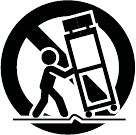
37
Istruzioni importanti di sicurezza
1. Leggere attentamente e conservare le istruzioni. Tenere conto delle avvertenze
e seguire attentamente le istruzioni.
2. Non servirsi dell’apparecchio vicino all’acqua (si applicabile).
3. Pulire unicamente con un panno bagnato.
4. Non bloccare le aperture deputate alla ventilazione (si applicabile). Installare
secondo le istruzioni del produttore. Non installare questa attrezzatura in
un’area confinata o “chiusa”, come ad esempio all’interno di uno scaffale o
simili, e mantenere buone condizioni di ventilazione. La ventilazione non deve
essere ostruita coprendo le aperture di ventilazione (si applicabile) con articoli
quali giornali, tovaglie, tende, ecc.
5. Non installare vicino a sorgenti di calore quali radiatori, diffusori di aria calda,
fornelli o altri dispositivi (inclusi amplificatori) che producono calore. Non
collocare fonti di fiamma libera quali candele accese sull’apparecchio.
6. Non aggirare lo scopo di sicurezza della spina polarizzata o da messa a terra
(si applicabile). Una spina polarizzata presenta due lame di cui una è più ampia
dell’altra. Una spina con messa a terra presenta due lame ed un terzo dente
per la messa a terra. La lama ampia o il terzo dente sono forniti per la vostra
sicurezza. Se la spina in dotazione non è adatta alla vostra presa, consultare
un elettricista per la sostituzione della presa obsoleta.
7. (Si applicabile) Proteggere il cavo di alimentazione in modo che non ci si
cammini sopra o che non rimanga impigliato, in particolare a livello della spina,
dei ricettacoli e del punto in cui esce dall’apparecchio.
8. Servirsi unicamente degli accessori specificati dal produttore.
9. Servirsi unicamente del carrello, supporto, treppiede, mensola o
tavolo specificato dal produttore o venduto con il dispositivo (si
applicabile). Se si utilizza un carrello, prestare attenzione al
momento di spostare l’insieme carrello-dispositivo per evitare
infortuni dovuti a rovesciamento.
10. Scollegare il dispositivo dalla corrente elettrica durante temporali con fulmini o
se inutilizzato per lunghi periodi.
11. Affidare la manutenzione unicamente ad apposito personale qualificato. La
manutenzione è necessaria nel caso in cui il dispositivo sia stato danneggiato in
qualsiasi modo, ad esempio per danni al cavo di alimentazione o alla spina, nel
caso in cui acqua o altri liquidi siano stati versati nell’apparecchio o in caso di
caduta di oggetti al suo interno, nel caso in cui il dispositivo sia stato esposto a
pioggia o umidità, non funzioni normalmente o sia stato fatto cadere.
12. (Si applicabile) Sorgenti di alimentazione: il prodotto va collegato unicamente a
sorgenti di alimentazione del tipo descritto in queste istruzioni per l’uso, o
come indicato sull’apparecchio.
13. Selettori di voltaggio interno/esterno (si applicabile): gli interruttori di selezione
del voltaggio interno o esterno, se presenti, devono essere unicamente
azzerati ed equipaggiati con una spina adeguata per il voltaggio alternato da
un tecnico della manutenzione qualificato. Non cercare di effettuare questo
tipo di operazione da soli.

38
14. Acqua e umidità (si applicabile): Questo prodotto deve essere mantenuto
lontano dal contatto diretto con liquidi. L’apparecchio non deve essere esposto
alla spruzzatura o al versamento dei liquidi, e gli oggetti che contengono liquidi,
come per esempio i vasi, non devono essere collocati sull’apparecchio.
15. Attenzione (si applicabile): pericolo dell’esplosione se la batteria è sostituita in
modo errato. Sostituire soltanto con lo stesso o il tipo equivalente. Le batterie
(un gruppo batterie o una batteria installata) non devono essere esposte a fonti
di eccessivo calore quali la luce diretta del sole, fuoco, ecc.
16. (Si applicabile) Quando una spina di rete o un accoppiatore dell’apparecchio
vengono utilizzati per scollegare il dispositivo, questi devono rimanere
accessibili e prontamente utilizzabili.
17. Terminale di protezione di messa a terra (si applicabile): l’apparecchio
deve essere collegato ad una presa elettrica dotata di un collegamento
a terra di protezione.
18. (Si applicabile) Questo simbolo indica che l’attrezzatura è un apparecchio
elettrico di classe II o a doppio isolamento. È stata concepita in modo tale
da non richiedere un collegamento di sicurezza a terra.
19. Attenzione (se applicabile): Prima di collegare la spina alla rete elettrica,
assicurarsi che la presa disponga di messa a terra. Inoltre, nel disconnettere la
connessione con messa a terra, assicurarsi di aver precedentemente
scollegato la spina dalla rete elettrica.
20. Questo apparecchio è stato concepito unicamente per un uso professionale.
Clima operativo previsto: tropicale, temperato.
21. (Si applicabile) Al momento di trasferire l’apparecchio o in caso di mancato
utilizzo dello stesso, fissare il cavo di alimentazione (ad es. avvolgendolo con una
fascetta serracavi). Prestare attenzione a non danneggiare il cavo di
alimentazione. Prima di riutilizzarlo, assicurarsi che il cavo non sia danneggiato. In
caso di danni a livello del cavo di alimentazione, portare l’apparecchio e il cavo
stesso ad un tecnico di assistenza qualificato affinché venga riparato o sostituito
come specificato dal produttore.
22. Avvertenza (si applicabile): un’eccessiva pressione audio (alto volume)
proveniente dalle cuffie può causare danni all’udito.
23. Avvertenza (si applicabile): fare riferimento a qualsiasi informazione
importante (ad es. in materia di collegamenti elettrici e sicurezza) stampata
sulla parte inferiore esterna dell’alloggiamento o sul pannello posteriore prima
di installare o utilizzare il prodotto.
Istruzioni di service
•Togliere l’apparecchio dalla presa prima della riparazione.
•Sostituire i componenti critici soltanto con pezzi di fabbrica o con pezzi
equivalenti raccomandati.
•Per le unità alimentate con corrente alternativa (AC): Prima di ritornare l’unità
riparata all’utilizzatore si deve utilizzare un ohmetro per misurare fra i due
connettori della spina di corrente alternativa (AC) e tutte le parti esposte
dell’unità. La resistenza dovrebbe essere di più di 2.000.000 Ohm.
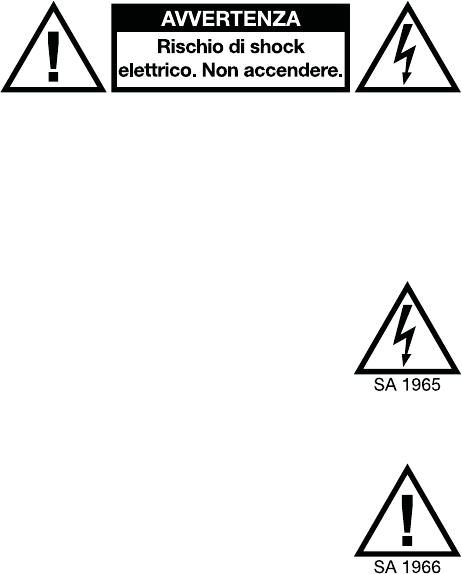
39
Precauzioni per la sicurezza
AVVERTENZA : PER RIDURRE IL
RISCHIO DI SHOCK ELETTRICO NON
SI DEVE SPOSTARE NESSUN
COPERCHIO. NON ESISTONO DELLE
PARTI UTILI PER L’UTILIZZATORE
NELL’INTERIORE. PER IL SERVICE
RIVOLGERSI SOLTANTO AL
PERSONALE SERVICE QUALIFICATO.
TENSIONI PERICOLOSE: Quando il pulsante con il simbolo di un lampo
terminato con una freccia nell’interiore di un triangolo equilatero è acceso,
esso avverte l’utilizzatore sulla presenza delle “tensioni pericolose” non
isolate dell’interiore della carcassa del prodotto e questo fatto può avere
una magnitudine sufficiente per costituire un rischio di shock elettrico.
ISTRUZIONI: Il punto esclamativo dell’interiore di un triangolo
equilatero ha lo scopo di avvertire l’utilizzatore sulla presenza di alcune
istruzioni importanti di funzionamento e di manutenzione (di service) di
questo dispositivo.
AVVERTENZA: Per ridurre il rischio di incendio o di scossa elettrica, non esporre
questo apparecchio alla pioggia o all’umidità. L’equipaggiamento elettrico non
deve MAI essere mantenuto o riposto in ambiente umido.
ESCLUSIVAMENTE PER MODELLI USA & CANADESI: PER PREVENIRE SCOSSE
ELETTRICHE NON UTILIZZARE QUESTA PRESA (POLARIZZATA) CON UNA
PROLUNGA, O ALTRE PRESE DI CORRENTE A MENO CHE LE LAMINETTE NON
POSSANO ESSERE INSERITE A FONDO EVITANDO DI RIMANERE ESPOSTE.
NOTA RIGUARDANTE PRODOTTI CHE IMPIEGANO RAGGI LASER: PERICOLO:
RAGGI LASER INVISIBILI IN CASO DI APERTURA DELL’APPARECCHIO E DI
GUASTO O DI ANNULLAMENTO DEGLI INTERRUTTORI. EVITARE L’ESPOSIZIONE
DIRETTA AL FASCIO. L’USO DI FUNZIONI O RIPARAZIONI NON DESCRITTE NEL
PRESENTE MANUALE È A RISCHIO DI ESPOSIZIONE A RADIAZIONI PERICOLOSE.
NOTA RIGUARDANTE LE REGOLAMENTAZIONI FCC: Quest’attrezzatura genera
e utilizza energia in radiofrequenza e può causare interferenze nella ricezione della
radio o della televisione nel caso in cui non venga utilizzata nello stretto rispetto delle
procedure specificate in questo manuale di istruzioni. Questa unità è conforme ai

40
limiti relativi ai dispositivi digitali di Classe B in conformità con le specifiche indicate
nel Capitolo J o Parte 15 delle Regolamentazioni FCC, designati al fine di fornire una
ragionevole protezione contro le interferenze dannose nelle installazioni domestiche.
Comunque, non esiste alcuna garanzia che le interferenze non si verificheranno in
un’installazione particolare. Se questa apparecchiatura causa interferenze dannose
alla ricezione della radio o della televisione, si consiglia di provare a ridurle utilizzando
una o più delle seguenti procedure: (a) riposizionare l’altra unità e/o la sua antenna,
(b) spostare questa unità, (c) aumentare la distanza tra i due apparecchi, (d) collegare
l’apparecchiatura alla spina utilizzando un circuito diverso da quello al quale è
attaccato l’altro equipaggiamento o (e) assicurarsi che tutti i cavi siano debitamente
schermati, servendosi di un dispositivo d’impedenza o di ferrite laddove appropriati.
Questa nota è conforme alla Sezione 15.838 delle Regolamentazioni FCC.
Dichiarazione FCC relativa all’esposizione alle radiazioni RF: 4XHVWD
DWWUH]]DWXUD q FRQIRUPH FRQ L OLPLWL SHU O¶HVSRVL]LRQH D UDGLD]LRQL VWDELOLWL GDOOD
QRUPDWLYD)&&SHUXQDPELHQWHQRQFRQWUROODWR0DQWHQHUHXQDGLVWDQ]DPLQLPDGL
FHQWLPHWULWUDODVWUXWWXUDLUUDGLDQWHGHOWUDVPHWWLWRUHHLOSURSULRFRUSRROHDOWUH
SHUVRQHQHOOHYLFLQDQ]H
Avvertenza ESD/EFT: Il prodotto può contenere un microcomputer per
l’elaborazione dei segnali e le funzioni di controllo. In occasioni
estremamente rare esso può bloccarsi a causa di interferenze intense,
di disturbi provenienti da una sorgente esterna o dell’elettricità statica.
In questi casi improbabili, spegnere il prodotto e attendere almeno
cinque secondi, quindi riaccenderlo.
Per garantire la migliore qualità audio, non utilizzare questo dispositivo in un
ambiente caratterizzato da un’elevata radiazione in radio-frequenza. In un
ambiente che presenta interferenze di radiofrequenze, l’apparecchio può accusare
un malfunzionamento e riprenderà il funzionamento normale in seguito
all’eliminazione dell’interferenza.
Questo apparecchio non eccede i limiti di Classe B nell’emissione di rumori radio
da parte di un apparecchio digitale, come dichiarato nelle regolamentazioni sulle
interferenze radio del Dipartimento Canadese delle Comunicazioni.
Per l’impiego a 220-volt negli U.K., utilizzare prese NEMA® da 220 volt. Per
l’impiego negli altri paesi utilizzare una presa idonea all’impianto locale.
Doppio isolamento: Per la manutenzione utilizzare solo parti di ricambio identiche.

41
Smaltimento corretto del prodotto: Questo simbolo indica che nell’Unione
Europea questo prodotto non deve essere smaltito insieme ai rifiuti
domestici. Per evitare possibili danni ambientali o alla salute causati da uno
smaltimento incontrollato dei rifiuti, riciclarli in maniera responsabile in modo
da promuovere il riutilizzo sostenibile delle risorse materiali. Per rendere il
dispositivo usato, servirsi degli appositi sistemi di reso e raccolta, oppure
contattare il rivenditore presso il quale è stato acquistato il prodotto. Questi
può ritirare il prodotto per garantirne il riciclaggio ecocompatibile.
Smaltimento delle batterie (se applicabile):
•Non smaltire mai le batterie gettandole nel fuoco né sottoporle a un calore
eccessivo o esporle alla luce diretta del sole. Le batterie surriscaldate si
possono fissurare o esplodere.
•In caso di dubbi su come smaltire le batterie, fare riferimento alle ordinanze
locali in materia per conoscere i luoghi e i metodi più adeguati, ecc.
•Batterie alcaline e batterie a bottone al litio: le batterie a bottone alcaline e
al litio possono essere smaltite in maniera sicura con i propri rifiuti domestici.
Non rappresentano un rischio per la salute o ambientale durante il normale
utilizzo o lo smaltimento. (Le batterie alcaline sono composte principalmente
da metalli comuni quali acciaio, zinco e manganese.)
Non gettare grandi quantità di batterie a bottone alcaline o al litio
contemporaneamente. Le batterie usate spesso non sono completamente
“esaurite”. Raggruppare batterie usate può portare queste batterie “vive” a
contatto l’una con l’altra, creando un rischio per la sicurezza. Per evitare ciò,
isolare ciascuna batteria con nastro o altri materiali non conduttivi per
garantire che non si scarichi.
Comprovati processi di riciclaggio economici e sicuri dal punto di vista
ambientale non sono ancora universalmente disponibili per le batterie a
bottone alcaline e al litio. Alcune comunità offrono servizi di riciclaggio o di
raccolta di tali batterie. Per maggiori informazioni, fare riferimento alle proprie
ordinanze locali o rivolgersi alla propria amministrazione locale.
•Batterie al piombo-acido: smaltire le batterie al piombo-acido portandole a
un centro di raccolta di rifiuti elettronici o presso un centro di riciclaggio,
oppure smaltirle in conformità con le proprie ordinanze locali. (Le batterie
ricaricabili al piombo-acido sono dello stesso tipo di quelle utilizzate nelle
automobili e devono essere smaltite in maniera simile.)
Nota generica in merito alla dichiarazione di
conformità: Con il presente documento si dichiara
che il dispositivo è conforme con i requisiti
essenziali contenuti nella Direttiva Europea
2014/53/EU. La dichiarazione completa di
conformità UE può essere richiesta all’indirizzo qui
riportato o marantzpro.com/safety
inMusic GmbH
Harkortstr. 12 - 32
40880 Ratingen
GERMANIA

42
Produktgarantie
(für Produkte, die außerhalb der USA erworben werden)
1. inMusic Brands, Inc. („inMusic“) garantiert dem Erstkäufer, dass Marantz
Professional („Marantz Pro“) Produkte vom Material und der Herstellung her
und bei normalem Gebrauch und Wartung beginnend mit dem Datum des
Kaufs von einem autorisierten Marantz Pro-Händler für eine dem Kaufdatum
folgende Zeit von einem (1) Jahr einwandfrei sind.
2. Diese eingeschränkte Garantie ist für den sachgemäßen Gebrauch des
Produktes durch den Käufer gültig.
Diese eingeschränkte Garantie deckt die folgenden Fälle nicht ab: (a) Defekte
oder Beschädigungen welche durch Unfall, unsachgemäßen Gebrauch,
Missbrauch, Nachlässigkeit, unübliche physische oder elektrische Kräfte,
Veränderungen eines Teils des Produktes oder Schönheitsfehler; (b) Geräte, bei
welchen die Seriennummer entfernt oder unleserlich gemacht wurde; (c) Kratzer
und Beschädigungen durch normalen Gebrauch aller Plastikoberflächen und
offen liegenden Teile; (d) Defekte oder Beschädigungen, welche durch
unsachgemäßes Testen, Betrieb, Wartung, Installation, Einstellung oder
Kundendienst des Produktes hervorgerufen wurden.
3. Innerhalb der rechtmäßigen Garantiezeit repariert oder ersetzt Marantz Pro,
bei völliger Entscheidungsfreiheit durch Marantz Pro, jegliches schadhafte
Bestandteil des Produktes ohne den Käufer finanziell zu belangen. Es steht im
Ermessen von Marantz Pro, rekonstruierte, überholte oder neue Teile oder
Bestandteile zur Reparatur eines Produktes zu verwenden, oder ein Produkt
mit einem rekonstruierten, überholten, neuen oder vergleichbar Produkt zu
ersetzen.
4. DIE GARANTIEN, WELCHE IN DIESER EINGESCHÄNKTEN GARANTIE
ENTHALTEN SIND, ZUSAMMEN MIT JEGLICHEN IMPLIZIERTEN
GARANTIEN, WELCHE DIE PRODUKTE VON MARANTZ PRO ABDECKEN,
INSBESONDERE AUCH UNEINGESCHRÄNKTE VERTRIEBSGARANTIEN
ODER VERWENDUNGSGARANTIEN, BESCHRÄNKEN SICH AUF DIE
LAUFZEIT DIESER EINGESCHRÄNKTEN GARANTIE. MIT AUSNAHME DER
VON ANZUWENDENDER RECHTSPRECHUNG UNTERSAGTEN
BESTIMMUNGEN IST INMUSIC ODER MARANTZ PRO NICHT
VERANTWORTLICH FÜR JEDWEDIGE SPEZIELLE, ZUFÄLLIGE, FOLGE-,
INDIREKTE ODER ÄHNLICHE SCHÄDEN, DEM VERLUST VON
EINKOMMEN, BESCHÄDIGUNG DES EIGENTUMS DES KÄUFERS, ODER
VERLETZUNG DES EIGENTÜMERS ODER ANDERER DURCH DEN
GEBRAUCH, MISSBRAUCH ODER SACHUNKUNDIGKEIT IM GEBRAUCH
EINES PRODUKTS VON MARANTZ PRO, GARANTIEVERLETZUNG,
NACHLÄSSIGKEIT, EINGESCHLOSSEN, ABER NICHT BESCHRÄNKT AUF
43
NACHLÄSSIGKEIT DURCH INMUSIC ODER MARANTZ PRO, SOGAR DANN,
WENN INMUSIC, MARANTZ PRO ODER DEREN VERTRETER ÜBER
SOLCHE SCHÄDEN BENACHRICHTIGT IN KENNTNIS GESETZT WURDE
ODER FÜR JEDWEDIGEN RECHTSANSPRUCH, WELCHER VON ANDEREN
PARTEIEN GEMACHT WIRD. DIESE EINGESCHRÄNKTE GARANTIE IST DIE
VOLLSTÄNDIGE GARANTIE FÜR ALLE MARANTZ PRO PRODUKTE UND
ERSETZT ALLE ANDERS AUSGEDRÜCKTEN GARANTIEN. DIESE
GARANTIE ERSTRECKT SICH AUF NIEMANDEN SONST ALS DEN
ERSTKÄUFER DIESES PRODUKTES UND REGELT DIE ABHILFE FÜR DEN
KÄUFER ABSCHLIESSEND. SOLLTE EIN TEIL DIESER EINGESCHRÄNKTEN
GARANTIE UNRECHTMÄßIG SEIN ODER VOM GESETZ HER
UNVOLLSTRECKBAR SEIN, BERÜHRT DIESE TEILWEISE
UNRECHTMÄßIGKEIT ODER UNVOLLSTRECKBARKEIT DIE
VOLLSTRECKBARKEIT DER RESTLICHEN GARANTIE NICHT, WELCHE,
DER KÄUFER ERKENNT DIES AN, WIRD IMMER ALS IN SICH SELBST
ODER DURCH GESETZESVORGABEN ALS EINGESCHRÄNKT AUSGELEGT
WERDEN.
Diese eingeschränkte Garantie teilt das Risiko des Produktversagens zwischen
dem Käufer und Marantz Pro, und die Produktpreisgestaltung von Marantz Pro
reflektiert diese Risikoaufteilung und die Einschränkungen der Verpflichtungen
welche in dieser eingeschränkten Garantie enthalten sind. Den Vertretern,
Beschäftigten, Groß- und Einzelhändlern von Marantz Pro ist es nicht gestattet,
Veränderungen dieser eingeschränkten Garantie vorzunehmen oder zusätzliche
Garantien, welche Marantz Pro oder inMusic verpflichten, anzufertigen. In diesem
Sinne stellen zusätzliche Aussagen wie Händlerreklame oder Präsentation, ob in
Wort oder Schrift, keine Garantien von Marantz Pro oder inMusic dar und sollten
nicht als Verlässlich behandelt werden. Einige Gesetzgeber erlauben den
Ausschluss oder die Beschränkung von zufälligen oder Folgeschäden oder die
Gültigkeitsdauer einer implizierten Garantie nicht, in diesen Fällen gelten die oben
gemachten Einschränkungen oder Ausschlüsse für den Kunden nicht. Diese
eingeschränkte Garantie gibt Ihnen bestimmte Rechte und sie haben
möglicherweise auch andere Rechte, welche örtlich unterschiedlich sind.
Bitte notieren Sie sowohl die Seriennummer Ihres Geräts wie auf der Rückseite
des Gehäuses angegeben als auch den Namen des Händlers, bei dem Sie das
Gerät erworben haben. Bewahren Sie diese Informationen und Ihren Kaufbeleg für
Ihre Akten auf. Besuchen Sie unsere Webseite marantzpro.com um Ihr Produkt
bei uns zu registrieren.
Modell: Gekauft von:
Seriennummer: Kaufdatum:
44
Informationen zur Rücksendung
•Sie müssen bei Ihrer örtlichen Niederlassung des Herstellers eine
Rücksendezulassungsnummer (RMA) einholen. Eine Liste von örtlichen
Niederlassungen finden Sie auf der Webseite marantzpro.com.
•Für das Gerät, welches unter Garantie zu reparieren ist, muß eine Kopie des
Originalverkaufsscheins beigelegt werden.
•Das fehlerhafte Gerät muß in seine Originalverpackung verpackt werden.
•Eine weitere Außenverpackung muß aus Gründen der Produktsicherheit
angebracht werden. Nachlässigkeiten können zu unzureichendem Schutz des
Produkts während des Transports und damit zur Gefährdung der
Garantierechte des Kunden führen.
•Marantz Pro akzeptiert keine COD-Lieferungen und Rückgabescheine zur
Rückgabe der Ware warden nicht ausgestellt.
•Marantz Pro schickt reparierte Waren an Kunden nicht durch Eilversand
zurück, es sei denn, der Kunde hat dies schriftlich verlangt und trägt die
Kosten. Anträge dieser Art müssen den zurückgesandten Waren beigelegt
werden.
•Das fehlerhafte Gerät sollte mit im voraus bezahlter Frachtgebühr und der
Rücksendezulassungsnummer (RMA) gut sichtbar auf der äußeren Verpackung
angebracht und unter Beilage des Originalverkaufsscheins an Ihre örtliche
Kundendienstniederlassung geschickt werden.
Sehr Wichtig
Lesen Sie bitte diesen Abschnitt, bevor Sie das Gerät an Ihr System anschließen.
Für optimale Leistungen:
•Alle Schieberegler unterstehen der Abnutzung. Übermäßige Kraftanwendung
kann zu einer vorzeitigen Abnutzung des Schiebereglers führen. Für durch den
Benutzer ersetzte Schieberegler kann keine Haftung übernommen werden.
•Benutzen Sie keine Sprayreiniger für die Schieberegler. Die Rückstände
verursachen die übermäßige Ansammlung von Schmutz und dieses wird Ihre
Garantie annullieren. Bei normaler Benutzung können Schieberegler viele Jahre
betriebsfähig bleiben. Bei unsachgemäßem Funktionieren (gewöhnlich wegen
schmutziger oder staubiger Umgebung) wenden Sie sich an einen Fachmann.
•Versichern Sie sich immer, dass der AC Power-Schalter in Position Off (aus) ist,
während Sie jedwelche Anschlüsse machen.
45
•Benutzen Sie passendes Leitungskabel in ihrem gesamten Stromnetz.
Benutzen Sie keine allzu langen Versorgungskabel (z.B. über 10 Meter / 32
Fuß). Versichern Sie sich, dass die Stecker fest in den Steckdosen
angeschlossen sind. Lockere Anschlüsse können Summen, Zusatzgeräusche
oder Unterbrechungen verursachen, die Ihre Lautsprecher sehr leicht
beschädigen können. Ein- und Ausgangsschlüsse sollten durch Stereokabel
mit niedrigem Wechselstromwiderstand (Kapazitanz) erfolgen. Kabelqualität
kann einen großen Unterschied in Klangtreue und -kraft ausmachen. Wenden
Sie sich an Ihren Marantz Pro-Händler oder an den Elektro- und Audio-
Fachhandel, um eine diesbezügliche Entscheidung zu treffen.
•Versuchen Sie nicht, irgendwelche sonstige Veränderungen oder Reparaturen
am Gerät zu unternehmen als jene, die in diesem Handbuch beschrieben sind.
Bringen Sie das Gerät zu Ihrem Händler oder zu einem autorisierten Marantz
Pro Service Center.
•Vergessen Sie nicht: Schalten sie Verstärker zuletzt ein und zuerst aus.
Beginnen Sie den Betrieb des Gerätes mit den Schiebereglern und
Lautstärkereglern auf Minimum und dem Verstärker-Input in niedrigster
Position. Warten Sie 8-10 Sekunden, bevor Sie die Lautstärke aufdrehen. Dies
verhindert Transiente, die zur Schädigung der Lautsprecher führen können.
•Betätigen Sie die Regler mit Vorsicht. Versuchen Sie, diese langsam zu
bewegen. Schnelle Bewegungen können das Gerät durch „clipping“
(„Abhacken“) des Verstärkers beschädigen.
•Vermeiden Sie ein „clipping“ des Verstärkers um jeden Preis: dies geschieht
wenn die roten LED-Anzeigen (gewöhnlich an der Vorderseite der meisten
professionellen Verstärker angebracht) zu blinken beginnen. Durch „clipping“
entsteht eine verzerrte Wiedergabe durch den Verstärker, der überfordert ist.
Verstärkerverzerrung ist die Hauptursache für Schädigung von Lautsprechern.
•Für die Vorbeugung von Brand oder Stromschlag stellen Sie das Gerät nicht im
Regen oder in feuchter Umgebung auf. Stellen Sie niemals Bierdosen, Soda,
Wassergläser oder sonstige nasse Gegenstände auf das Gerät!
•Die Ausgänge der Kopfhörer können auf Lärmpegel eingestellt werden, die Ihre
Ohren beschädigen können. Seien Sie vorsichtig!
• Dieses Gerät enthält einen Mikrocomputer für die Signalverarbeitung und die
Bedienfunktionen. In sehr seltenen Fällen können starke Interferenzen, Rauschen
von externen Quellen oder elektrostatische Aufladung Funktionsstörungen
hervorrufen. Schalten Sie das Gerät in diesem unwahrscheinlichen Fall aus, warten
Sie mindestens fünf Sekunden und schalten Sie das Gerät dann wieder ein.
•Wenn dieses Produkt beim Gebrauch elektromagnetischen Interferenzen
ausgesetzt ist, kann es in seltenen Fällen zu leichten Verlusten beim Signal-
Rausch-Verhältnis kommen.
•Bestimmungsgemäße elektromagnetische Umgebungen: Wohngebiete,
Gewerbegebiete, Leichtindustriegebiete, städtische Außenbereiche.
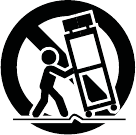
46
Wichtige Sicherheitsanweisungen
1. Lesen Sie diese Hinweise und heben Sie diese Hinweise auf. Beachten Sie alle
Warnhinweise und folgen Sie diese Hinweise.
2. Verwenden Sie das Gerät nicht in der Nähe von Wasser (falls zutreffend).
3. Verwenden Sie zur Reinigung ein trockenes Tuch.
4. Belüftungsöffnungen dürfen nicht verdeckt werden (falls zutreffend). Stellen
Sie das Gerät den Hinweisen des Herstellers folgend auf. Installieren Sie
dieses Gerät nie in engen oder abgeschlossenen Bereichen wie etwa in einem
Bücherregal oder ähnlichem. Sorgen Sie für gute Belüftungsbedingungen. Die
Belüftungsöffnungen (falls zutreffend) dürfen nicht mit Gegenständen wie
Zeitungen, Tischdecken, Vorhängen usw. abgedeckt und blockiert werden.
5. Betrieben Sie das Gerät nicht in der Nähe von Hitzequellen, wie Radiatoren,
Wärmegebläsen, Öfen oder anderen, Hitze produzierenden Geräten (wie
Verstärkern). Platzieren Sie keine offenen Flammen, wie eine brennende Kerze,
auf das Gerät.
6. Beseitigen Sie nicht die Sicherheitsvorkehrungen an den Stromversorgungen
(falls zutreffend). Das gilt insbesondere für die Erdung von
Kaltgerätenetzkabeln. Wenn ein Netzstecker oder ein Netzteil nicht in die
Steckdose passt, ziehen Sie einen Elektriker zu Rate.
7. (Falls zutreffend) Schützen Sie das Netzkabel vor unbeabsichtigtem Betreten
und vor Beschädigungen durch Einklemmen der Stecker, des Kabelmantels
und besonders der Stelle, an dem das Kabel das Gerät verlässt.
8. Verwenden Sie ausschließlich das durch den Hersteller zugelassene Zubehör.
9. Verwenden Sie nur Wagen, Ständer, Stative, Einbauhilfen oder
Tische, die vom Hersteller empfohlen werden oder die zu Ihrem
Gerät mitgeliefert werden (falls zutreffend). Bewegen Sie einen
Wagen, auf dem das Gerät steht, vorsichtig, um ein
Herabstürzen zu verhindern.
10. Trennen Sie die Stromverbindung des Gerätes während Gewittern oder wenn
Sie das Gerät eine längere Zeit nicht verwenden wollen.
11. Wenden Sie sich zu Servicezwecken an qualifiziertes Servicepersonal. Service
ist dann notwendig, wenn das Gerät in irgendeiner Art und Weise beschädigt
wurde. Dazu gehört zum Beispiel eine Beschädigung des Netzteils oder des
Netzkabels, in das Innere des Gerätes eingedrungene Flüssigkeiten oder
Gegenstände, Fehlfunktionen, nachdem das Gerät Regen oder Feuchtigkeit
ausgesetzt war oder wenn das Gerät nicht richtig funktioniert.
12. Stromquellen (falls zutreffend): Dieses Produkt sollte nur an eine in dieser
Betriebsanleitung beschriebenen oder einer auf dem Gerät gekennzeichneten
Stromquelle angeschlossen werden.
13. Interne/Externe Spannungswahlschalter (falls zutreffend): Schalter für die
interne/externe Spannung sollten, falls vorhanden, ausschließlich durch
Fachpersonal zurückgesetzt und mit entsprechenden Anschlusskabeln für
alternative Spannungsquellen versorgt werden. Versuchen Sie nicht, diese
Einstellungen selbst zu verändern.

47
14. Wasser und Feuchtigkeit (falls zutreffend): Dieses Produkt muss vor dem
direkten Kontakt mit Flüssigkeiten geschützt werden. Das Gerät darf nicht
bespritzt oder beschüttet werden und Gegenstände, die Flüssigkeiten enthalten,
wie etwa Vasen oder Gläser, sollten nicht auf das Gerät gestellt werden.
15. Vorsicht (falls zutreffend): Gefahr der Explosion, wenn Batterie falsch ersetzt
wird. Nur mit gleichen oder der gleichwertigen Art ersetzen. Die Batterien
(Batterie-Pack oder installierter Akku) dürfen nie zu starker Wärme durch
Sonneneinstrahlung, Feuer usw. ausgesetzt werden.
16. (Falls zutreffend) In Fällen, in denen der Hauptstecker oder ein Gerätekoppler
dazu verwendet werden, das Gerät auszustecken, müssen diese
Aussteckvorrichtungen weiterhin funktionstüchtig bleiben.
17. Schutzerdungsklemme (falls zutreffend): Das Gerät muss an eine
Netzsteckdose mit Schutzleiter angeschlossen werden.
18. (Falls zutreffend) Dieses Symbol gibt an, dass es sich um ein Gerät der
Schutzklasse II oder um ein doppelt isoliertes Elektrogerät handelt. Es wurde
so konzipiert, dass es ohne Sicherheitsverbindung zur Erde auskommt.
19. Vorsicht (falls zutreffend): Stellen Sie einen Erdungsanschluss her, bevor Sie
den Netzstecker in die Netzsteckdose stecken. Unterbrechen Sie den
Erdungsanschluss erst, nachdem Sie den Netzstecker aus der Netzsteckdose
gezogen haben.
20. Dieses Gerät dient dem professionellen Gebrauch. Beabsichtigtes Betriebsklima:
tropisch, mäßig.
21. (Falls zutreffend) Sichern Sie das Netzkabel, wenn Sie das Gerät bewegen
oder länger nicht benutzen (Verwenden Sie beispielsweise einen Kabelbinder).
Achten Sie darauf, das Netzkabel nicht zu beschädigen. Bevor Sie es wieder in
Betrieb nehmen, achten Sie darauf, dass das Netzkabel nicht beschädigt
wurde. Wenn das Netzkabel beschädigt wurde, bringen Sie das Gerät und das
Netzkabel nach Angabe des Herstellers zu einem qualifizierten Service-
Techniker zur Reparatur oder um ein Ersatzmodell anzufordern.
22. Warnung (falls zutreffend): Übermäßiger Schalldruck (hohe Lautstärke) von
Kopfhörern kann zu Gehörschäden führen.
23. Warnung (falls zutreffend): Bitte beachten Sie alle wichtigen Informationen (z.B. zu
Elektronik und Sicherheit etc.), die auf der Unterseite oder Rückseite des Gehäuses
angebracht sind, bevor Sie das Produkt installieren oder in Betrieb nehmen.
Serviceanweisungen
• Ziehen Sie das Anschlusskabel vor der Störungsbeseitigung aus der Steckdose.
•Ersetzen Sie die betroffenen Bestandteile nur mit Originalkomponenten
oder mit gleichwertig empfohlenen Ersatzteilen.
• Für mit Wechselstrom (AC) betriebenen Einheiten: Benützen Sie vor der Rückgabe
des reparierten Gerätes an den Benutzer ein Ohmmeter, um den Widerstand
zwischen den beiden Anschlüssen des Wechselstromsteckers und den Außenseiten
des Gerätes zu messen. Der Widerstand muss mehr als 2.000.000 Ohm sein.
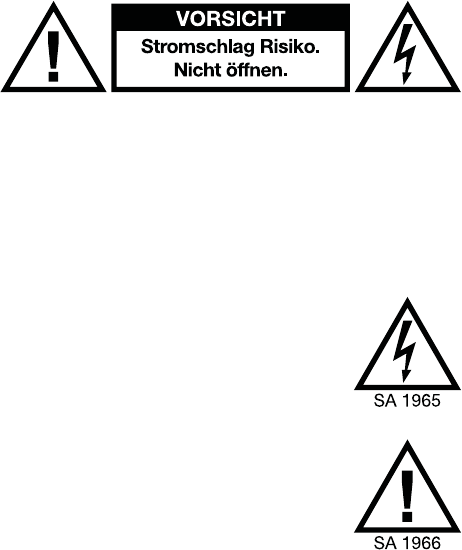
48
Sicherheitshinweise
ACHTUNG: UM DAS RISIKO EINES
STROMSCHLAGS ZU VERMINDERN,
ENTFERNEN SIE KEINE
ABDECKUNGEN. KEINE DURCH
BENUTZER WARTBARE
BESTANDTEILE ENTHALTEN. FÜR
WARTUNGSARBEITEN WENDEN SIE
SICH NUR AN QUALIFIZIERTES
SERVICE-PERSONAL.
GEFÄHRLICHER SPANNUNG: Das Symbol eines schwarzen Blitzes
innerhalb eines gleichseitigen Dreiecks soll den Benutzer vor unisolierter
„gefährlicher Spannung“ im Inneren des Gerätes warnen, die
gegebenenfalls kräftig genug sein, um einen Stromschlag zu verursachen.
ANWEISUNGEN: Das Ausrufezeichen inmitten eines gleichseitigen
Dreiecks soll den Benutzer auf wichtige Betriebs- und
Wartungsanweisungen aufmerksam machen, die in der Begleitbroschüre
dieses Gerätes enthalten sind.
WARNUNG: Um das Risiko von Feuer oder Stromschlag zu vermindern, setzen
Sie dieses Gerät nicht Regen oder Feuchtigkeit aus. Elektrische Geräte sollten
niemals in feuchten Umgebungen aufbewahrt oder gelagert werden.
NUR FÜR MODELLE IN DEN USA & KANADA: UM STROMSCHLAG ZU
VERMEIDEN; VERWENDEN SIE DIESEN (POLARISIERTEN) STECKER NICHT MIT
EINEM VERLÄNGERUNGSLKABEL, MEHRFACHSTECKDOSE ODER EINER
ANDEREN STROMQUELLE; ES SEI DENN, DIE STECKERZAPFEN KÖNNEN
VOLLSTÄNDIG EINGESTECKT WERDEN UM EIN FREILASSEN DES ZAPFENS
ZU VERMEIDEN.
HINWEIS IM BEZUG AUF LASER-PRODUKTE: GEFAHR: UNSICHTBARE
LASERSTRAHLUNG, FALLS DAS GERÄT GEÖFFNET WIRD UND INTERLOCK
AUSGEFALLEN IST ODER BETRIEBSUNFÄHIG GEMACHT WURDE. VERMEIDEN SIE
DIREKTE BESTRAHLUNG DURCH DEN STRAHL. DIE VERWENDUNG VON ANDEREN
ALS DEN HIER SPEZIFIZIERTEN BEDIENELEMENTEN ODER EINSTELLUNGEN KANN
GESUNDHEITSSCHÄDLICHE STRAHLUNG HERVORRUFEN.
HINWEIS IM ZUSAMMENHANG MIT FCC-VORSCHRIFTEN: Dieses Gerät
produziert und verwendet Radiofrequenzwellen und kann den Empfang von Radio
und Fernsehen beeinträchtigen, falls es nicht genau den in dieser Betriebsanleitung
geschilderten Verfahren zufolge betrieben wird. Dieses Gerät geht mit den Regeln der

49
Klasse B für Computer-Geräte konform, in Übereinstimmung mit den Spezifikationen
in Unterabschnitt J oder Teil 15 der FCC-Vorschriften, welche zum angemessenen
Schutz vor solchen Beeinträchtigungen in einer Wohngegend entworfen wurden. Es
gibt jedoch keine Garantie, dass eine Beeinträchtigung bei einer bestimmten
Installation nicht auftritt. Falls das Gerät den Empfang von Radio oder Fernsehen
beeinträchtigt, versuchen Sie, die Beeinträchtigung durch eine der folgenden
Maßnahmen zu vermindern: (a) Stellen Sie das Gerät an einen anderen Platz
und/oder richten Sie seine Antenne anders aus, (b) Stellen Sie dieses Gerät an einen
anderen Platz, (c) Vergrößern Sie den Abstand zwischen diesem und anderen
Geräten, (d) Stecken Sie dieses Gerät in eine andere Steckdose, so dass es sich in
einem von den anderen Geräten verschiedenen Stromkreis befindet oder (e) Achten
Sie darauf, dass Sie ein durch ein Eisendrahtnetz abgeschirmtes Kabel verwenden.
Dieser Hinweis ist im Einklang mit Abschnitt 15.838 der FCC-Vorschriften.
FCC-Strahlenbelastungserklärung: 'LHVHV *HUlW HQWVSULFKW GHQ )&&
6WUDKOHQEHODVWXQJVJUHQ]ZHUWHQ IU HLQH XQNRQWUROOLHUWH 8PJHEXQJ +DOWHQ 6LH
HLQHQ $EVWDQG YRQ PLQGHVWHQV FP ]ZLVFKHQ GHU VWUDKOHQGHQ 6HQGHUVWUXNWXU
XQG,KUHP.|USHUE]ZDQGHUHQ3HUVRQHQLQGHU1lKHHLQ
Dieses Gerät überschreitet nicht die Beschränkungen der Klasse B für
Radiogeräuschabgabe von digitalen Geräten beschrieben in den Radiostörvorschriften
des Kanadischen Kommunikationsministeriums.
ESD/EFT-Warnung: Dieses Gerät enthält einen Mikrocomputer für die
Signalverarbeitung und die Bedienfunktionen. In sehr seltenen Fällen
können starke Interferenzen, Rauschen von externen Quellen oder
elektrostatische Aufladung Funktionsstörungen hervorrufen. Schalten
Sie das Gerät in diesem unwahrscheinlichen Fall aus, warten Sie
mindestens fünf Sekunden und schalten Sie das Gerät dann wieder ein.
Für beste Tonqualität, dieses Gerät nicht in Bereichen mit hoher
Millimeterwellenstrahlung (RF-Strahlung) verwenden. In einer Umgebung mit HF-
Interferenzen kann es zu Fehlfunktionen des Geräts kommen. Werden diese
Interferenzen beseitigt, nimmt das Gerät den normalen Betrieb wieder auf.
Zur Verwendung mit 220 Volt in den U.K., benutzen Sie 220 Volt Stecker im NEMA®-
Stil. In anderen Ländern verwenden Sie die für die Steckdose passenden Stecker.
Doppelisoliert: Verwenden Sie bei der Wartung nur identische Ersatzteile.

50
Korrekte Entsorgung dieses Produkts: Diese Kennzeichnung gibt an, dass
dieses Produkt innerhalb der EU nicht mit anderem Haushaltsabfall entsorgt
werden soll. Recyceln Sie das Produkt verantwortungsbewusst, um mögliche
Schäden an der Umwelt oder der menschlichen Gesundheit durch
unkontrollierte Entsorgung zu vermeiden und um eine nachhaltige
Wiederverwertung von Materialressourcen zu fördern. Bitte nutzen Sie für die
Rückgabe Ihres Altgerätes entsprechende Rückgabe- und Sammelsysteme
oder kontaktieren Sie den Händler, bei dem Sie die Ware erworben haben.
Diese können das Produkt auf umweltfreundliche Weise recyceln.
Entsorgung der Batterien (falls anwendbar):
•Batterien niemals in Feuer oder in der Nähe von übermäßiger Hitze oder
direkter Sonneneinstrahlung entsorgen. Überhitzte Batterien können platzen
oder explodieren.
• Wenn Sie sich nicht sicher sind, wie und wo Sie Batterien entsorgen können,
lesen Sie die örtlichen Vorschriften für den richtigen Sammelplatz, Methode usw.
•Alkaline-Batterien & Lithium-Knopfzellen: Sie können Alkali- und Lithium-
Knopfzellen im normalen Hausmüll entsorgen. Bei normaler Verwendung oder
Entsorgung stellen sie keine Gesundheits- oder Umweltrisiken dar.
(Alkalibatterien bestehen hauptsächlich aus gewöhnlichen Metallen wie Stahl,
Zink und Mangan.)
Entsorgen Sie niemals eine größere Anzahl an Alkali- oder Lithium-
Knopfzellen als Bündel. Gebrauchte Batterien sind häufig nicht komplett leer.
Das Bündeln könnte diese nicht ganz leeren Batterien in Kontakt zueinander
bringen, wodurch Sicherheitsrisiken entstehen können. Um dies zu
vermeiden, isolieren Sie jede Batterie mit Klebeband oder anderem nicht
leitfähigem Material, um sicherzustellen, dass sie sich nicht entlädt.
Für Alkali- und Lithium-Knopfzellen sind allgemein noch keine kostengünstigen
und erwiesen umweltfreundlichen Recycling-Prozesse verfügbar. Einige
Gemeinden bieten Recycling oder Sammlung dieser Batterien an. Für weitere
Informationen sehen Sie in Ihren lokalen Verordnungen nach oder wenden Sie
sich an Ihre Lokalverwaltung.
• Blei-Säure-Batterien: Entsorgen Sie Blei-Säure-Batterien, indem Sie sie zur
Entsorgungs- oder Recycling-Stelle bringen oder entsorgen Sie sie gemäß örtlicher
Vorschriften. (Dieselbe Art von wieder aufladbaren Blei-Säure-Batterien wird auch
in Automobilen verwendet und sollten in ähnlicher Weise entsorgt werden.)
A
llgemeinhinweis zur Konformitätserklärung:
Hiermit erklären wir, daß sich dieses Gerät in
Übereinstimmung mit den grundlegenden
A
nforderungen der europäischen Richtlinie
2014/53/EU befindet. Die vollständige EG
Konformitätserklärung kann unter angeführten
A
dresse oder marantzpro.com/safety
angefordert werden.
inMusic GmbH
Harkortstr. 12 - 32
DE - 40880 Ratingen
51
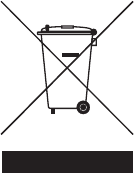
marantzpro.com
7-51-1418-C
World
Headquarters
U.K.
Office
Germany
Office
inMusic Brands, Inc.
200 Scenic View Drive
Cumberland, RI 02864
USA
Tel: 401-658-5766
Fax: 401-658-3640
inMusic Europe, Ltd.
Unit 3, Nexus Park
Lysons Avenue
Ash Vale
HAMPSHIRE
GU12 5QE
UNITED KINGDOM
Tel: 01252 896 040
Fax: 01252 896 021
inMusic GmbH
Harkortstr. 12 - 32
40880 Ratingen
GERMANY
Tel: 02102 7402 20150
Fax: 02102 7402 20011